I lived in Australia for a year, and while the sunny beaches and arid deserts are what everyone thinks of when they imagine Australia, the lush rainforests and rich landscape of Tasmania were something that awed and astounded me. It was a complete surprise. I never knew that such a place could be found in Australia. What surprised me most was that of all the travellers who visited Australia, only 2% of them visited Tasmania!
Tasmania is truly a spectacular place, and if you’re making a trip all the way out to Australia, you need to make time to fly over to this secluded island to experience all it has to offer. I thought you could easily spend a week here and have prepared a wonderfully rich and diverse week-long itinerary. If your trip is shorter, you can easily pick and choose your favourite parts of this tour to customize your own adventure.
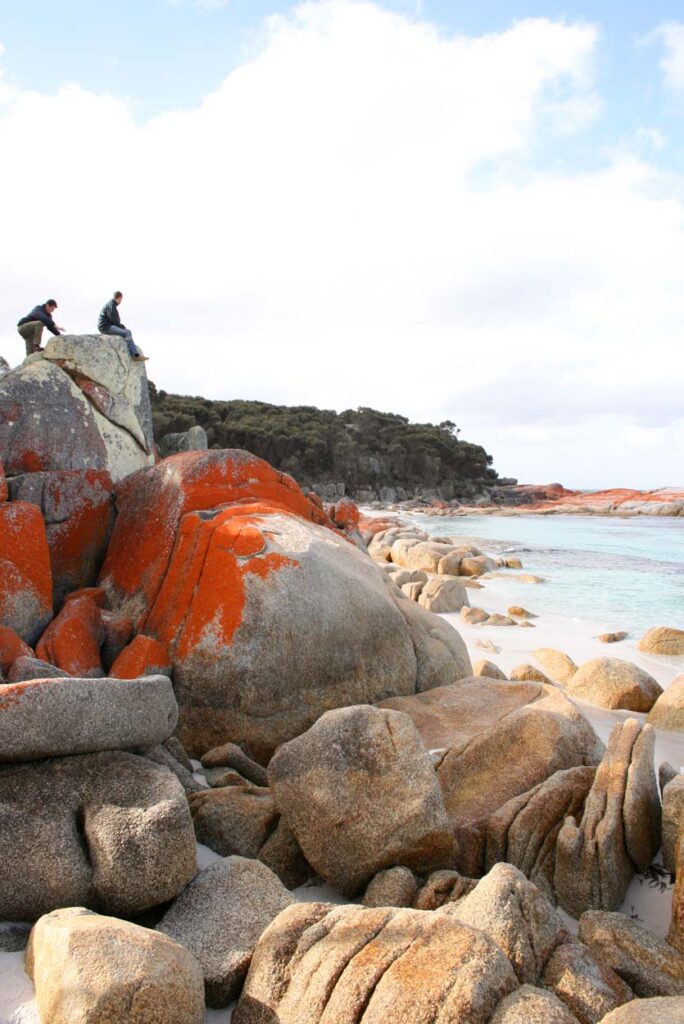
History
Tasmania is located 240 km away from the mainland of Australia. Tasmania is known as one of Australia’s “natural states” as 42% of its land is protected. This includes several national parks and gorgeous World Heritage sites. The native indigenous tribes, who inhabitated the country for over 30,000 years before colonization, are significantly different than the tribes on mainland Australia. Their unique traditions grew from their love and reliance on the waters which surround the island.
The British Arrival
The island was settled by Europeans in 1804. Britain saw that the French had been exploring the area and rushed to beat them to claim the land for England. They used the newly colonized island as a place to house the British Empire’s penal colony population. The island was initially called Van Diemen’s Land. It was named after Anthony van Diemen, the Dutch colonial governor who ruled in the 16th and 17th centuries. van Diemen had commanded naval explorations, and it was under his direction that the island was first discovered in 1642.
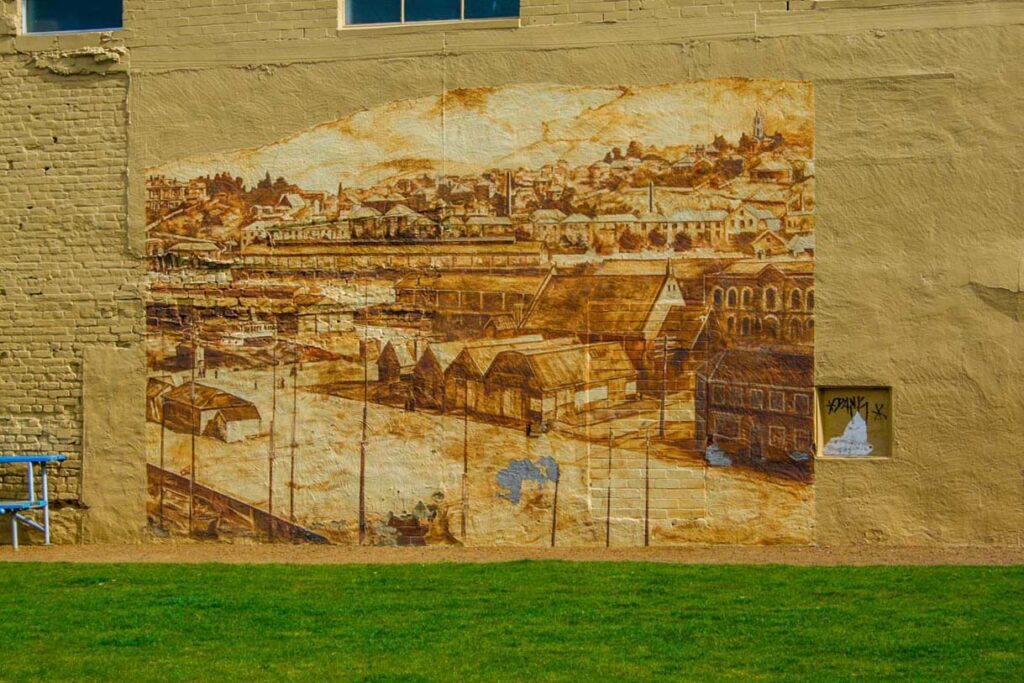
Free settlers from England began to arrive on the shores of Tasmania as they were promised free land grants as well as free convict labour. By 1825, over 75,00 convicts had been sent to Van Diemen’s Land. Many of them had finished their sentences and decided to start their new life here in the colony. Sadly, the British saw the indigenous tribes as their enemy and, over the years, massacred almost the entire population. By 1830 only 300 indigenous people were left on the island. Many of the few remaining indigenous people later died from the diseases introduced by the British to which they had no immunity. It’s heartbreaking to imagine how such a rich culture could be wiped out in such a short amount of time.
The Modern Age
In 1901, Tasmania joined with the five other Australian colonies to form the Commonwealth of Australia. After the closure of the penal colonies, the island’s main form of income was through whaling, fishing and most lucrative of all, mining. The mining industry dried up shortly after WWI. After this point, they began to focus on agriculture and the productions of fruits and vegetables. After WWII, many people started to immigrate to Tasmania as it was seen as the “Sanitorium of the South” as its quiet and zen-like natural environment was perfect for those seeking peace. This gave the population a little boost, but it still feels like a quaint island with extremely friendly locals happy to welcome tourists to their hidden gem in the ocean.
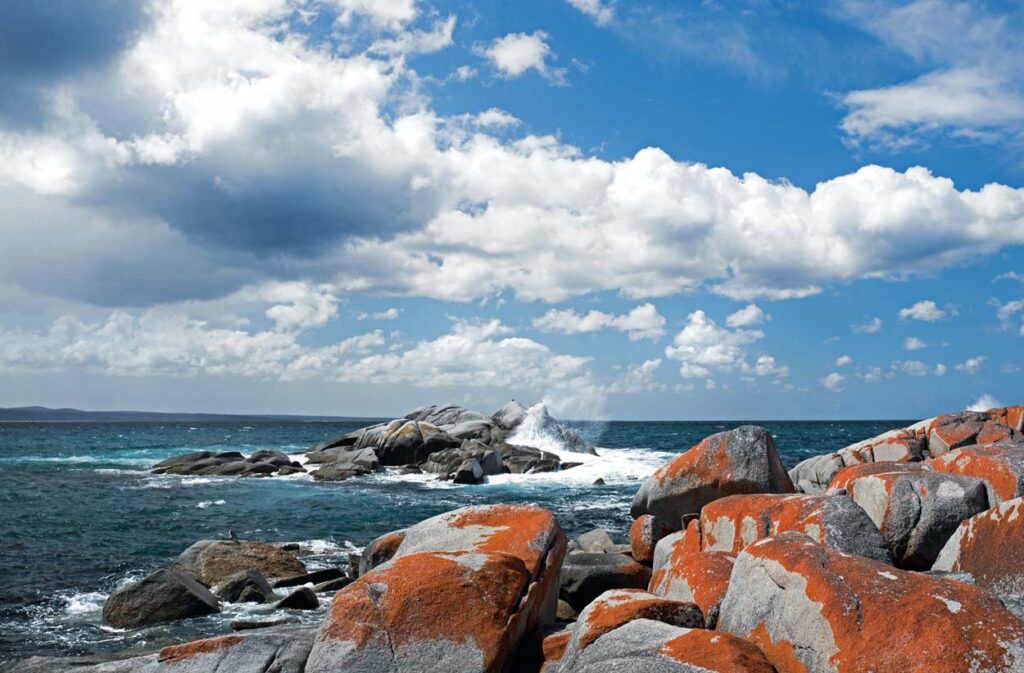
Travelling Around Tasmania
Rental Car
Tasmania is best traversed by car. Tasmania might be a big island, but it has a small population, so large-scale public transport is really lacking. So you’re the best option is to fly into Launceston (or Hobart) and rent yourself a car. Cars can be picked up in Launceston and dropped off in Hobart. Or vice versa if you prefer to reverse your trip. Car rentals in Tasmania can be as little as $96 USD a day.
Camper Van
Although a Camper Van is a much more costly experience, they also allow you to sleep anywhere you want. In a place as scenic as Tasmania, this is a real treat! The other plus with a camper van is that you have a kitchen wherever you go. This way you can easily stock up on groceries before you leave the big cities. You’ll never find yourself having a place to stop for something to eat. The downside obviously is the cost of gas. Another downside could be if you’re not familiar with driving a camper van. This can be a bit of a learning curve. Thankfully the roads in Tasmania are generally pretty empty. so you don’t need to worry about navigating through intense traffic.
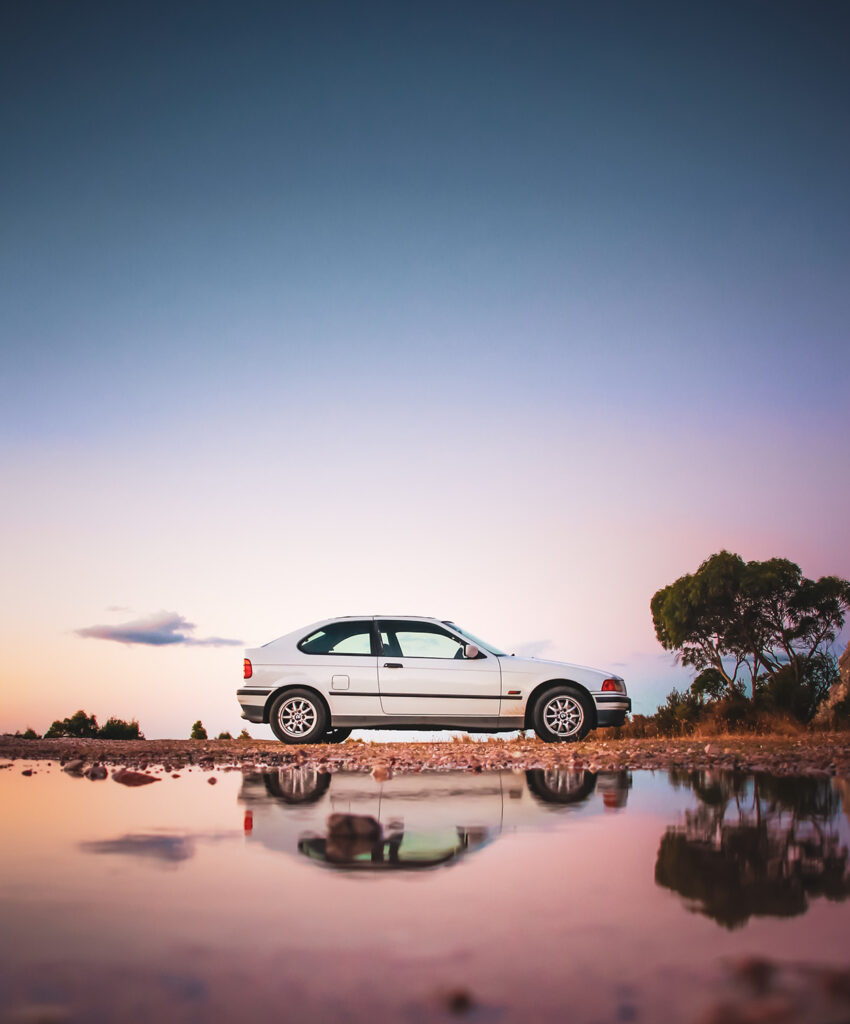
Cost of Gas
As of March 2021, gas prices in Tasmania were $1.40 Australian per litre. The trip mileage can vary greatly depending on how many detours you take along the way. But overall you should be covering around 800 km. But I would add even more since you are bound to make some detours along the way as you see things that catch your eye.
Notes on Food & Gas
Some of the areas we will travel through are very remote, so be sure to research before you head out for the day where your food and gas stops will be to ensure you’ll have enough before the next stop. A small fabric cooler will go a long way to keep your grocery food and drinks cold on your journey. I am always sure to keep a large bag of room temperature snacks with me as well. And always be sure you pack plenty of water.
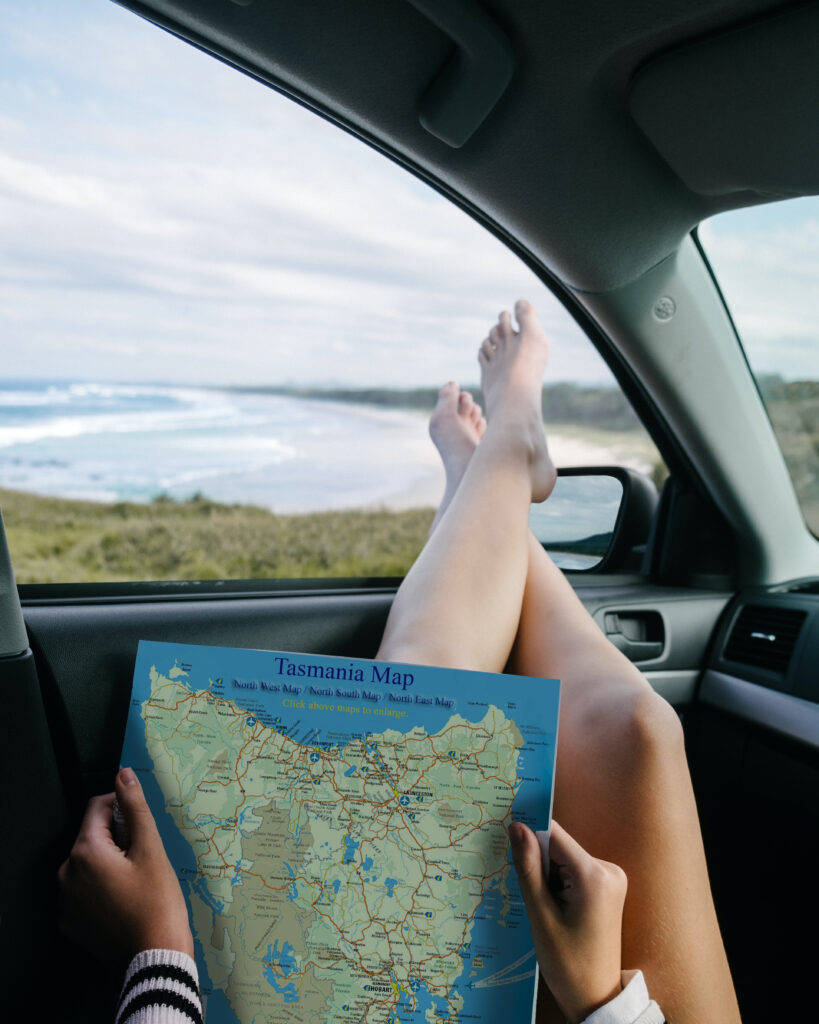
Bus Tour
If you can’t drive or don’t want the stress of driving yourself, you can always join a bus tour. One of my favourite companies is Under Down Under Tours. They offer a comparable 7-day tour of the island. It includes all your accommodations, pickups and drop-offs, and small group size. Also included in your booking are all the national park fees. Their tours do not include food, but they do stop at restaurants, cafes and takeaways along the journey. Also, if you opt to stay in a hostel accommodation, you can always use their kitchen for cooking upon arrival.
The best things about their tours is that they give you a choice of accommodations. They offer both hostel rooms as well as motel accommodation. And you can even get a cheaper price if you are a single traveller. This is such a great option. I’ve been in many a situation when I wanted to go on a group tour, but the accommodations were always double occupancy, and I was on my own.
Cost
The seven-day tour costs $800 USD per person for the hostel dorm rooms. $886 USD per person for a twin hostel room. And $1079 USD per person for a twin motel room.
When to Go?
Tasmania is noticeably colder than the rest of Australia. Don’t come here without checking the weather! We saw a few people step off the plane in shorts and t-shirts in a climate that was more suitable for a winter coat! November to March are the best months to travel when the weather is at its most enjoyable. June, July and August are relatively chilly and rainy. But the prices of hotels are significantly discounted during the rainy season, and the cities are almost empty of tourists! Summer is the peak travel season when you’ll find the hotels to be the priciest but that’s the price you pay (literally) for that beautiful weather.
Whereas international travellers might not find their way to Tasmania, local Australians have been frequenting the island more and more. Be sure to check the dates of any Australian holidays or school breaks as these times may also be much busier and more expensive.
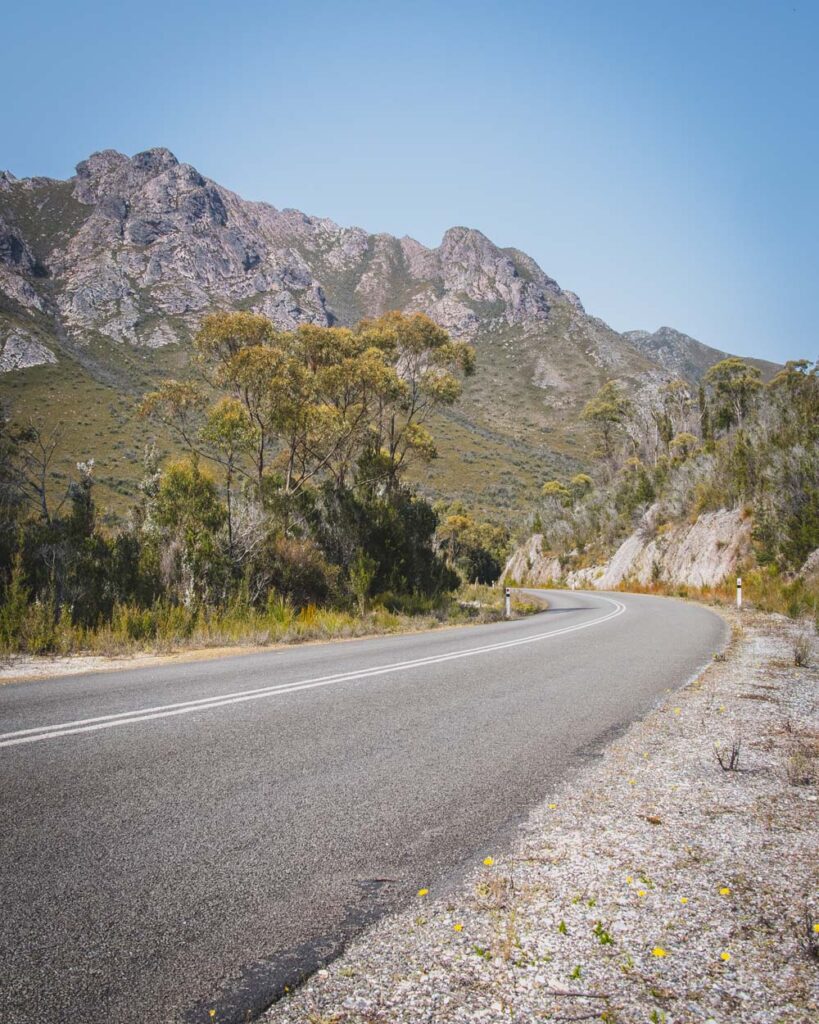
What to Pack?
As mentioned above, you might be surprised to see how different the weather is in Tasmania compared to the mainland. So much of Tasmania is made up of cool temperate rainforests. In addition to your regular travel essentials, there are a few critical items to bring to Tasmania. It’s crucial to pack lots of layerable clothes. These will help keep you warm in the morning, but you can shed them in the afternoon. Unless you going at the peak of the summer, be sure to pack a hat, scarf and gloves. Some of the high points in Tasmania are very windy and you’ll be happy to have the extra protection.
It’s also essential to pack a good raincoat or waterproof windbreaker. This will be super useful since rain is a frequent visitor to Tasmania’s forecasts. The rainforests can get pretty wet as well. Umbrellas are also a good thing to pack in your bag for extra protection. But a good raincoat with a sturdy hood is your best option. There are a few easy hikes in this guide, so while you don’t need professional hiking boots, a good pair of waterproof or water-resistant walking shoes is a must!
National Park Fees
A valid park pass is required for entry to all of Tasmania’s National Parks. Paying these fees individually can add up, so my best advice is to buy a Holiday Pass. You can buy the pass at the first park you visit. Holiday Passes are good for up to two months and cost $80 AUS ($61 USD). When you compare this to the $40 one-day pass, you can see why the holiday pass just makes more sense. You can also buy your pass online before you leave. This will save a few minutes when you enter the park, especially if it’s busy season.
How to Arrive
This tour is designed to go from Launceston to Hobart, but you can easily flip it the other way around. I lived in Syndey when I visited Tasmania, and it was a cheap 2-hour flight from Sydney. A direct flight costs $112 USD one way. If you are departing from Melbourne, flights are almost the exact same. Flying home from Hobart back to Sydney will run you a bit more since it’s a slight loner flight at $160 USD. But remember, these flights are always cheaper during the week. If you’re flexible with your timeline, keep this in mind.
Ferry
If you are departing from Melbourne, some people opt to take the ferry, dubbed the Spirit of Tasmania. This is the more popular option with local residents who wish to bring their own car along. A one-way journey on the ferry will cost around $90-100 USD for the lowest-economy recliner chair. Or you can opt for a a two-person cabin with a shower and window for $153 USD. The ferry journey is about 10 hours long and runs both during the day and at night. I can’t stand ferries since I get so sick-sea, but for people who love being at sea or who want to save on a night’s hotel, this is a great option!
Day 1 – Arriving & Exploring Launceston
I like starting my tours in Launceston. Launceston is such a dreamy place to visit and a great introduction to Tasmania. When you arrive in Tasmania, you can get a cab to your hotel, as the rest of the city is very easily accessible by foot and by public transport. You won’t need to start renting your car until you are ready to depart the city.
The first thing I NEED to do once I arrive, after even a short flight, is grab a cup of coffee. And just like the rest of Australia, which is known for its incredible coffee culture, and Tasmania is no different. Sweetbrew is a local hangout for hipsters and tourists alike. Every coffee is perfectly crafted, and their summer berry cake is something I’ll remember forever! Sit and relax here to soak in the atmosphere of this new city.
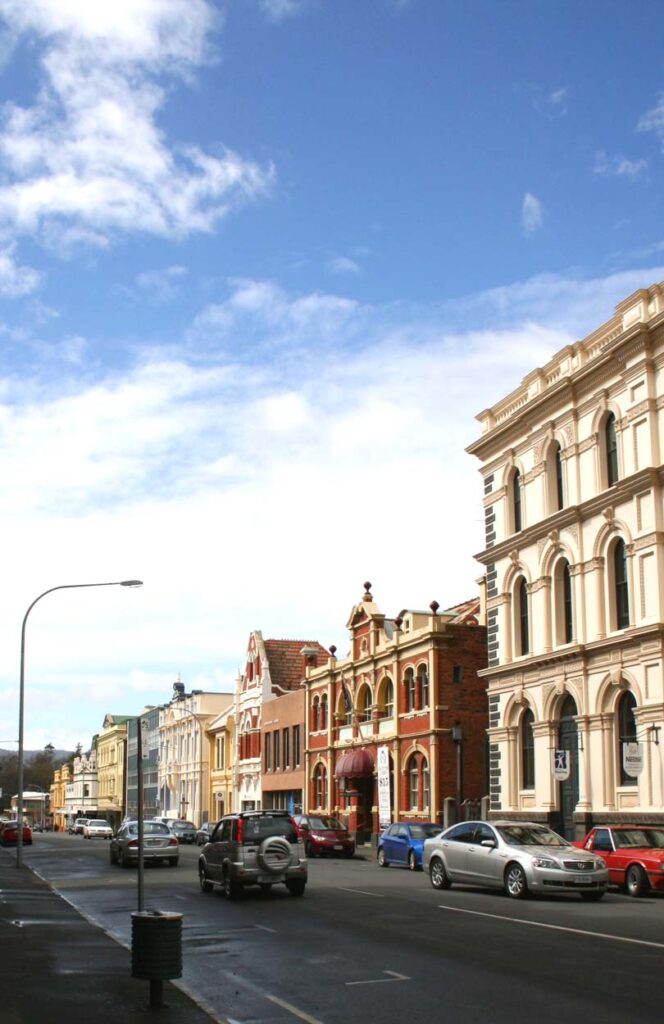
Explore Historic Launceston
After getting your bearings, and dropping off your luggage at your hotel, it’s time to head out and start exploring! Launceston, located on the northern tip of the state of Tasmania, is one of their two main cities. The other being Hobart, located on the southern end. Launceston is Australia’s third oldest European settlement, established in 1806 after Sydney (in 1788) and Hobart (in 1804). The city is renowned for its well preserved historic buildings. Launceston has some of the best colonial and Victorian architecture anywhere in Australia. Cameron street alone perfectly exemplifies what the rest of Australia would have looked like during the boom times of the 19th century.
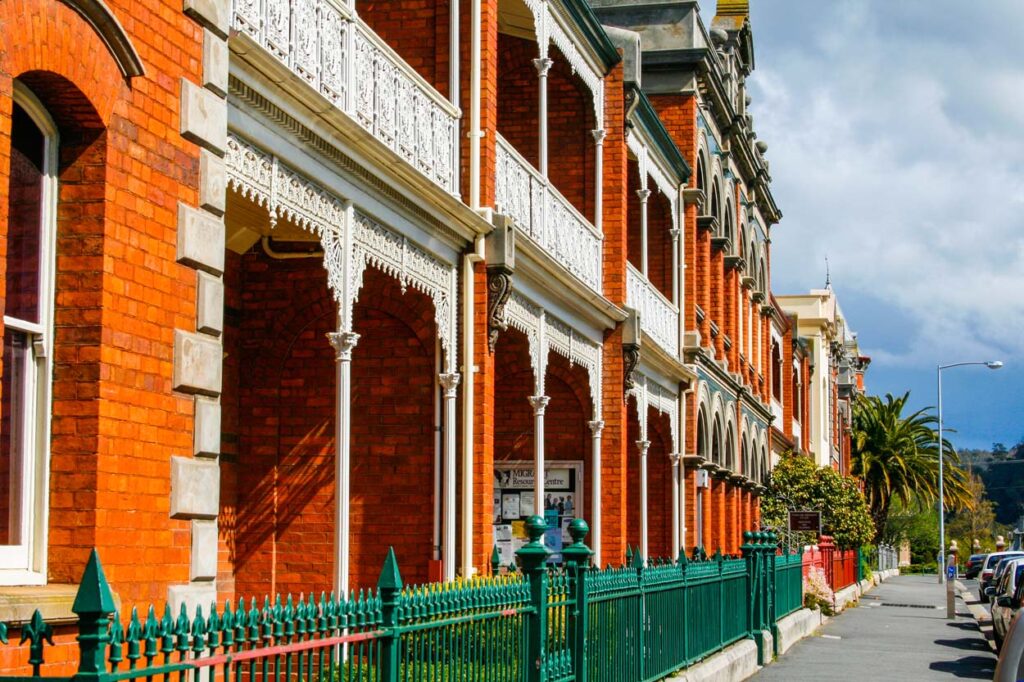
You can do your own self-guided walking tour from Albert Hall in the east to the Queen Victoria Museum and Art Gallery in the west. This tour focuses on specific buildings along the route that tell rich tales of the city’s architectural and social history. There are little plaques along the way to help inform you of the stories as you go. And it’s a great way to explore the city on foot.
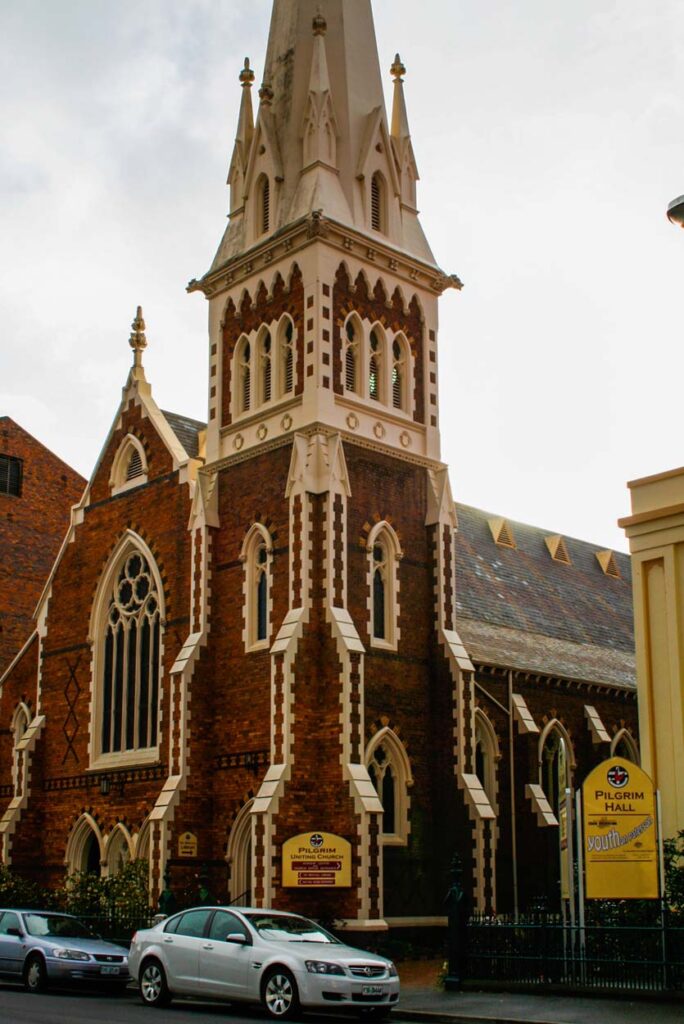
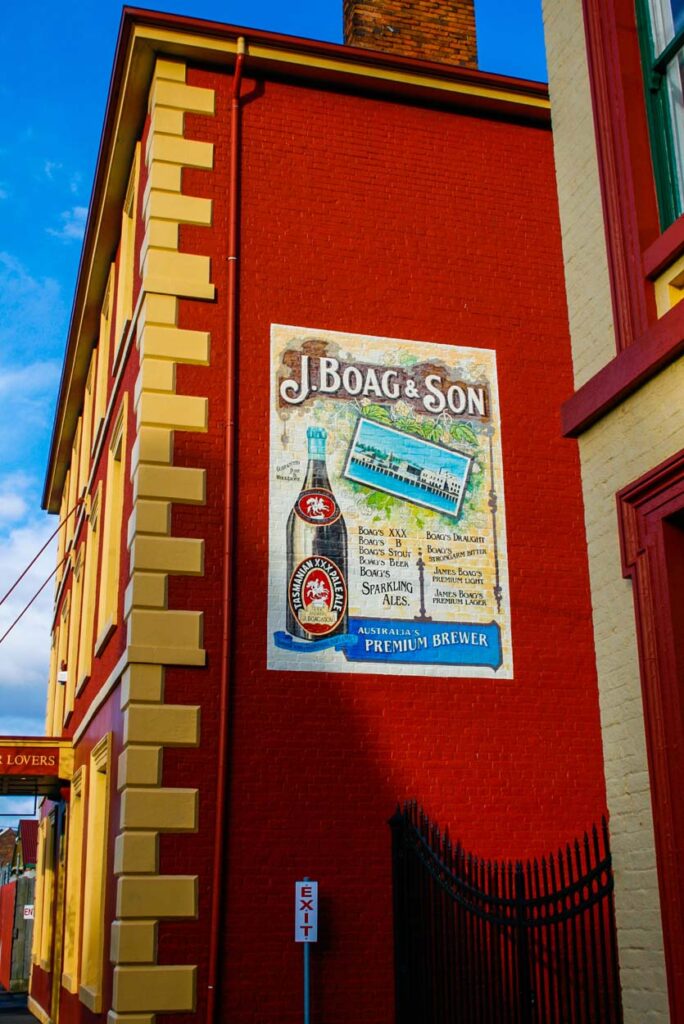
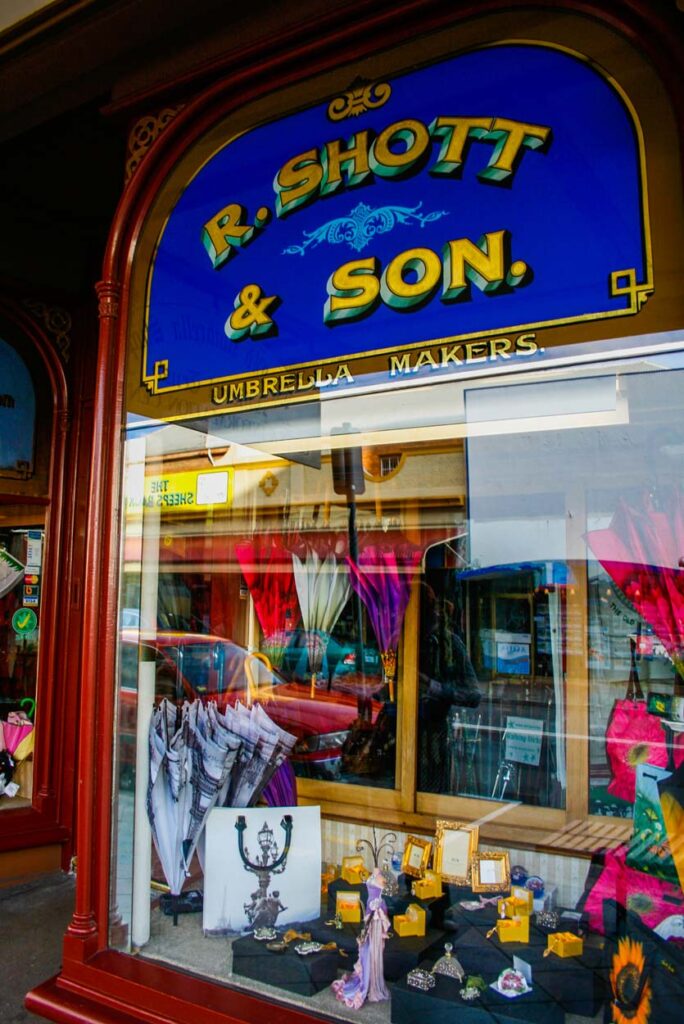
Sip on Aged Ales at James Boag Brewery Experience
Tasmania’s most famous beer is the Boags beer, which is sold worldwide but highly regarded in Launceston where the brewery is located. On the Brewery Tour experience, you’ll learn all about what makes their beer unique, see how its made and learn about the history of this Tasmanian Brewery.
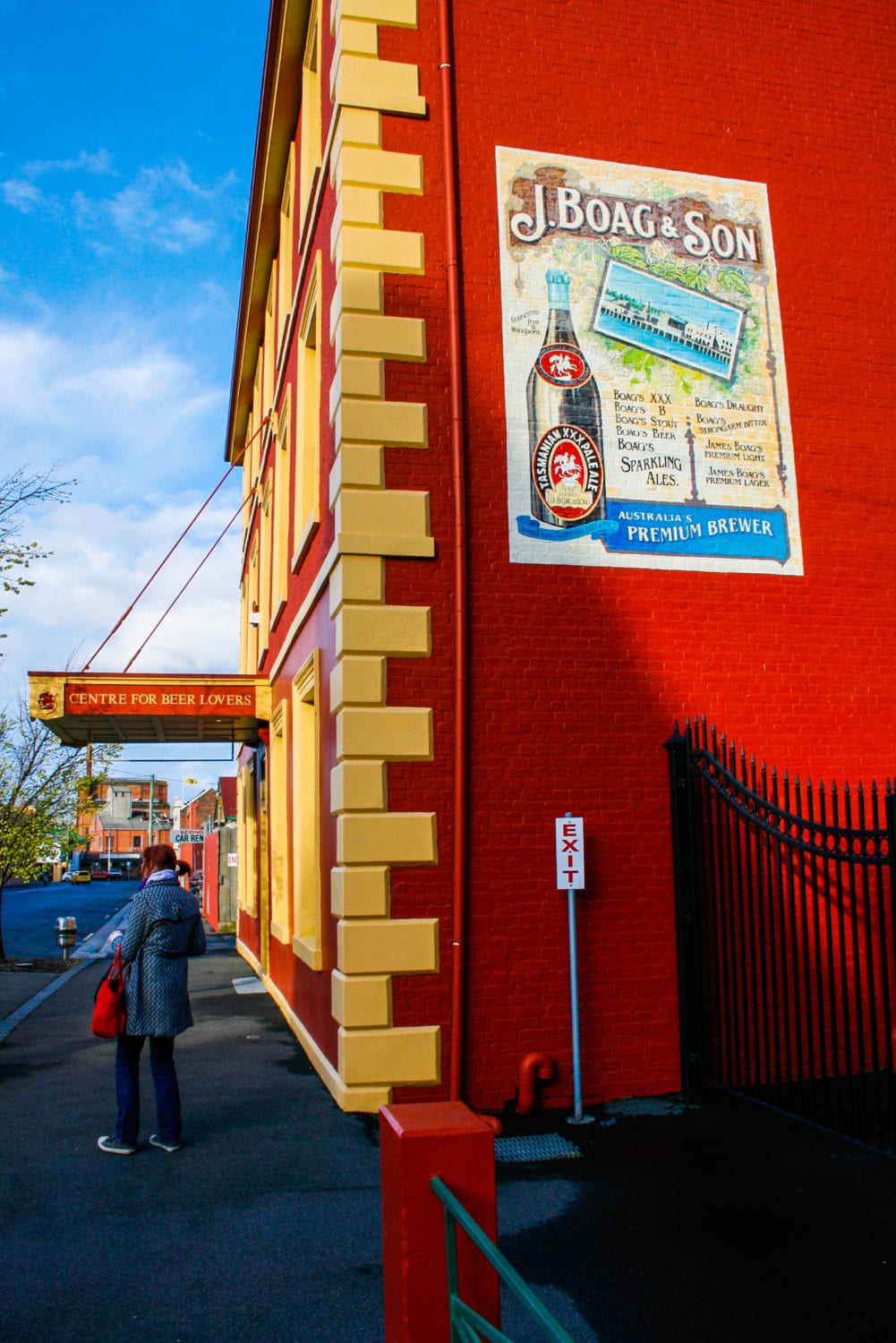
At the end of the tour, you’ll be invited into their bar where you’ll receive a 30-minute guided beer tasting! Here you’ll be able to taste a flight of their brews paired with locally produced cheese! I’ve been to many a beer tasting but never one which included cheese, so that captured my attention straight away (I’m a HUGE cheese lover) and I did think it really gave an interesting spin on the tasting.
Cataract Gorge
There is no better place to spend the afternoon than Cataract Gorge. Cataract Gorge is a stunning park in the centre of Launceston. To get to the gorge, you begin by walking along a scenic pathway called the King’s Bridge-Cataract Walk. This leads you around the South Esk River’s edge to the northern part of the gorge’s basin. From here, you can walk across the Alexandra Suspension Bridge. On the other side of the bridge, you’ll find a large swimming pool to be enjoyed in the summer months.
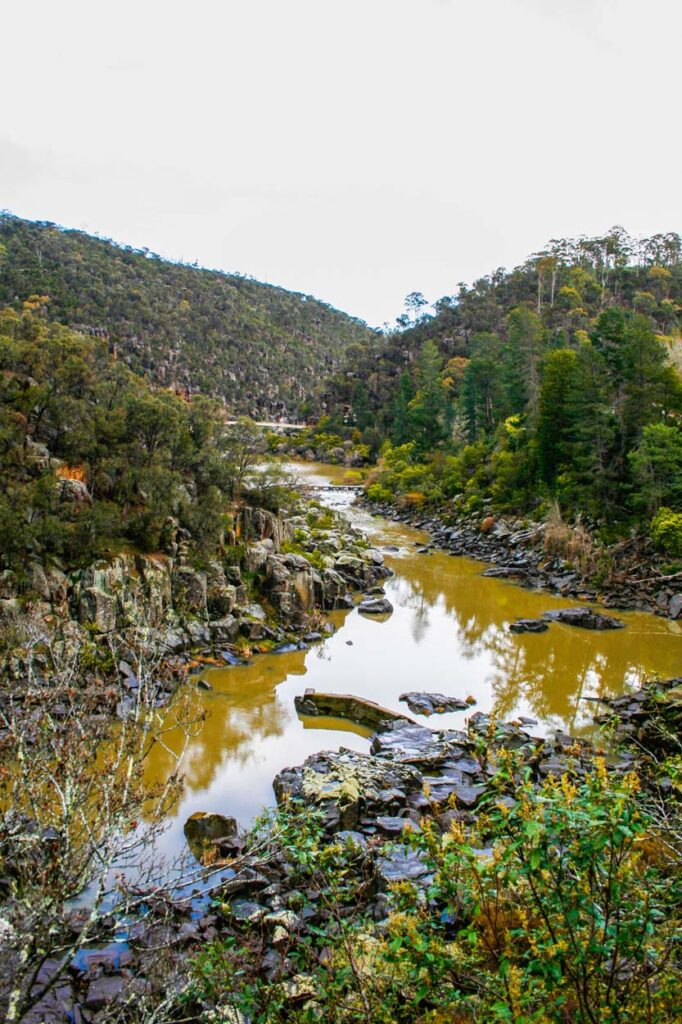
Gorge Scenic Chairlift
The Gorge Scenic Chairlift is one of the best parts of your visit to the gorge. This antique chairlift was built in 1972 and is still the longest single-span lift in the world! We were one of the only people in the park during our visit and figured the lift wouldn’t be open. But to our surprise, a quiet old woman was sitting at the desk to welcome us in and let us ride. It felt almost strange, like they had kept it open just for us. We giggled the entire way across the gorge, swinging our feet, nervously laughing as the chairlift climbed higher and higher. The chairlift crosses 457 metres and moves pretty slowly for you to really take in the scenery around you.
The trip costs $9 USD for a one-way ticket or $12 USD for an “Across & Back” ticket. We opted for the one-way since we enjoyed the walk back to the entrance. The lift is open every day from 9 am, 365 days a year! In the winter it closes at 4:30 pm, in the Spring and Autumn it closes at 5 pm and in Summer from 5:30 pm to 6 pm.
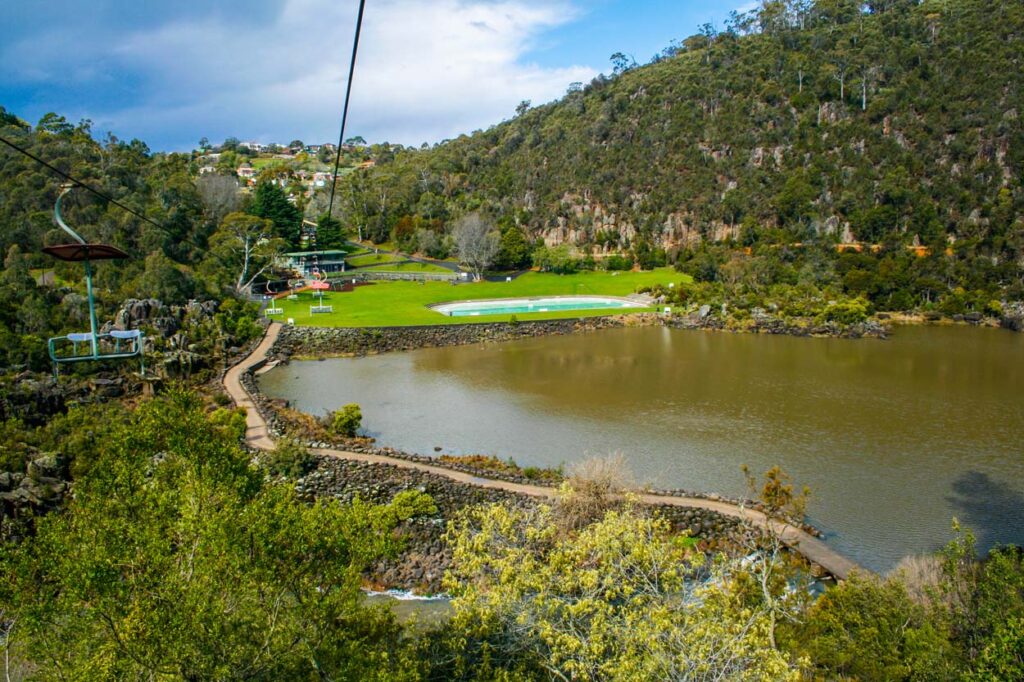
When you get off the chairlift, you can explore the Victorian garden and small cottage restaurant on the other side of the basin. You’ll find unusual Tasmanian flora and fauna, including ferns, exotic plants, and even wild peacocks covering the entire hillside.
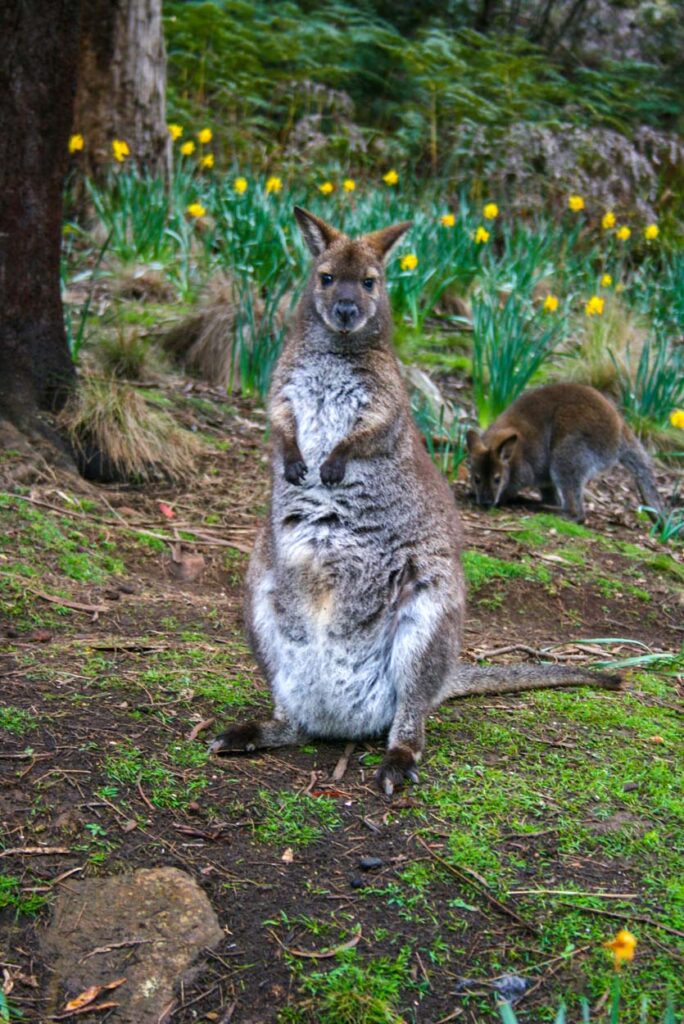
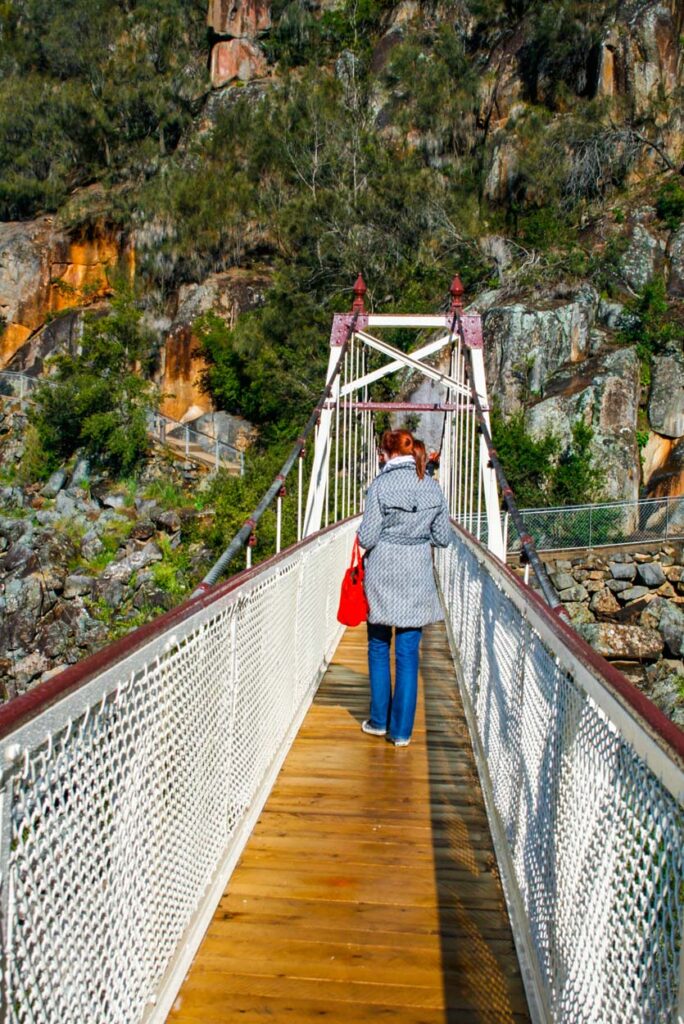
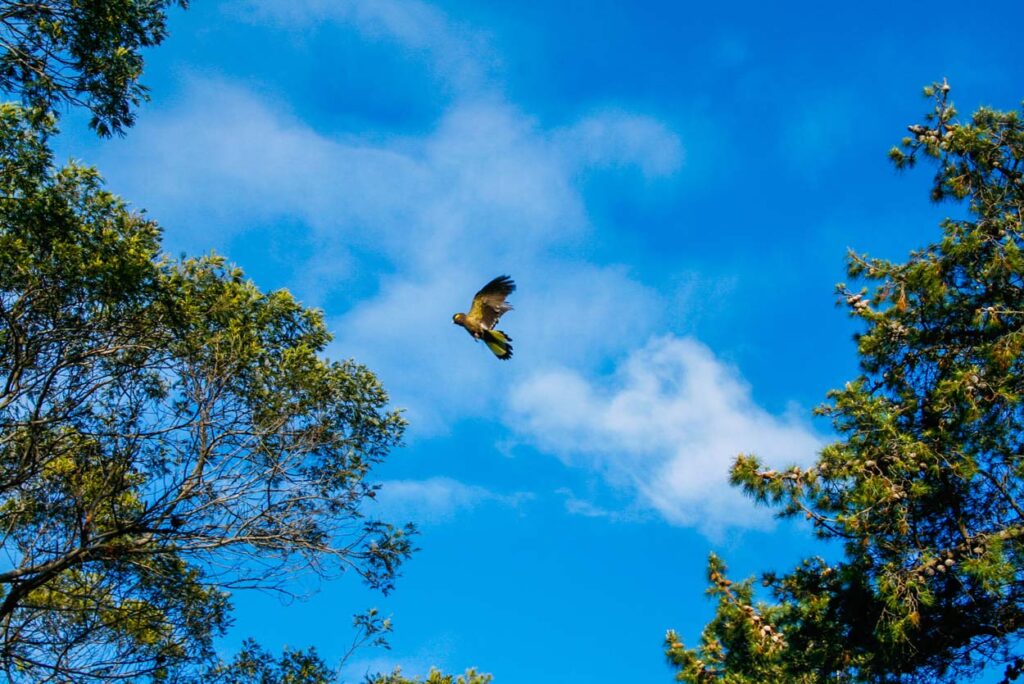
Get Spooked on Launceston City Ghost Tours
To end your evening I would highly recommend that a ghost tour! Ok, now I know ghost tours might seem like something kinda cheesy, but I LOVE them. To me, they are just like a history tour but with a slightly macabre angle. Launceston has a deep and dark convict past. It’s said that some of the prisoners who were sentenced here can still be seen roaming the streets, their ghosts clinging to the mortal world. Walking the old streets of Launceston, your guide will tell tales of the past, making the city’s history come alive. There is both an adult-only and family-friendly option, so there is something for all ages! Obviously the family-friendly tour is a little less scary so if you spook easily that might be the tour for you.
Day 2 – Road to the Bay of Fire
After a relaxing first day exploring the city of Launceston, it’s time to head out onto the road! The area we’re heading into doesn’t have almost any restaurants or even fast-food stops along the way so be sure to pack some food before you leave Launceston. And remember to bring lots of water!
Grindelwald
Just 20-minutes outside the city is the city of Grindelwald. Grindelwald Tasmania is a minature replicate of the Swiss village of Grindelwald. The charming little town is located in the scenic Tamar Valley. Driving through this beautiful valley is such a fantastic way to introduce yourself to the Tasmanian landscape. But Grindelwald isn’t a theme park; it’s a real neighbourhood where real families still live. The concept to recreate this place began in the 1980s as a unique take on suburban residential developments.
The idea came about from a Dutch immigrant named Roelf Vos. To re-create the Swiss village, they built the houses using classic Swiss architecture and added sweet details like balcony rails in the shape of tulips and scalloped-wooden eaves. Plus there is even an Alpine-themed restaurant and shopping center. If you didn’t grab a coffee on your way out on the road, I would recommend stopping by Missasippy Cafe near the Alpenrose Bistro & Bar. If for nothing else but to enjoy the almost theme park-esque stylings of the minature town square.
Batman Bridge
From Grindlewald, travel north along highway C733 that travels along the scenic River Tamar. Although named “the Tamar River” on the map, its proper indigenous name is actually ‘kanamaluka.’ And despite being called a river, it’s actually tidal estuary. While driving along the water’s edge might be a little less direct, the views you get of the landscape are just spectacular. It’s lovely to enjoy this scenery before heading into the dense forests.
Eventually, we make our way East, crossing over the Batman Bridge. Yes, that’s right, ‘Batman’ Bridge. Sadly, the bridge isn’t named for the famous cartoon hero but after John Batman, a Launceston businessman and co-founder of Melbourne. Built in 1966, the bridge was actually the first cable-stayed bridge in Australia and one of the first of its kind worldwide! If there’s not too much traffic as you cross, be sure to take it slow and enjoy the incredible view from up there across the valley.
Hillwood Berries
Once you’ve crossed over the bridge, continue down highway C727 towards Hillwood. Hillwood is a tiny town famous for its agriculture. Tasmania is known for being one of the most prolific producers of fresh berries in Australia. George Peacock set up the first Tasmanian jam manufacturing company in Hobart in 1850. Tasmania was the ideal climate for growing berries. When Peacock arrived in the new colony in Tasmania, there was a wealth of open fields to establish farms. Although the Peacock company has since closed, the farms growing berries across Tasmania continue to produce a wealth of these incredible fruits.
One such place you can visit is Hillwood Berries. The farm is open for “pick-your-own berries” from November to March. Berry picking is an excellent activity if you need to stretch your legs and allows you to enjoy the natural environment around you. Picking a small box doesn’t take long either, so it’s a short activity. But they also have prepackaged berries if you need a snack for the road. They also have a small cafe and grocery store inside with unique local products, delicious savoury pastries, and decadent desserts. I always am sure to pick up little snacks and portable meals whenever I can at places like this. This way, I’m sure to have food with me even when there isn’t anywhere to stop later in the day. If you want to grab a to-go lunch, you can eat it at the picnic area at our next stop.
Lilydale Falls
From Hillwood Farms, we begin our journey into the interior of Tasmania. The landscape almost immediately seems to change. The river disappears and the road winds through hilly valleys covered in eucalyptus trees. The tall mountains and hillsides rolling up and down by your window as you drive.
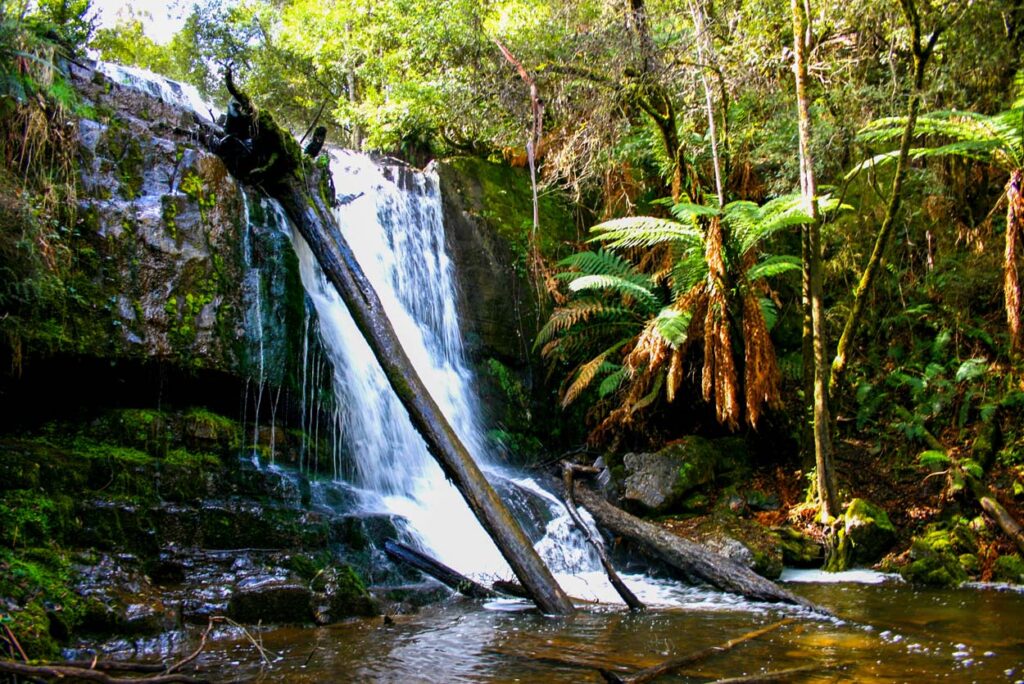
One of the more undiscovered hiking trails along our route is the Lilydale Falls Reserve. The first waterfall on the trail is found just 10-minutes from the parking lot. Other hiking trails might be more rigorous, but this one provides such a beautiful view after only a short walk. Along the way, you’ll be able to spot Tasmania’s tall eucalyptus trees and lush fern-covered landscape. The trail passes by two little waterfalls. While they aren’t immensely tall, there is something about the coziness of the scenery and ease of the trail that makes visiting them so enjoyable. The rest area near the car park is a great place to picnic and use the restrooms.
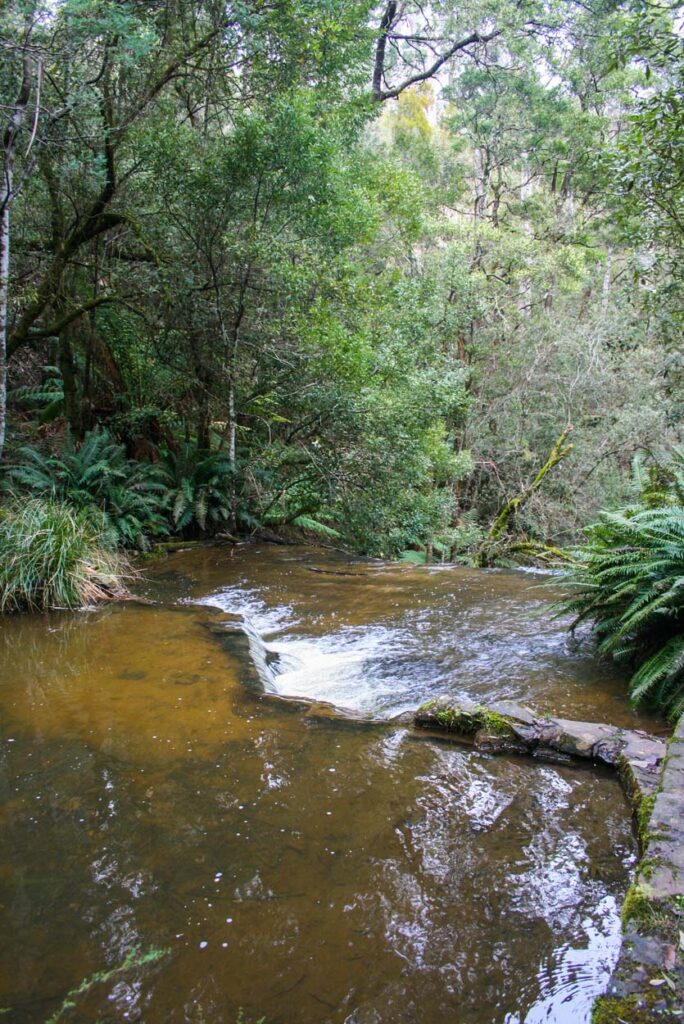
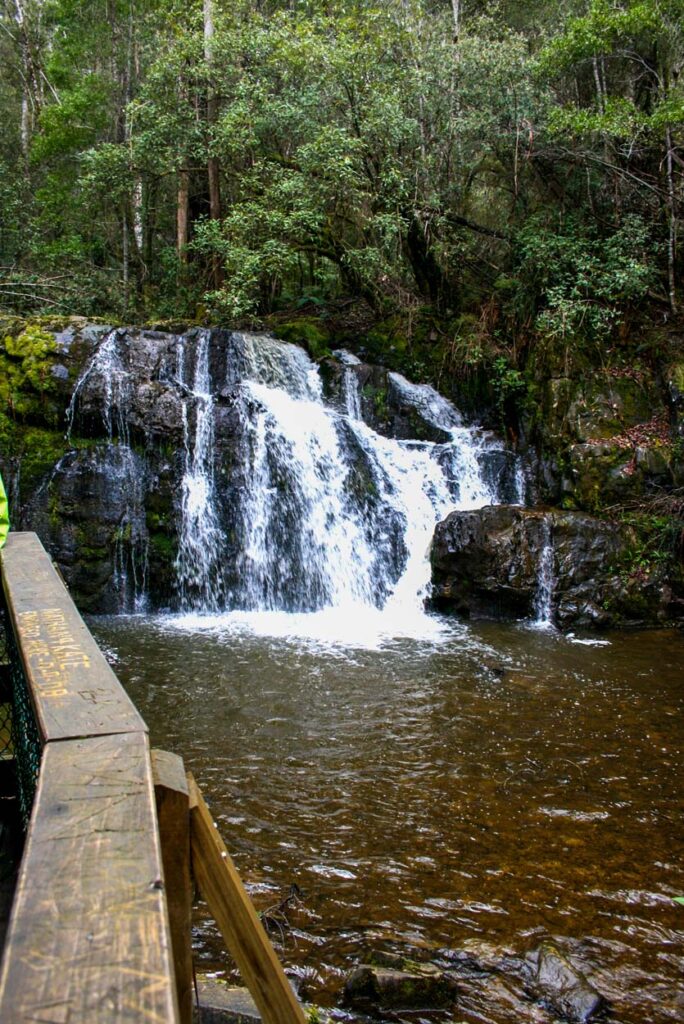
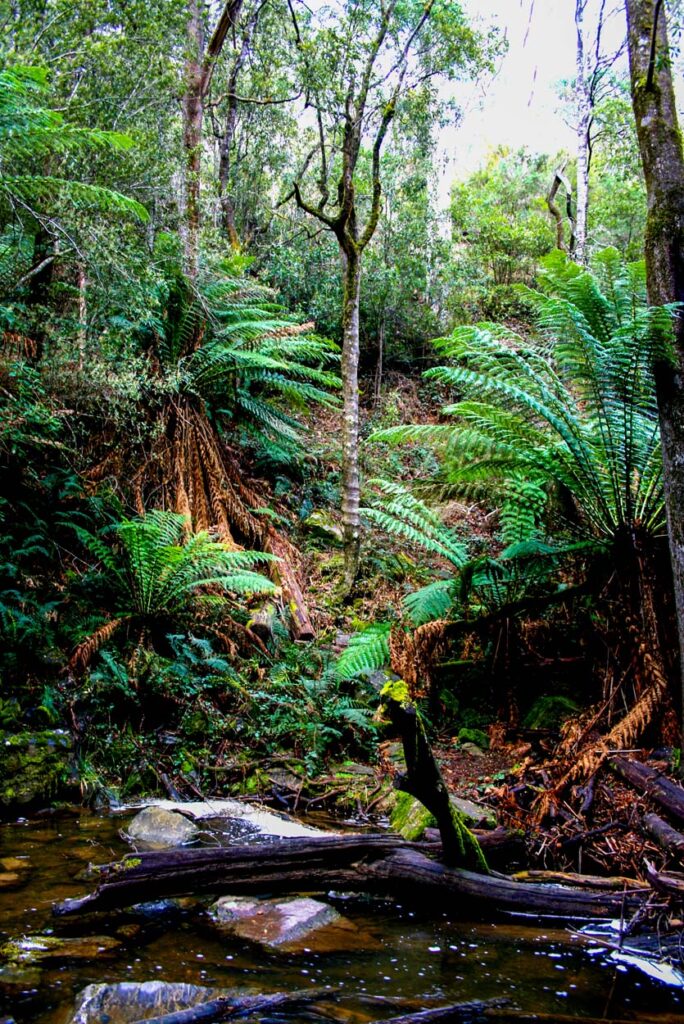
Bridestowe Lavender Estate
Continuing along highway B81, head slightly northeast towards Bridestowe Lavender Estate. This farm is home to great waves of lavender fields. The lavender generally blooms from December through to early February, but their website has more up-to-date information. During the rest of the year, you are free to wander the fields and view the other native vegetation. There are even self-guided tours to learn more about the history of Bridestowe.
Their shop is a great place to buy local Tasmanian lavender products. They also have a cafe/restaurants where you can dine and try some of their iconic lavender flavoured ice creams. If you don’t have an interest in seeing the lavender fields when they’re not in bloom, you can always skip this destination and just go directly to our next stop.
Legerwood Memorial Tree Forest
Along the road towards the eastern part of the island is the Legerwood Memorial Tree Forest. In 1918, after the first World War, several great trees were planted by the remaining family members of honoured Tasmanian fallen soldiers. Almost a hundred years later, the trees grew so large they were thought to be a danger to the community and were set to be torn down. But the community was devastated as the trees were so important to the historical legacy of Tasmania and their township.
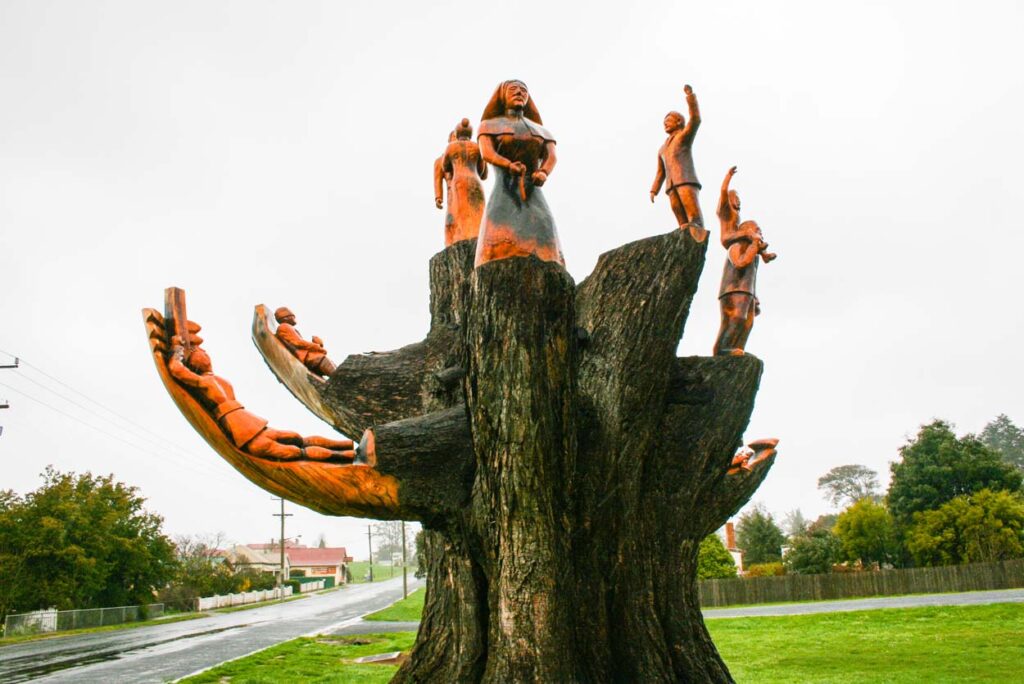
Instead of just uprooting them, the stumps of the trees were turned into sculptural memorials. Each stump was carved to represent a poignant scene from the first world war. Other trees were carved in the memory of the soldier to whom the tree was dedicated to. While the sculptures are very rudimentary and made by untrained artists, I love the fact that the community came together to ensure the memory of these soldiers lived on. Some art doesn’t need to be high brow. Some art is more about expression and walking through this grove of trees; I feel like you really get a sense of the impact the war made on even this little village.
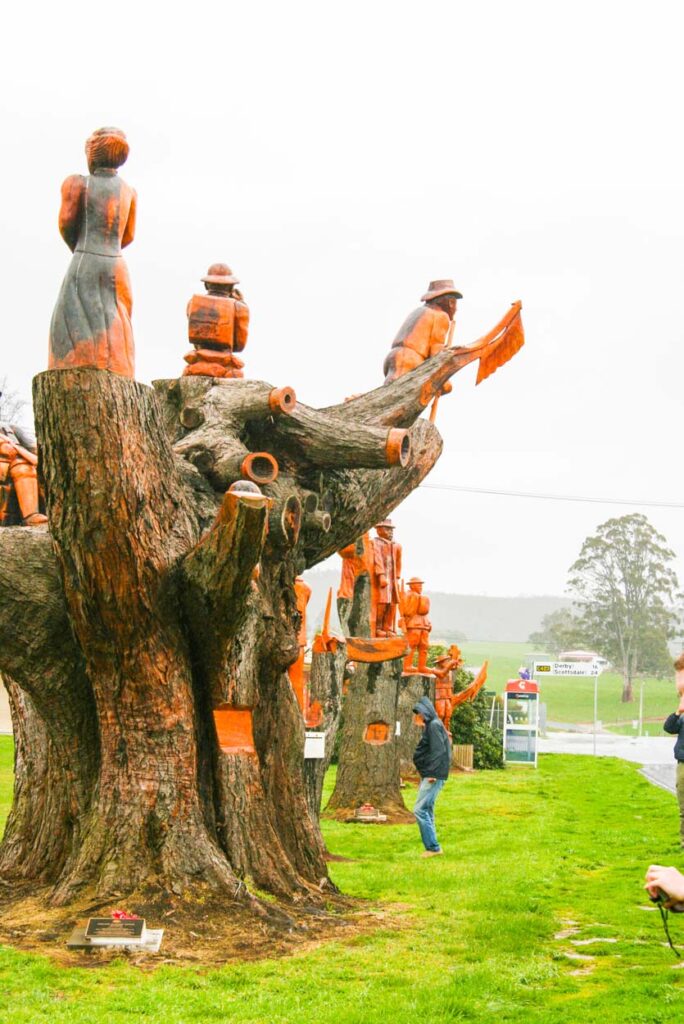
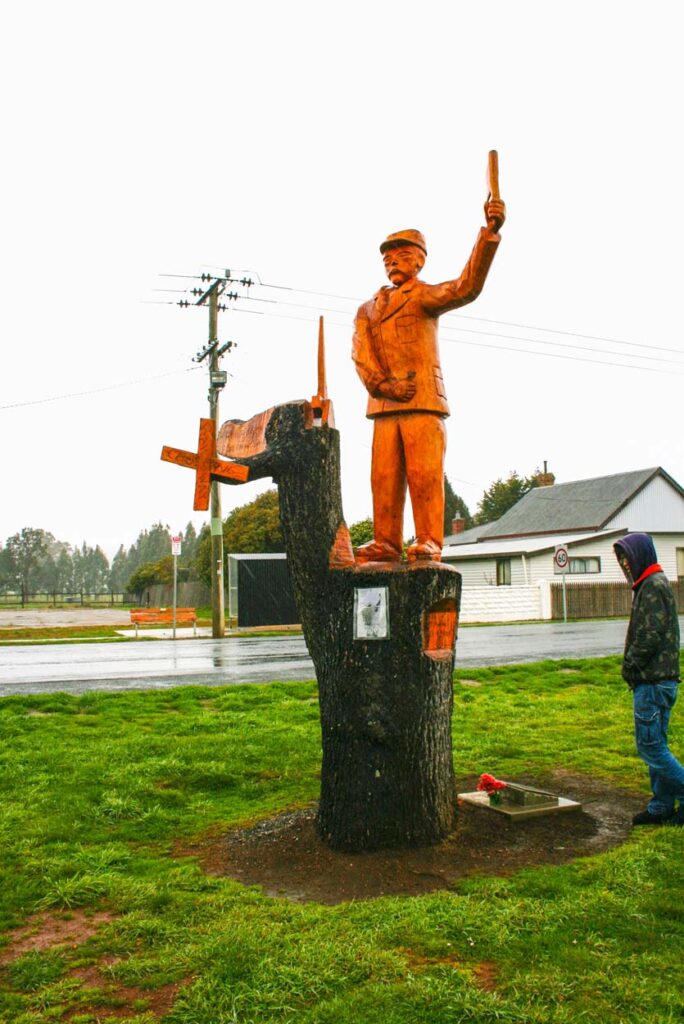
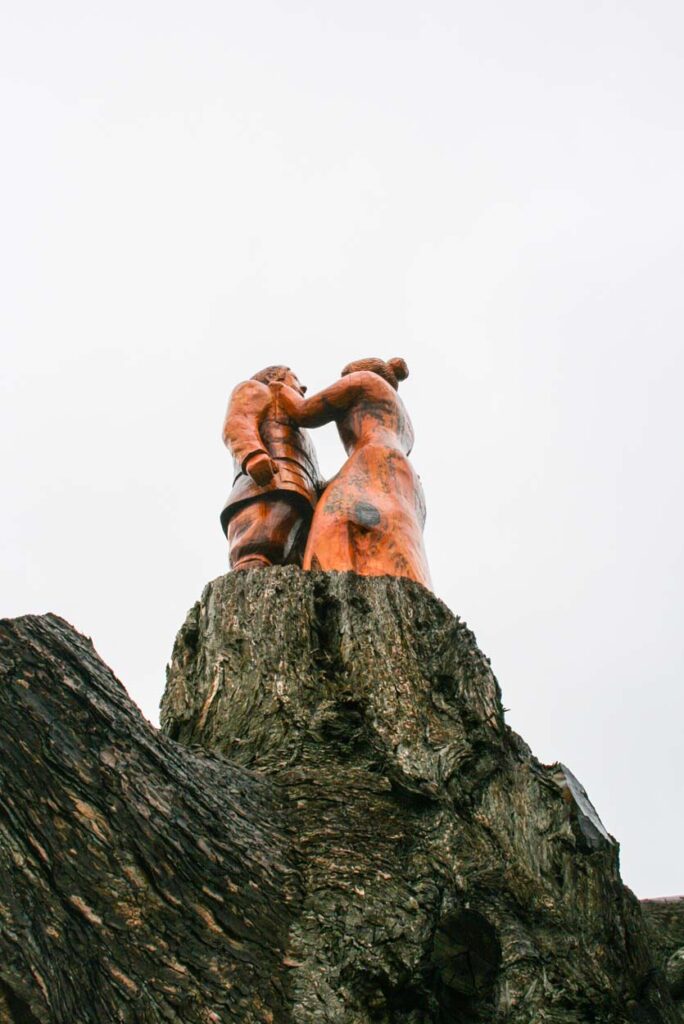
Little Blue Lake
Travelling along highway A3 through B82, we drive further north towards Little Blue Lake in South Mount Cameron. The lake is spectacular. It glows almost neon blue in the sunlight. But don’t you dare dip your foot into the water! The luminescent colour is formed as the result of alluvial tin mining and is packed with toxic heavy metals! Despite the toxicity, the area is a HUGE draw for spectators as it is truly one of the most impressive sights you’ve ever seen! Just north of Little Blue Lake, there is a gas station, so be sure to fill up.
As you drive down the highway and through Ansons Road, keep your eye out for wildlife. This area is a part of Mount William National Park, which is a protected environment for the Forester Kangaroo. The Forester Kangaroo is the largest kangaroo species in Tasmania and the second largest marsupial in the world.
Policeman’s Point
A 40-minute drive from the gas station will take you right to the coast! It’s incredible to see as you approach. Head down to the Policeman’s Point campground parking lot, where you can leave the car and look out on the incredible vista. There are also public bathrooms here if you need to use the facilities. Policeman’s Point is a part of the Bay of Fires Conservations area. The Bay of Fires area around here is known for its incredible white sandy beaches and clear blue waters. Many people don’t think of Tasmania as having such perfect beaches, but this one is spectacular! Standing on the edge of the Bay of Fires walkway on a clear day, you might be able to spot the Eddystone Point Lighthouse.
The Dutch navigator Abel Tasman, for whom the entire island is named after, was the first explorer to set their sights on Eddystone Point in 1642. It wasn’t until 1875 when a group of hazardous rocks were discovered below the waterline, that the lighthouse was built. It was made from local pink granite and constructed to help the sailors coming into port at St. Helen’s.
Bay of Fires
Head back along Ansons Bay Road, south towards through the Bay of Fires Conservations Area. The Bay of Fires was named by Captain Tobias Furneaux in 1773. When the captain first arrived in Tasmania, the first thing he saw upon landing was a group of fires set along the beach by the Aboriginal people living on the island. It was such a powerful sight that he named the area after that encounter.
An iconic part of the Bay of Fires are the coastal rocks covered in bright orange lichen. The rocks found along the shore here are made of dolerite. The most extensive of all dolerite formations worldwide, are found here in Tasmania.
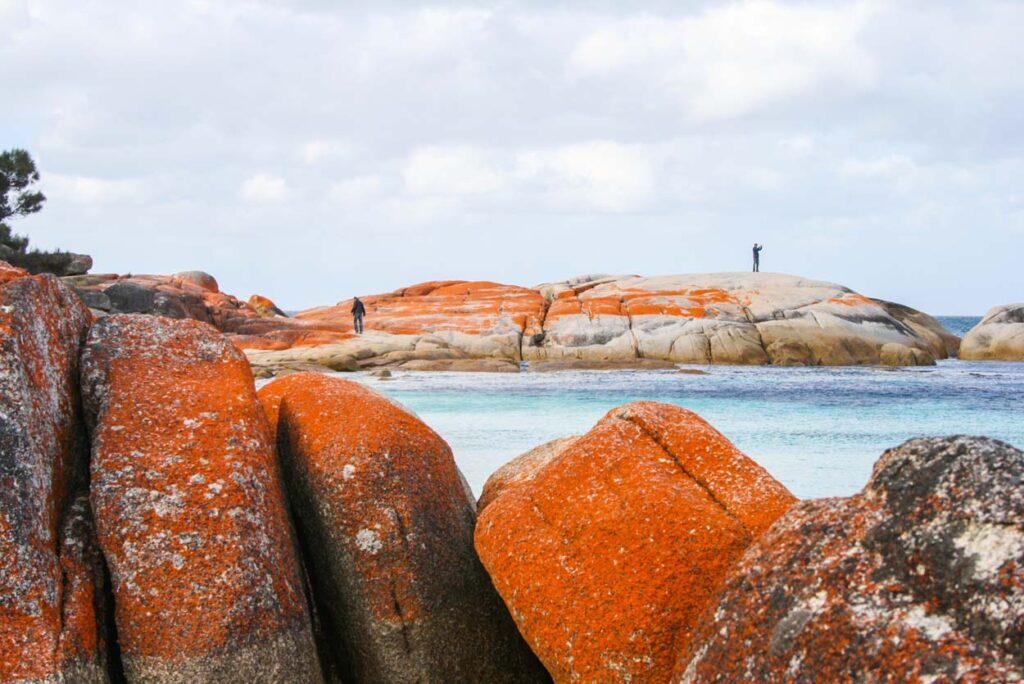
Meresta Eatery
One of the Bay of Fires’ best views can be found in ‘The Gardens.’ To access the Gardens, you need to head east towards Bingalon Bay and then make a sharp turn north up C848. If you brought a picnic dinner, this would be the perfect place to eat it. But if you are desperate for food, you’re in luck since there is a fantastic restaurant in Bingalong Bay. Meresta Eatery is a wonderful restaurant serving up great food made with the best ingredients from Tasmania. Their restaurant is often very busy since it’s one of the only ones in the area, but they also offer take-way for a little picnic in the Gardens.
The Gardens
When you finally arrive at the Gardens, it will be around dinner time, so find a spot on the beach to enjoy dinner and a sunset! The Gardens were named by Lady Jane Franklin, the wife of the Governor of Tasmania, in the early 1800s. She loved flowers, and when she came to visit, the wildflowers were blooming all across the coastline, making it appear as a giant garden. The waters here are just crystal clear and if you’re lucky, keep your eyes peeled to see if you can spot a pod of dolphins on their way home. There are even humpback whales that migrate through the area during certain times of the year!
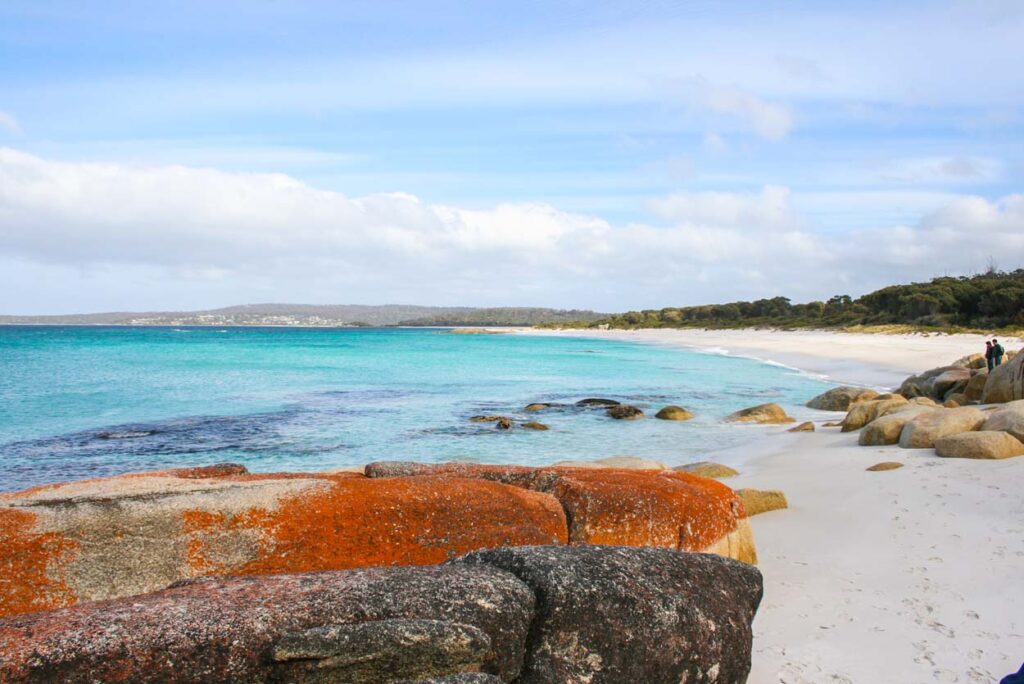
Bay of Fires Accommodation
My favourite place to stay is near Skeleton Bay and Binalong Bay. The area was once a retirement village, but it has been transformed into a little spot for surfers, fishers and people who visit the area for snorkelling and nature walks. There are dozens of holiday homes here, most of which can be booked on Airbnb. There are also some rentable bungalows in the area as well. If you need more accommodation options, you can go down to St. Helens. If you are travelling with camping gear or a camper van, there are several amazing camping grounds in this area.
Day 3 – Freycinet National Park
The Bays Kitchen
To get your day started, wake up and head on over to The Bays Kitchen. This cafe is such a surprise to find in such a far-off place. Their passionfruit cronut is wildly delicious. But they also serve classic Australian breakfast favourites like bacon sandwiches and meat pies.
Bicheno
Now that you’ve filled up for breakfast, it’s time to get back on the road. There is a gas station in St. Helen that is a great place to fill up. From there, we drive down the scenic A3 highway towards our next destination. Tasmania is such an interesting island to drive through as the landscape and greenery around the coastline are so different than the interior, which is much more like a rainforest.
After an hour and a half of driving, you’ll arrive in the small coastal town of Bicheno. This town is one of the major fishing ports in Tasmania and a popular beach resort. Everything from crayfish, abalone and scallops are caught just off the shores of the city.
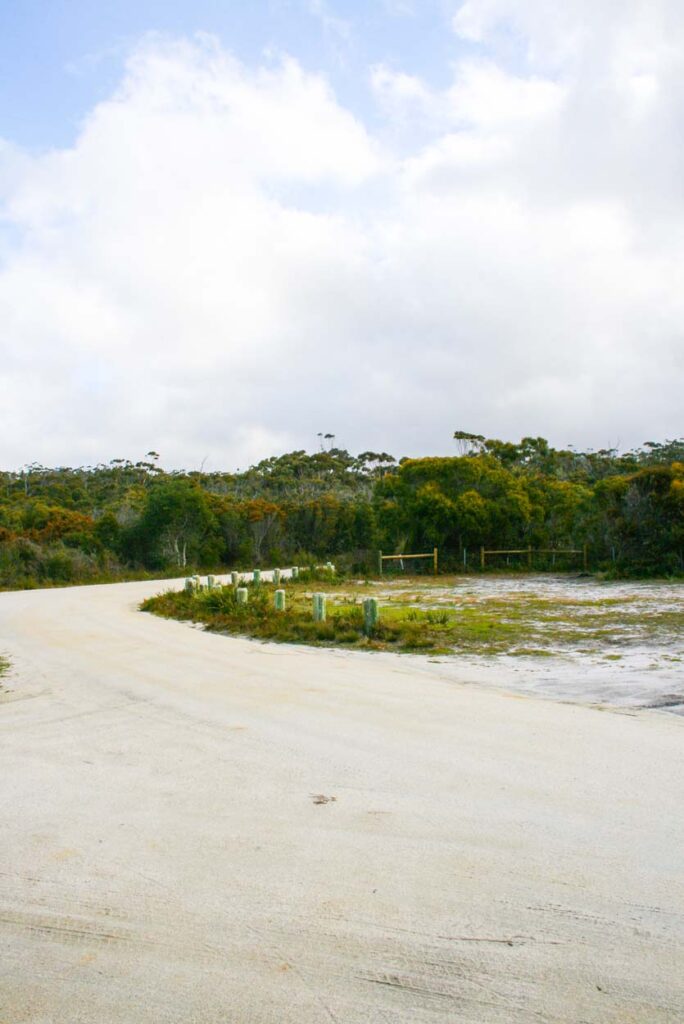

Bicheno Blowhole
One of the most popular locations to visit is the Bicheno Blowhole. The rocks along this shore are made of granite, but the crashing waves have carved a small sea cave shelf underneath the stones over the years. Eventually, a small hole began to form on the roof of this sea cave, creating a natural blowhole for the waves to burst through. Making an enormous spray above from the water rushes in. It’s a hit for kids and adults alike as every spray is different. Be careful, because you might just get wet! Bicheno was once a popular whaling spot in the 1800s, so it seems even more fitting that Bicheno would have formed its very own “blowhole.”
Whalers Lookout
Whalers Lookout is a steep but short 10-minute walk that leads to two lookout platforms. There is both an east-facing and west-facing platform. From here, you have a panoramic view of the town and the great crescent harbour.
Lobster Shack Tasmania
Bicheno is known for its seafood, so you absolutely must have lunch at the Lobster Shack Tasmania! This laid-back restaurant specializes in everything from lobster rolls to fresh oysters, local mussels and grilled salmon. Even just their house fish and chips is divine! Their outdoor deck tables sit off of the water and provide a stunning view of the pristine boat harbour surrounding it.
Diamond Island Nature Reserve
Just off the coast, to the north of Bicheno, is the Diamond Island Nature Reserve. The island is so close that you can even walk across the sandbar to the island during low tide. The island is home to a unique form of wildlife in Australia; the fairy penguins. These are minature penguins with the most darling blue colouring. All the little pathways you see on the island are formed by the penguins. This secluded, uninhabited island has become the penguin’s primary rookery. Be careful where you step to be sure to don’t crush one of their dens. Also, keep an eye on the water levels! You don’t get stuck on the island when the tide starts to come back in.
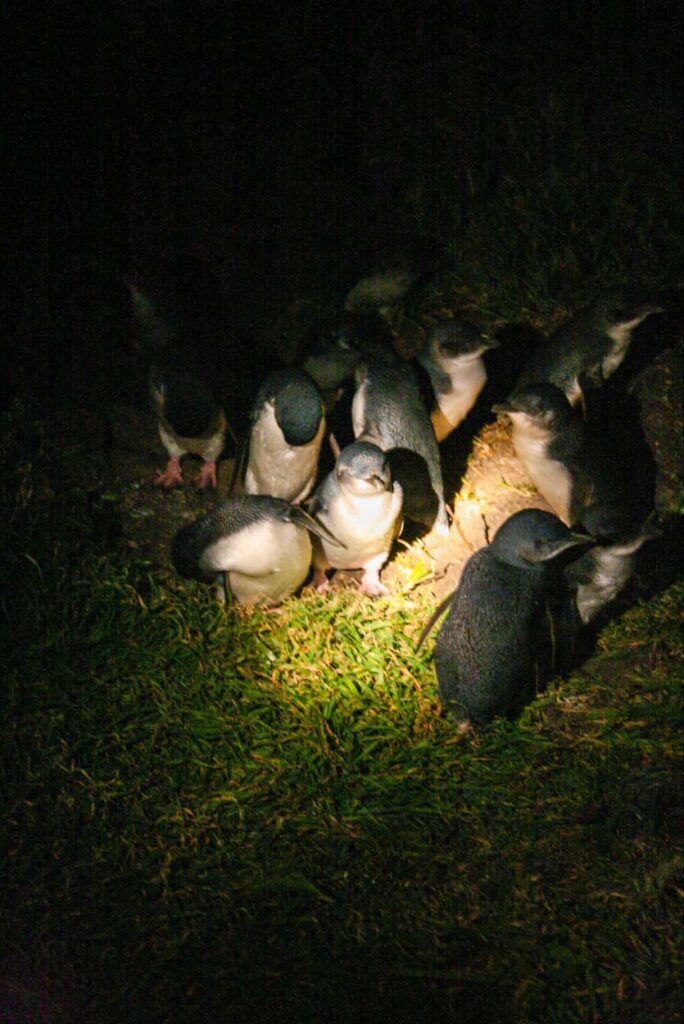
Grab some Groceries!
Before leaving Bicheno, head over the IGA supermarket to grab some items for a little picnic dinner on the beach at the last hiking spot!
Freycinet National Park
Just 30-minutes down the road from Bicheno, you can drive over to the Freycinet National Park Tourist Information center. Here you can pick up and learn more about the different walking and hiking trails that wind through this monumental natural wonderland that is Freycinet National Park.
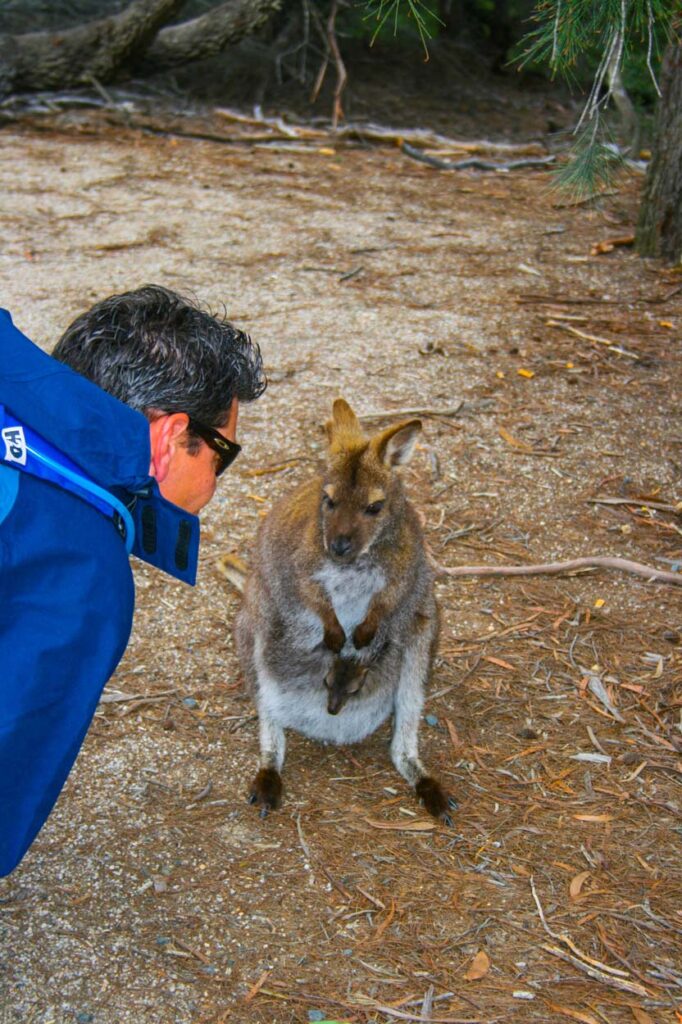
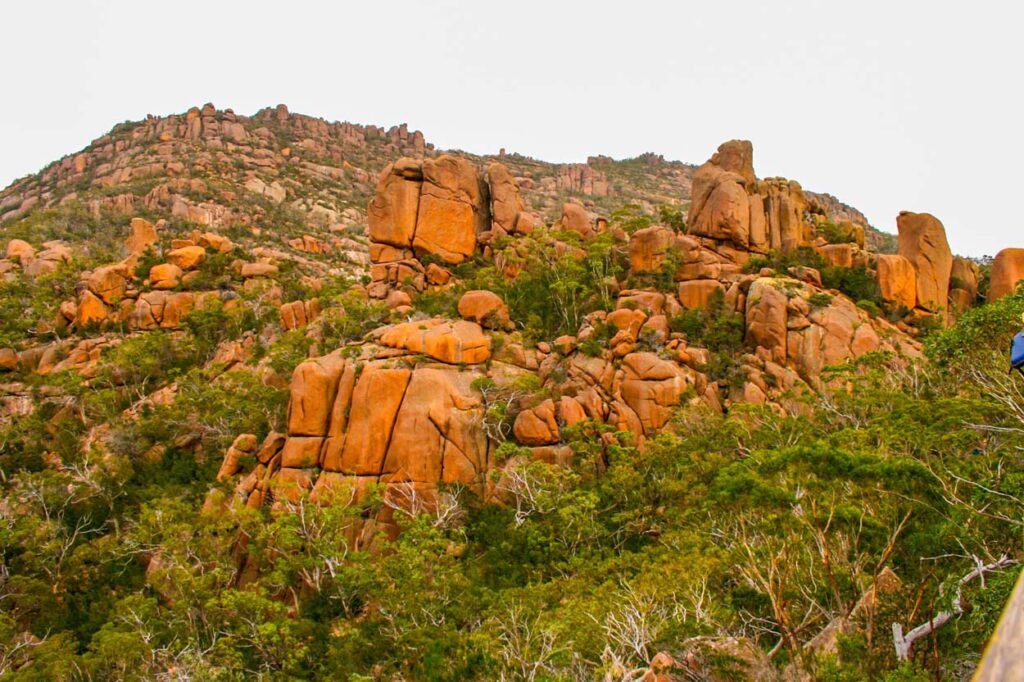
Accessibility
The parks department installed a 10-minute wheelchair-accessible circuit track that begins at the visitor center. While it would be great to see this expanded further over the years, it’s nice to know they have made an effort to take into account accessibility.
Wineglass Trail
The Wineglass Bay Trail is 6 km long and takes about 2.5 to 3.5 hours to complete based on how fast you go. But trust me, you’ll want to stop lots along the way! Not because it’s a particularly hard trail, but because there are so many amazing lookout points to admire. While the pathway isn’t too rough, you should definitely have some good walking shoes for this hike. The bathroom in the car park is the only washroom on the route, so be sure to use it before you go.
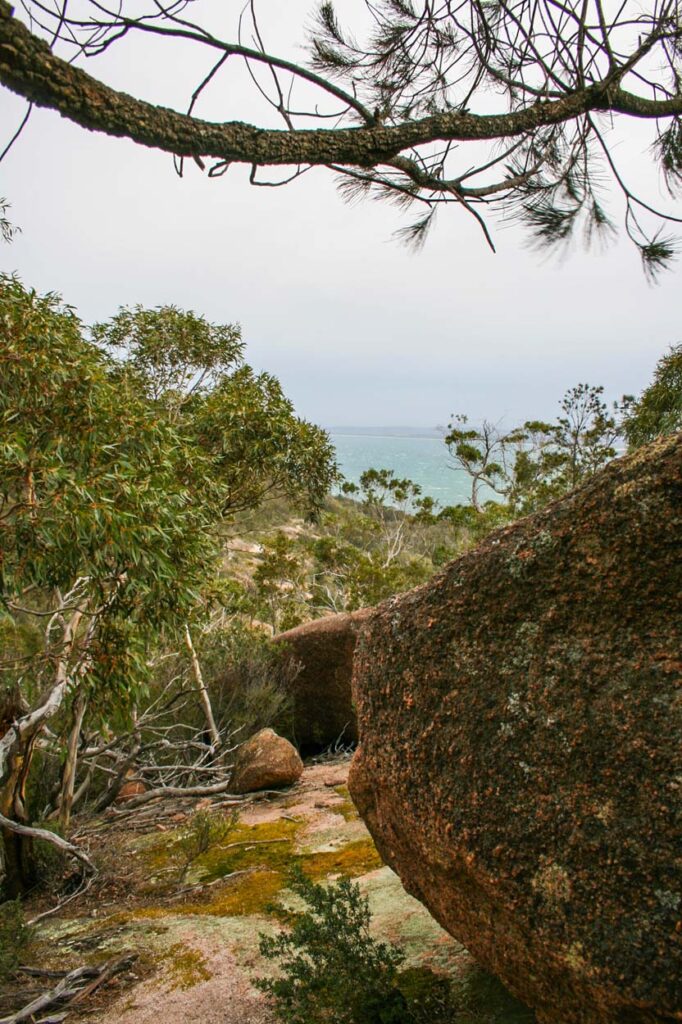
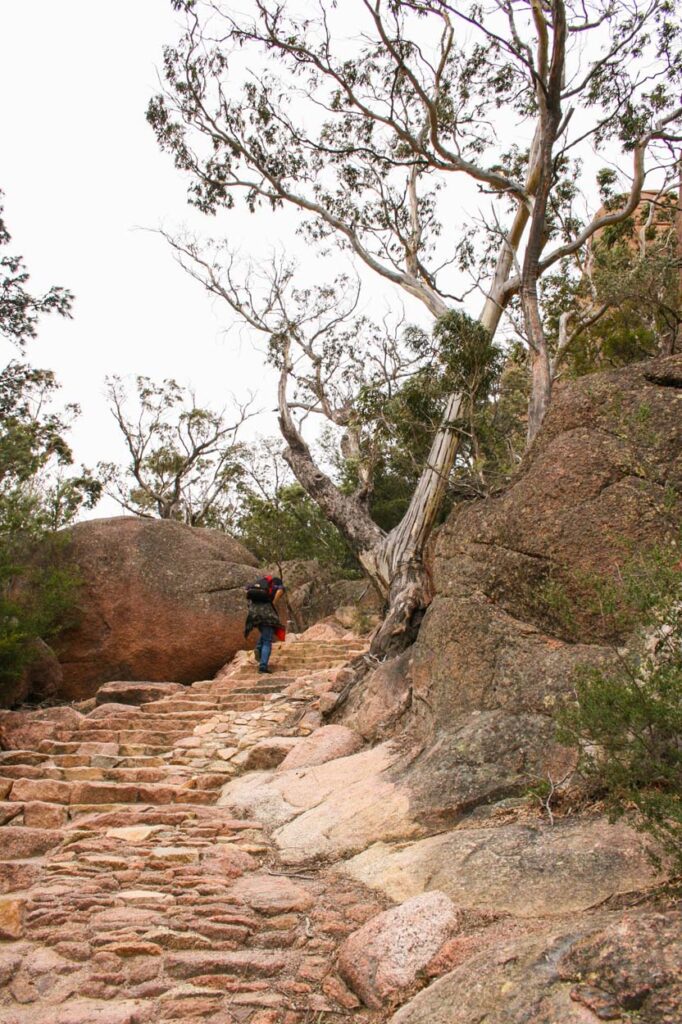
The Wineglass Bay walk takes you up to the top of the hill, where you’ll find the lookout. This point gives you a great view across the saddle-shaped wineglass bay beach below. The bright turquoise waters and almost impossible to believe white sands make for one of the most iconic views of Tasmania.
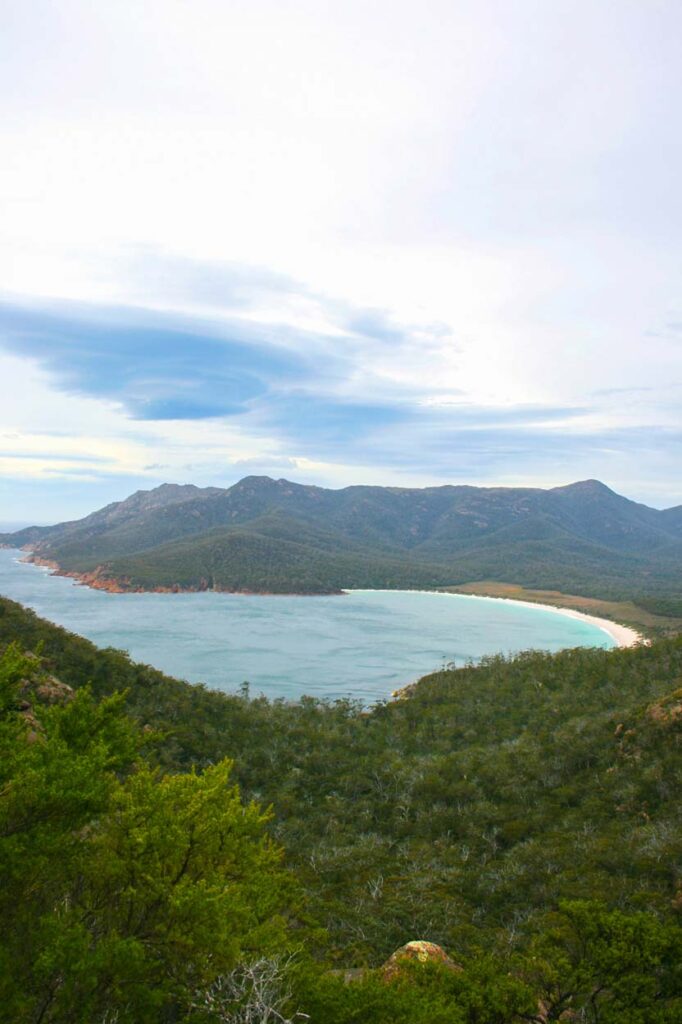
Wineglass Bay
From the top of the lookout, you can walk down the 1000 stairs to Wineglass Bay Beach. While this might seems like a trek, it’s well worth it to relax and explore the beach for yourself (not just from above). You can stroll along the sands, enjoying the sounds of the softly crashing waves while birds chirp in the distance. If you walk to the south end of the beach, you’ll be rewarded with a magnificent view of ‘the Hazards’ mountains.
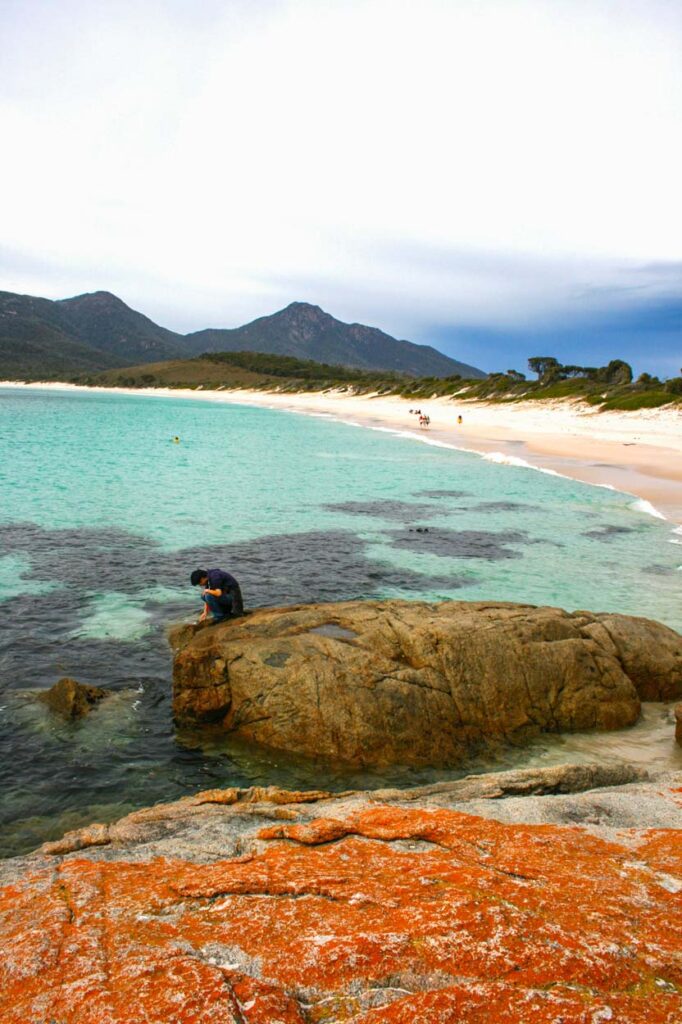
Because of the tall mountains which surround this bay, flora and fauna here are protected from the elements. Therefore this area produces a superb array of plants and animal life. Everything from wallabies, pademelons, and echidnas are commonly seen on land, and you might even be lucky enough to spot seals sunbathing on the rocks. If you brought some picnicking food with you, this is the perfect spot for it! And you’ll need to gather your energy for the 1000 stair hike back to the car park! If you planning the hike to end around sunset, once you get back to the top of the stairs, you’ll get an even more incredible view of the sun setting across the water.
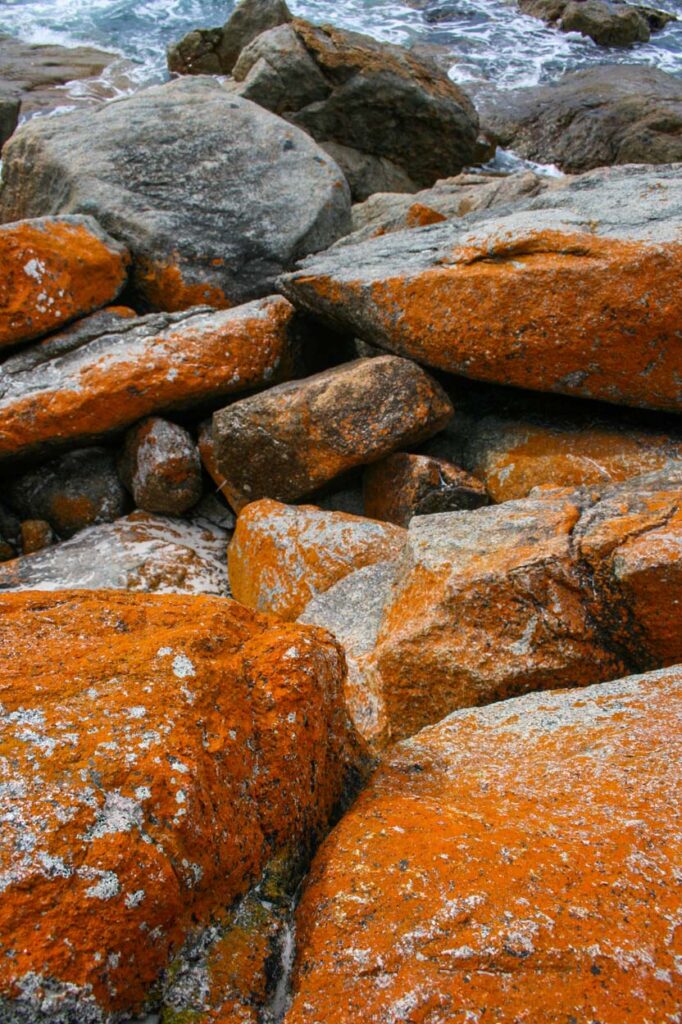


Honeymoon Bay
If you are still looking for a place to watch the sunset, head over to Honeymoon Bay. This peaceful beach is a popular destination for picnics, birdwatching and snorkelling. But at sunset, you can understand why it might be called Honeymoon Bay as the scenery just screams romance!
Coles Bay Ice Creamery
If you didn’t bring anything to eat for dinner or want to grab a late-night dessert, head back into Coles Bay village and over to Coles Bay Ice Creamery. Coles Bay Ice Creamery serves up fantastic fried fish and chips! Located in the quaint seaside village, this retro-styled shop also offers 24 flavours of Tasmanian-made ice cream and a wide range of hot and cold drinks. Dine inside or out on the patio tables with panoramic views of the Hazards mountains of the Freycinet peninsula. The fried Crumbed Tasmanian Scallops with chips, aioli dipping sauce and local craft beer is a match made in heaven.
Finish off the meal with a couple scoops of ice creams. They have such unique flavours as; salted caramel crunch, lavender, watermelon, Irish creme with scorched almonds, or Viennese coffee. If you still have any energy left, you can grab a cone to-go and head over to the Esplanade to enjoy your sweet treat.
Freycinet Retreat
There are lots of holiday home rentals around Coles Bay and near the Hazards. You can get huge homes for the whole family or little apartments perfect to crash in after a long day of hiking. If you brought a camper or camping equipment Freycinet National Park’s campground is a wonderful place to set up for the evening. But my favourite place to stay is at Freycinet Retreat. This is an eco-certified, boutique hotel, nestled in thick forest on the side of Mount Paul and surrounded by the National Parkland. The rooms are impeccably designed and provide a stunning view of the Tasmania landscape. Their walk-out balconies offer the chance to spot the wildlife that surrounds the sanctuary. It’s a luxury experience but well worth the price.
Day 4 – Wielangta Forest
Spend as much time in the morning in your room as possible, as the mornings in the Freycinet National Park are a particularly special time of day. Enjoy a coffee on the patio as you watch the sunrise, and listen to the sound of the animals as they sound the alarm as dawn rises in the distance.
Kate’s Berry Farm
As we get back on the road, we start to head down south. On the way, let’s stop off at Kate’s Berry Farm. Kate has been harvesting and growing berries since 1988, when she bought this property. The main reason? The magnificent views of Tasmania’s eastern coastline. Here, Kate grows raspberries, strawberries, red and black currants. She turns these fruits into everything from jams, ice cream, and baked pastries.
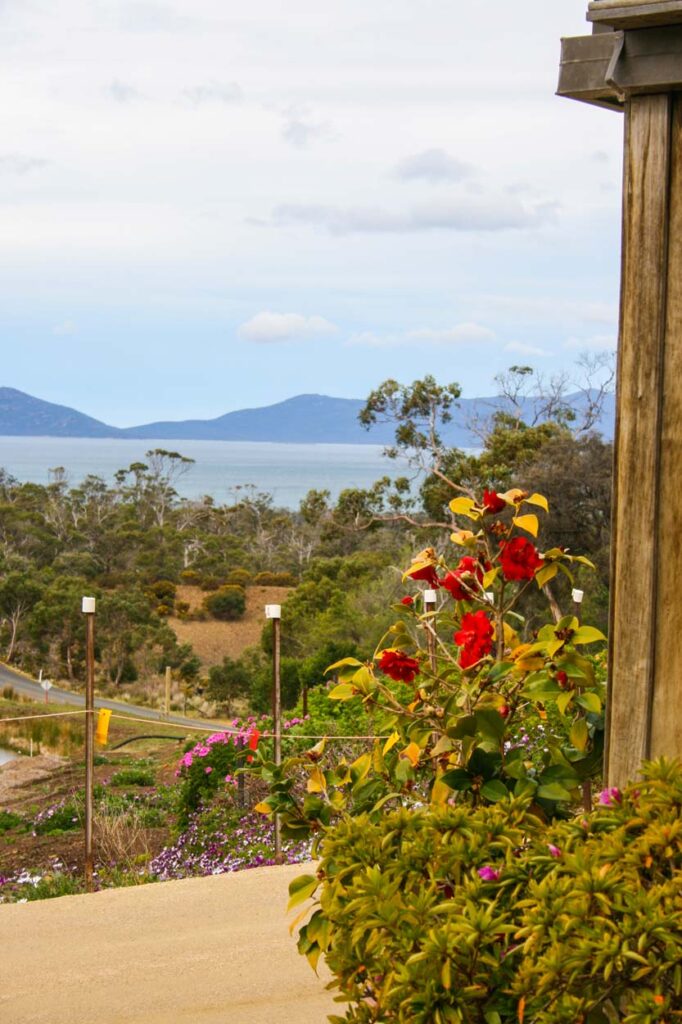
The biggest draw to Kate’s farm is her ‘Just Desserts Café’, which serves fresh-baked scones with their homemade jam, fruit and meat pies and even Belgian waffles. Basically everything you need for a mouthwatering breakfast. Another item that you can’t leave without trying is Kate’s handmade chocolates. She combines rich Belgian chocolate with her berries and other Tasmania ingredients to create incredible flavours. Grab a box to go to enjoy on the road when you get peckish.
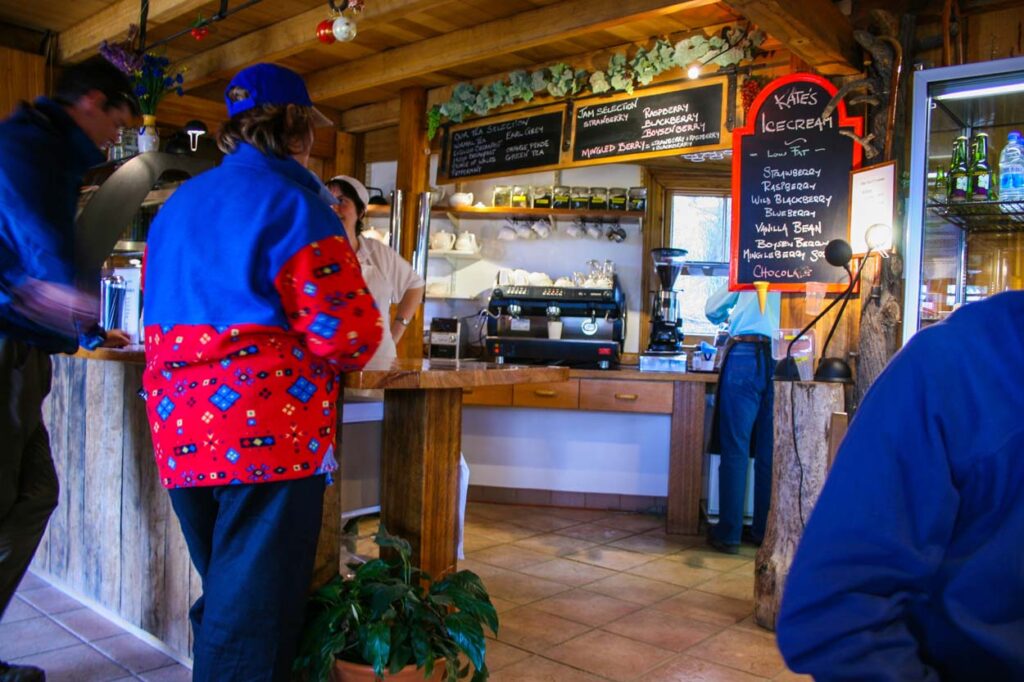
Spiky Bridge
Along our route today, you need to stop to see one of the stranger side-of-the-road attractions, the Spiky Bridge. The bridge was built by convicts in 1843 out of sharp fieldstones. The bridge is located on the old convict road that connected Swansea with Little Swanport and the east coast road to Hobart.
The stones were laid vertically on the parapet to give the bridge its name: Spike Bridge. There are two differing opinions on why the spikes were added like this. The first is said to have been made to prevent cattle from falling over the bridge. The other is that they were added to help the bridge survive the harsh elements of the coastline. Either way, it is one of the more obscure scenes from the Tasmania roadside.
Triabunna Ferry to Maria Island
Travel down the A3 until you reach Tribunna. Head down to the Triabunna Wharf, where you can get the Ferry to Maria Island. The Ferry departs from Triabunna to Maria Island at 10:00 am and 11:30 am. Departure times from Maria Island back to Triabunna are from 2:30 pm and 4:15 pm. Be aware that the Ferry does not operate on Tuesdays or Thursdays. A return adult fare costs $45 AUS. The best plan is to arrive at 11:30 am and head back on the 2:30 pm ferry. This gives you enough time to explore the island, but you can head back before the end of the day.
Darlington Convict Site
Exiting the Ferry, you arrive in the tiny settlement of Darlington. This old convict probation station is now considered a World Heritage Australian Convict Site. Darlington was the sole settlement on the island, but there are no permanent inhabitants aside from the park rangers today. Upon arrival on the island, stop off at the ranger station for a map of the island to help you get around.
Today, the Darlington township is the most intact example of a convict probation station in Australia. It is one of eleven convict sites recognized by UNESCO as a World Heritage Site. In the Darlington historic township, you can still visit some of the old buildings from the 1820s. This includes the commissariat store, the workers’ cottages and the old penitentiary.
When the convict station was open, it was home to over 600 male convicts crammed into these overcrowded buildings. The old prison that still stands here dates back to 1824. It was built to house convicts, mainly from Ireland, including the Irish nationalist leader William Smith O’Brien. He was exiled for his part in the Young Irelander Rebellion of 1848. Interestingly, O’Brien didn’t have to live in the crowded penitentiary. He had a cottage built near the penal colony that you can still visit today. Shockingly you can even opt to stay overnight in the old jail cells! There is also a campground on the island near the old Penitentiary buildings where you can camp should you choose to. Eventually, the prison was shut down, with a halting of convicts arriving from England.
The Island as National Park
The island was purchased by an Italian entrepreneur, Bernacchi, who wanted to harness the island’s agricultural resources. He opened “the Grand Hotel” in 1888 and turned some of the old convict buildings into a pleasure resort. This “sanitarium” was designed for city folks to escape and relax in the peace and quiet of the countryside. Funny to imagine that this place of harmony was once a horrible spot of punishment only a few years early.
Sadly, Bernacchi’s venture was short-lived, and eventually, the township passed hands to a small cohort of farmers. Farming ended when the Tasmanian Government began purchasing properties from their owners to declare the island a national park.
Maria Island Wildlife
Animals to spot while you walk along the trails include; the bare-nosed wombat, eastern grey kangaroos, red-necked wallabies. There are also fallow deer, ringtail possums, echidnas, and many, many snakes! Birds are also very prevalent on the island. In fact, there are even some swift parrots, Cape Barren geese and twelve of Tasmania’s endemic birds, so bring your binoculars!
Painted Cliffs Walk
From the Darlington settlement, take a walk along the island’s eastern side. Here you can see Maria Island’s spectacular painted cliffs wrapping around the coastline. The painted cliffs are made of these fantastic swirling colours and patterns. The design is caused by the groundwater percolating through the sandstone over time. The waves crashing onto the sand create erosion resulting in these magical honeycomb patterns, potholes and notches. Mother nature is such a wonder!
The Painted Cliff walk starts along the coastline and heads back to Darlington via the island’s interior. This winding trail provides views of the waterside and forest-like landscape of the inner island. The walk takes around 1.5 to 2.5 hours, so you can easily walk it in enough time to be back at the Ferry for the 2:30 departure. Whenever you get a chance to look out over the water, keep a keen eye out. During certain times of the year, you might be lucky enough to spot a whale during its annual migration!
Three Thumb State Reserve
Get back on the Ferry at 2:30 pm so you can get back on the road with sunlight to spare. Make your way to the Three Thumb State Reserve. This lookout point can be driven directly up to; no hiking require at all! And you’ll be shocked at the incredible view you’ll be greeted with as you arrive in the picnic area. It looks out over Prosser Bay and Great Oyster Bay at the Peninsula and the ocean beyond. This area is home to Swifty parrots and wedge-tailed eagles, as we all as several threatened plant species.
Wielangta Forest
Only 20 down the road from the lookout, you continue on into the Wielangta Forest. The Wielangta forest is a glacial forest containing lush eucalyptus trees and giant ferns. The forest is home to some rare and threatened species, including the Tasmanian wedge-tailed eagle, swift parrot, Wielangta stag beetle, spotted-tail quoll and eastern barred bandicoot. They have even discovered a rare orchid inside this unique forest.
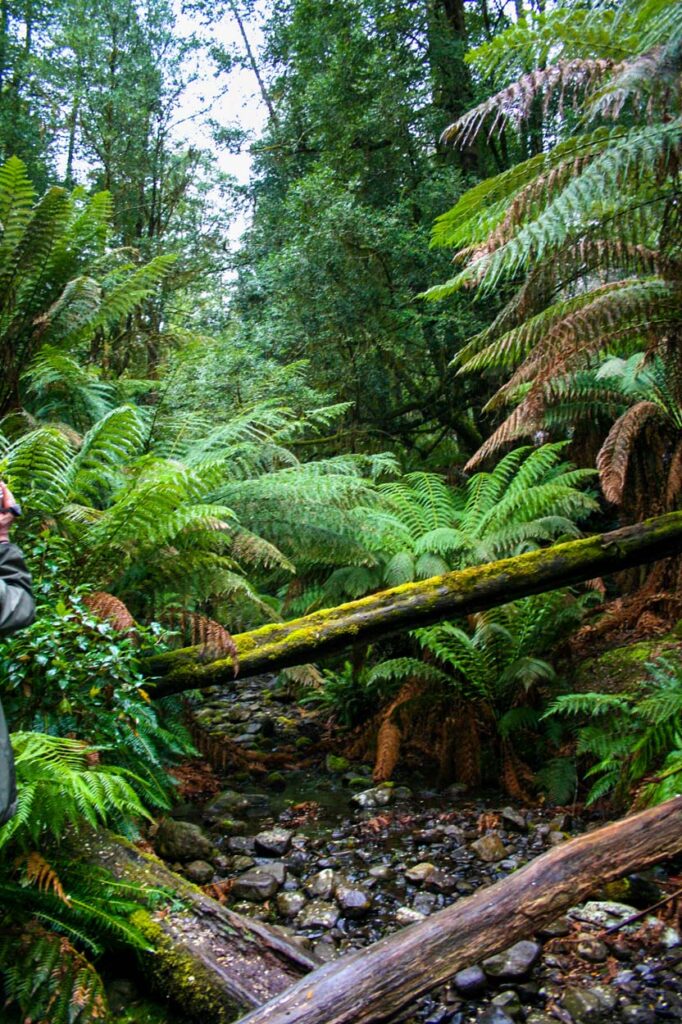
Stop at the Wielangta Forest Picnic Area, where you can walk along the Wielangta Walk that weaves itself along the Sandspit River. The walk is pretty long, but you need only go about 20-minutes in to still get a great sampling of the fantastic temperate rainforest. Something only to be found in Tasmania!
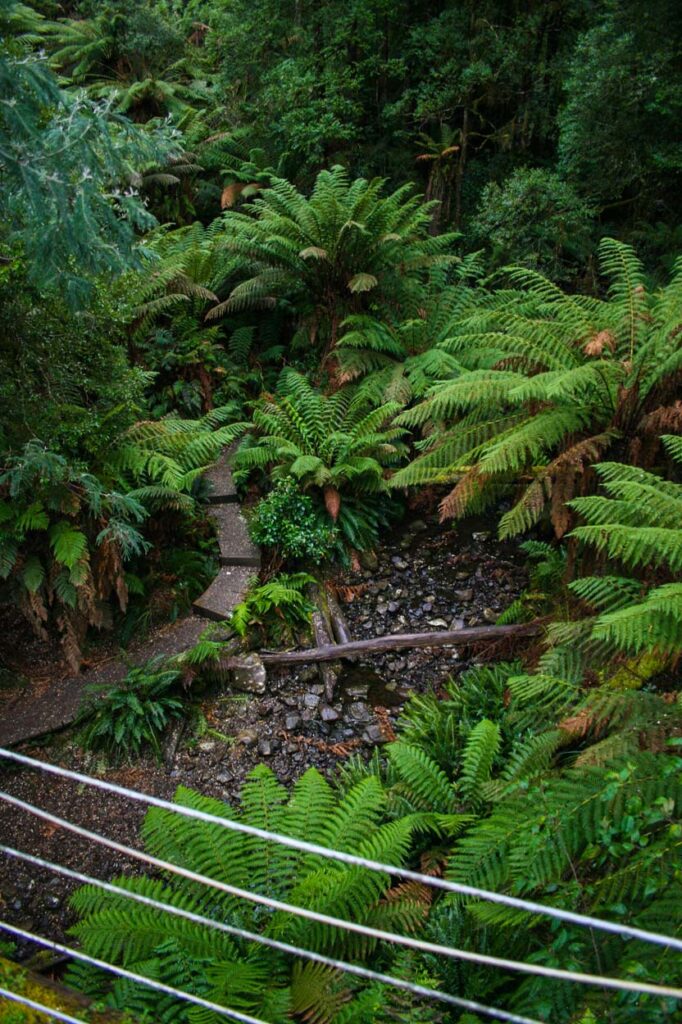
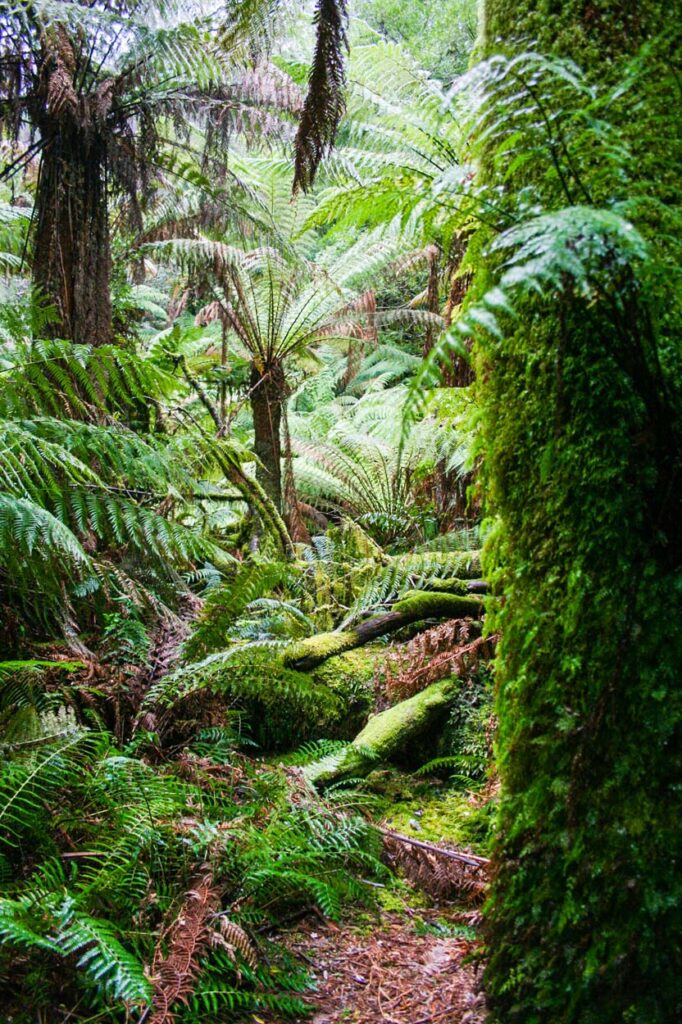
Murdunna Roadhouse
On your way towards the last stopping point of the night, head over to Murdunna Roadhouse. Although this looks like a gas station with a small supermarket inside, the building hides a fantastic little cafe with everything from a deli counter to freshly shucked oysters! The fish and chip are made fresh and surprisingly sumptuous for somewhere you’d expect to serve nothing but chocolate bars and soda pops. Pick up some items to make yourself a picnic dinner as the accommodation we recommend for the night has a small kitchen. If you are staying somewhere else, you can also get many premade meals here you can eat without much prep. I would also advise you to stock up on some food for tomorrow’s breakfast and lunch as there aren’t many options for food as we drive deeper into the Tasman peninsula.
Eaglehawk Neck / Teralina
Passing over into the Tasman Peninsula, we cross over the narrow isthmus called Eaglehawk Neck. An isthmus is a narrow piece of land connecting two larger areas across an expanse of water by which they are otherwise separated. The Tasman Peninsula was originally called ‘Turrakana’ by the indigenous people who once inhabited this part of the island. Before the invasion of the British, who eradicated almost the entire population in the short time after their arrival. The peninsula is best known for being the location of historic convict site Port Arthur and for its natural rugged coastline where you can find the Tasman National Park.
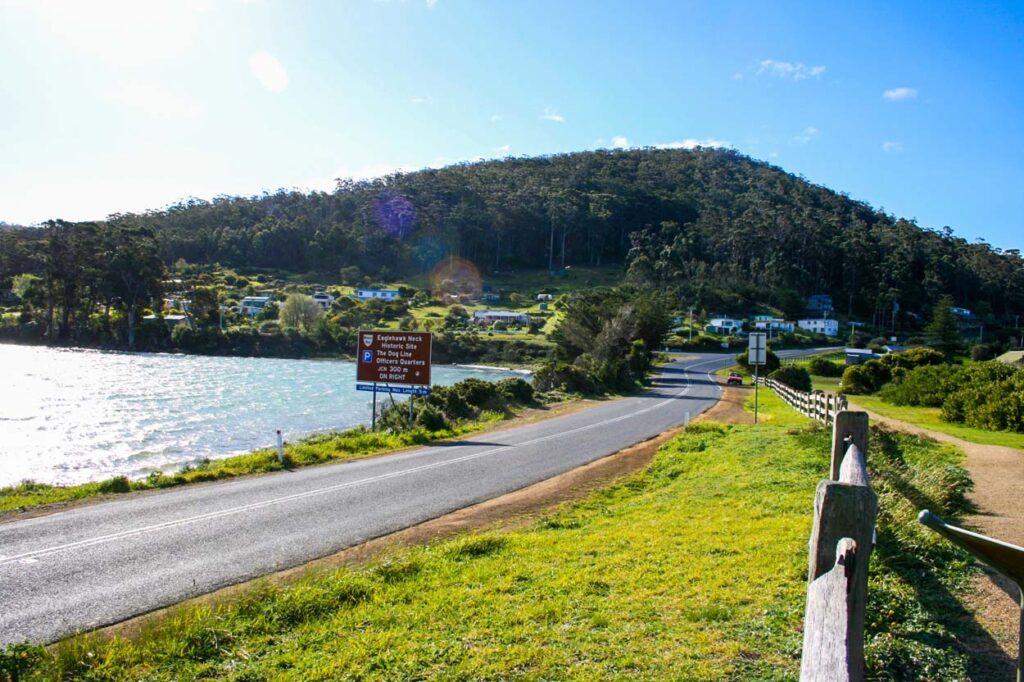
The Dog line
The Eaglehawk Neck or ‘Teralina’ was used by the British as a place to stop any escaping convicts from the southern Port Arthur penitentiary. As the expanse of land was only 30 metres wide at its narrowest point, the British employed a series of dogs chained to posts to warn the guards of anyone attempting to get through unannounced. In addition to the line of chain, very aggressive dogs, there was 24-hour surveillance by heavily armed soldiers.
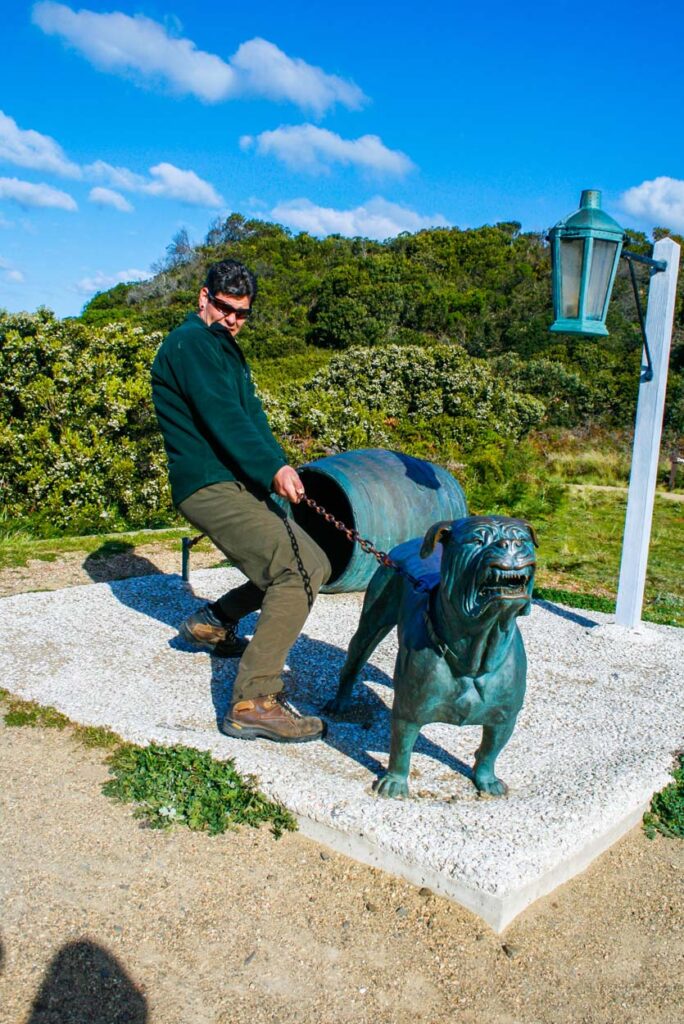
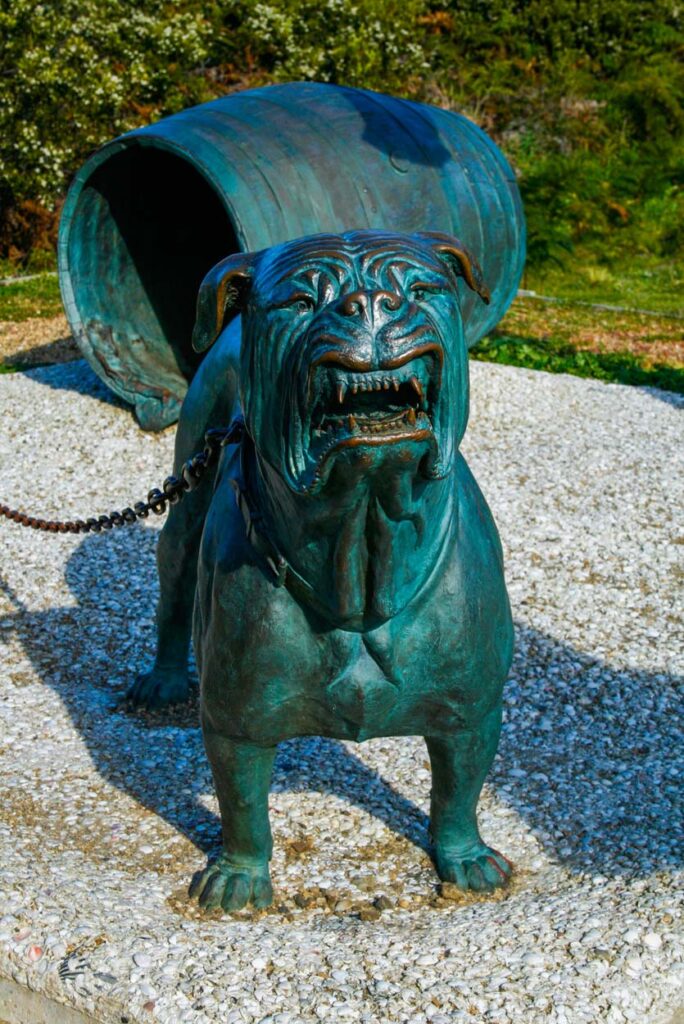
Eaglehawk Pavilions
Finish your night at the Eaglehawk Pavilions. This is another boutique hotel located right at the mouth of the Tasman Sea and Pirates Bay! There are only two pavillions so book this accommodation early. Each one of these little holiday homes has an outdoor bbq or indoor kitchen. If you are looking for a camping spot consider the Sunset Beach Holiday Spot just up the road.
Day 5 – Tasman National Park
Tasman National Park
After loading up on coffee or tea while soaking in the sunrise on the water, it’s time to get back on the road. The first stop of the day is at the tip of Pirates Bay, at the ‘Blowhole.’ This blowhole is very similar to the one we saw in Bicheno, with a spray of misty water exploding from a hold in the sea cave below. Above the blowhole, you can walk out towards the Fossil Bay Lookout, where you can see the entirety of the dramatic coastline spread out in front of you.
Tasman Arch
Walk a few minutes along the pathway towards the great Tasman Arch. This incredible cliff side looks out over the southeast tip of Tasmania and out towards the ocean. Towering up above the water, over 300 meters above, to be exact, are these amazing dolerite cliffs. The cliffs have been naturally carved by the wind and water that batter the cliffside carving out over thousand and thousands of years this archway. It looks so artfully deliberate like someone came and made it as a frame to the great ocean on the other side. Once more, mother nature just on full display here in Tasmania!
Doo-lishus
If you are feeling peckish, you need to see if it’s late enough in the morning for the Doo-lishus food truck to be open. This side of the road establishment is a mainstay for visitors and even the locals. They have more than just the traditional fish and chips, too; you can get scallops and squid as well as freshly made meat pies and steamed mussels. Prices are a bit high, but since the food is almost brought to you in one of the most picturesque locations, you’re paying a premium for that.
Cape Hauy Walk
Get back on the road and make your way through the island’s centre towards the southeastern tip, at the Tasman National Park near the parking lot to the Cape Hauy Trail. This hike is the longest included in this itinerary. The entire hike takes about 4-hours to complete the return journey. As the vegetation up here on the cliffs is relatively low to the ground, you pretty much always get a beautiful view of the stunning coastline. So feel free to make the hike as long or as short as you see fit. There’s no pressure to walk the entirety. You can turn back whenever you see fit. If you do plan on doing the entire hike, be sure you bring some food along with you for a bit of picnic at the endpoint around the 2-hour mark.
The trek starts from the boat docks at Fortescue Bay and follows the edge of the steep dolerite cliffs. Towards the end of the hike, you’ll be able to see the sea stacks that the rocks form. These have also been dubbed the “candlesticks” or “totem poles.” These rock formations have split off from the mainland and now stand on their own. Many climbers and abseiler use these rocks to climb, and you can often watch their daring antics as you continue on your walk. Really makes your walk feel like childs play in comparison to those daredevils.
Remarkable Cave
With exhausted feet, it’s time to head back into the car and bid adieu to the natural beauty of the National Park as we head west, over to Port Arthur. But before heading to Port Arthur for the rest of the day, drive to the southern tip of Tasmania, where you’ll find the Remarkable Cave. The Remarkable Cave is famous for its unique form when gazed upon from the viewing deck near the water’s edge. The two sizeable sandstone outcrops were worn away by the splashing of the waves over time. This once more created a hollow cave underneath. Hiking down the stairs to get to the viewpoint, you can make out the shape of the sea cave, and you’ll be amazed to see that it takes on the form of Tasmania! Just incredible.
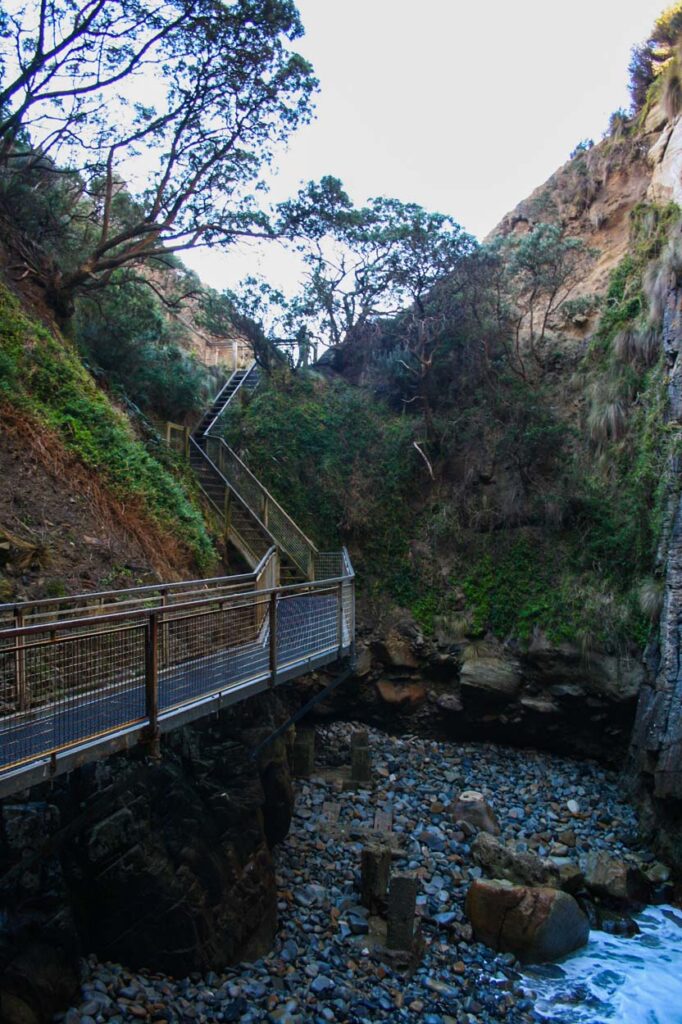
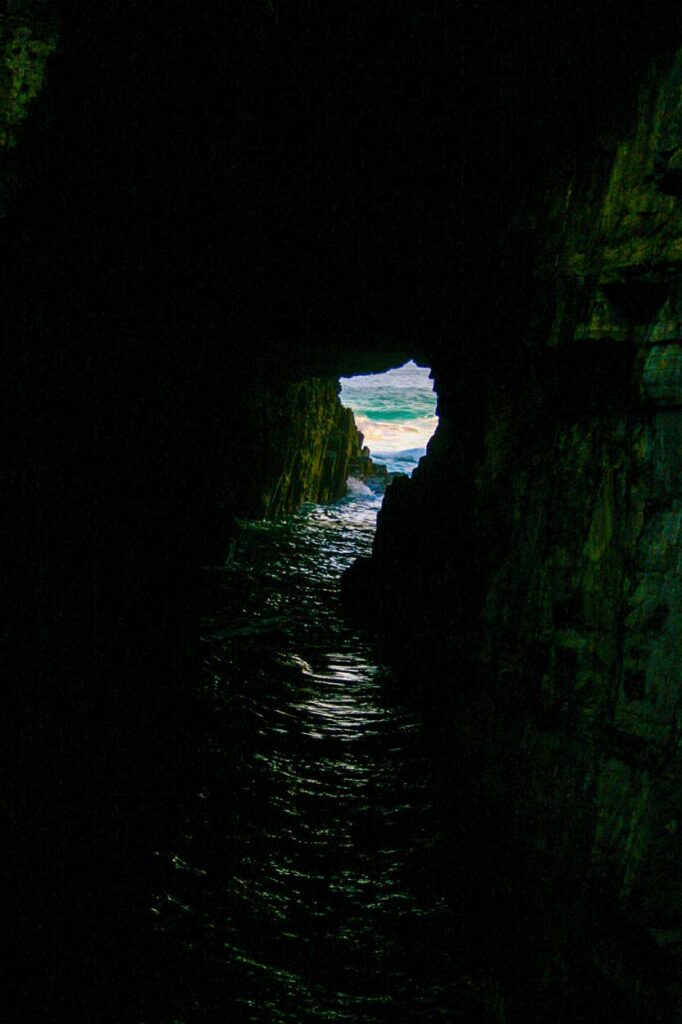
Port Arthur Motor Inn
After a scenic drive back to Port Arthur, it’s time to find a place to lay your head. Port Arthur is such a charming town, despite its rather sordid convict past. One of my favourite places to stay in Port Arthur is at the Port Arthur Motor Inn. This amazing and quaint hotel is actually located inside the historic Port Arthur Convict site. It’s like staying inside a bit of history. Not only are the room very affordable, but all the rooms also look right out over the scenic Port Arthur site and the bay. Best of all, there is also an amazing restaurant on-site, so you don’t even have to leave your room if you don’t feel like getting up for dinner after your long day of hiking!
Ghost Tour
One of the best ways to experience the darker side of Port Arthur is at night. Specifically at one of their evening lantern-lit ghost tours. The ghost tours are even more popular than the regular site tours, and they book up fast, so best to book that tour well in advance. Since the site was such a place of pain and suffering, it is the perfect location for hauntings. Whether you believe in ghosts or not, the storytelling that takes place here is phenomenal and seeing the site at night is a really unique experience. If you don’t feel like leaving your room, you can simply sit out on the balcony as the sun sets and read over my ghost stories all about Port Arthur! Trust me, you don’t need to be there to get a good scare.
Day 6 – Port Arthur to Hobart
To start our sixth day in Tasmania, we make our way to the old convict settlement of Port Arthur. The site at Port Arthur is one of the best-preserved Australian Convict sites and one of the largest settlements. This site gives a fantastic look back in time at Tasmania’s violent and criminal past. At the site was here, the most hardened criminals came to stay with some of the most rebellious personalities. For this reason, Port Arthur had some of the strictest security measures and most brutal punishments. Most of which focuses on the psychological rather than the physical. To end our day, we make our way to the old convict settlement of Port Arthur.
Port Arthur Historic Site
The site at Port Arthur is one of the best-preserved Australian Convict sites and also one of the larger settlements. This site gives a fantastic look back in time at Tasmania’s violent past. At the site was here the most hardened criminals came to stay with some of the most rebellious personalities. For this reason, Port Arthur had some of the strictest security measures and brutal punishments.
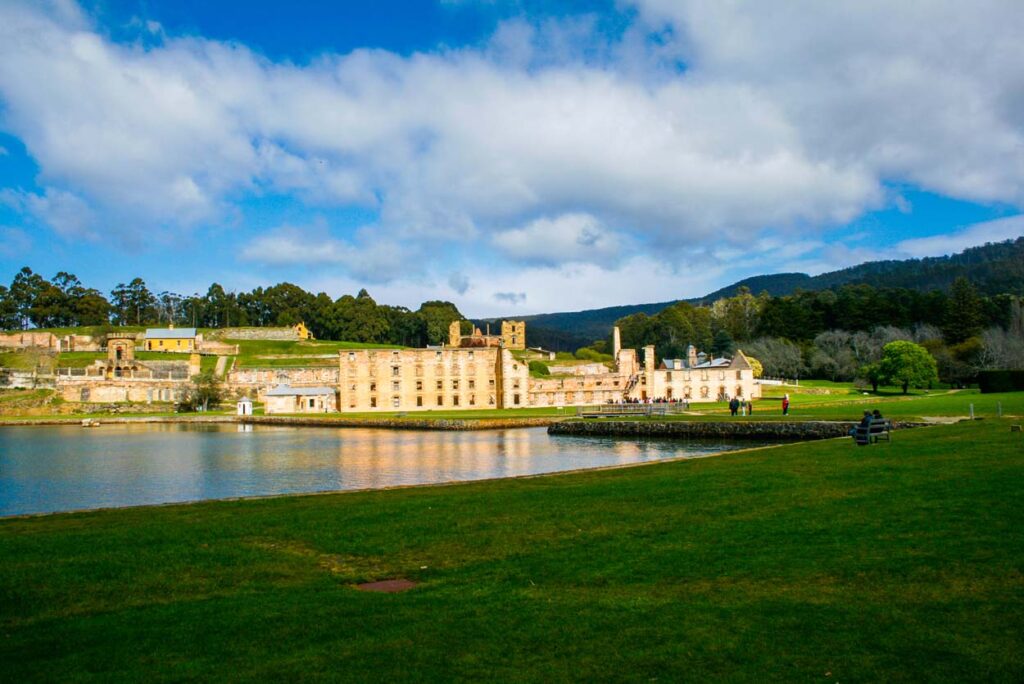
Practical Information
Hours and Admission
Adult tickets cost $40 AUS, and children are $18 AUS. Your ticket into Port Arthur includes entry to the museum, a 40-minute walking tour, a harbour cruise, and access to 30 different historic buildings. The site is open seven days a week, from 10:00am – 5:00pm. They are only closed on Christmas Day.
COVID-19 Protocols: Tickets must be booked online prior to your visit. Click here for more information on their COVID-19 safety precautions.
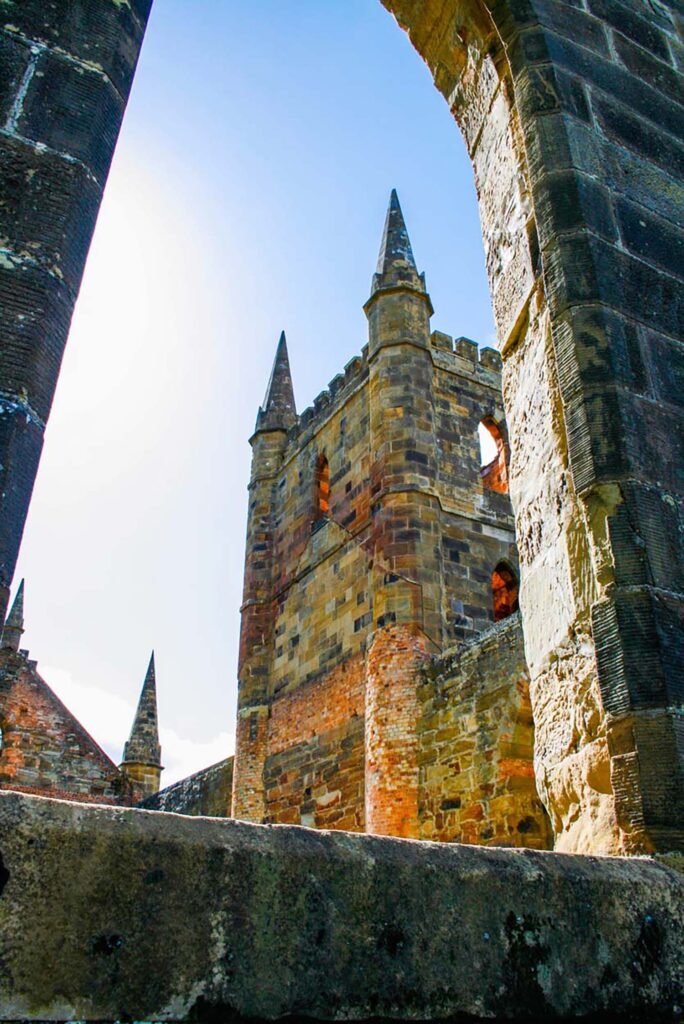
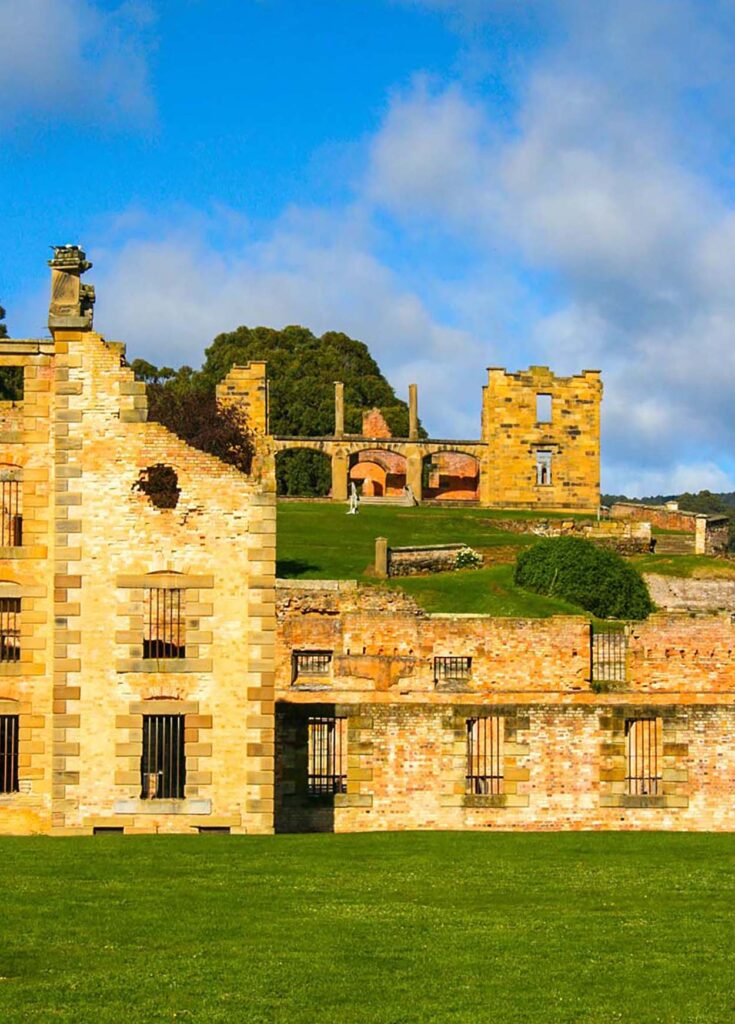
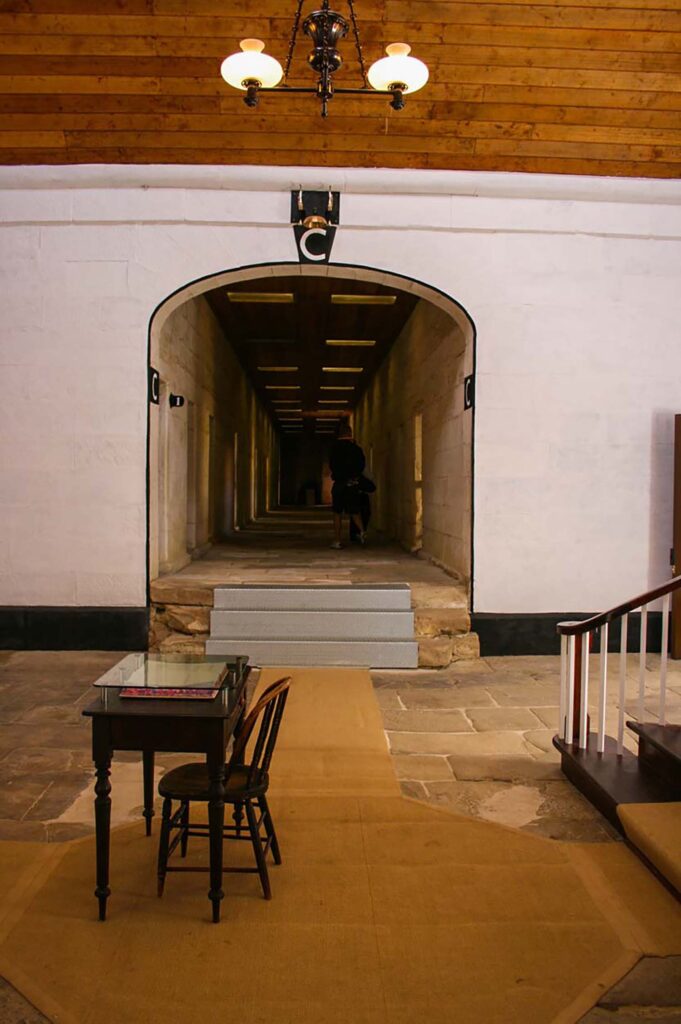
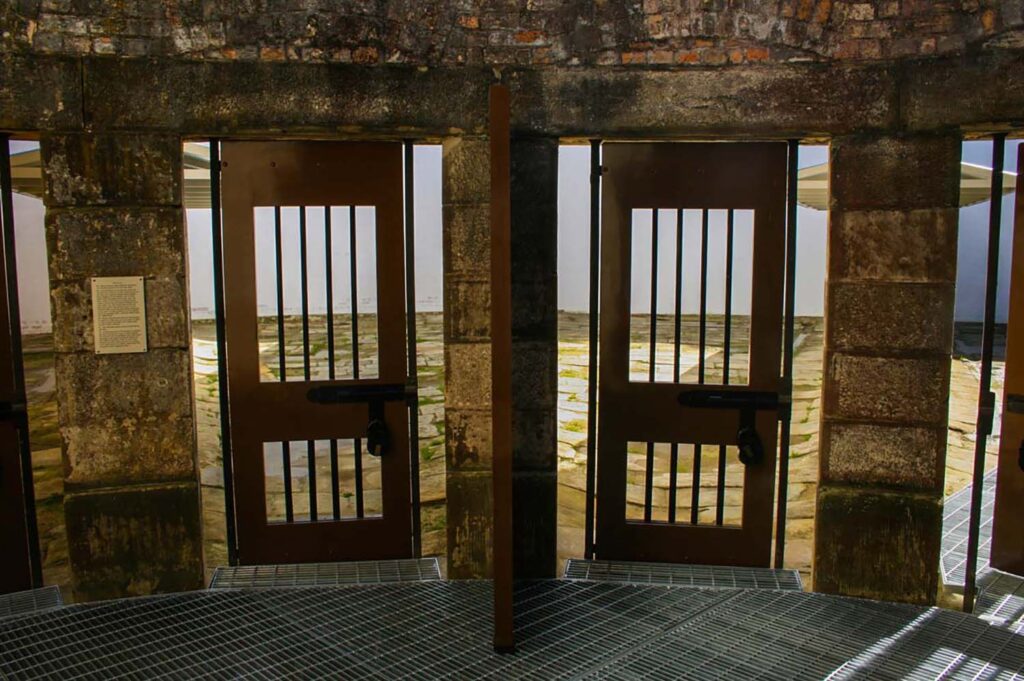
I have a complete guided tour of Port Arthur if you’re interested in having someone lead you on your way throughout the site. This way you can learn stories all about the history of each of the buildings inside the convict site.
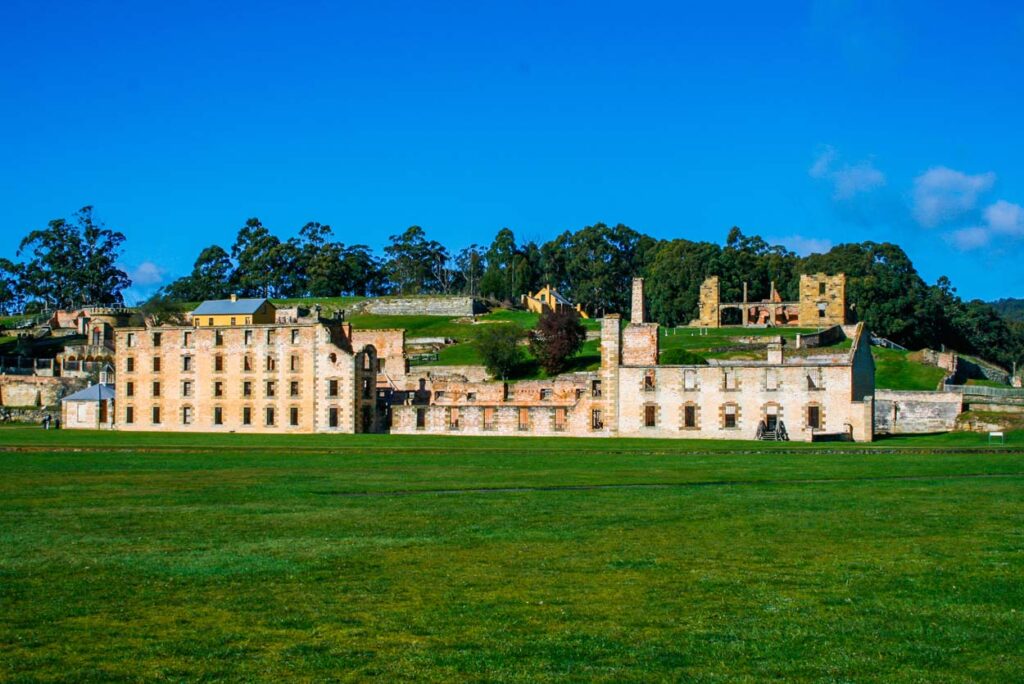
Rosedale Homestead
After you’re finished at the historical convict site, grab a spot of lunch at the Rosedale Homestead. The homestead is owned by an Aboriginal Tasmanian family who has created a charming animal sanctuary and tasty restaurant that focuses on local delights. Eating here really feels like you’ve been invited right into a family kitchen, and the friendly atmosphere here just can’t be missed!
Tasmanian Devil Zoo
Before leaving this peninsula, it’s worth making an early morning stop at the Tasmanian Devil Unzoo just a minute down the road from the homestead. A “un” zoo, you say? What on earth is that? The zoo owners Jon Coe and Ray Mendez wanted to create their vision of an animal’s natural environment that the human visitors can explore, not an environment created for the human visitors that the animals must adapt to.
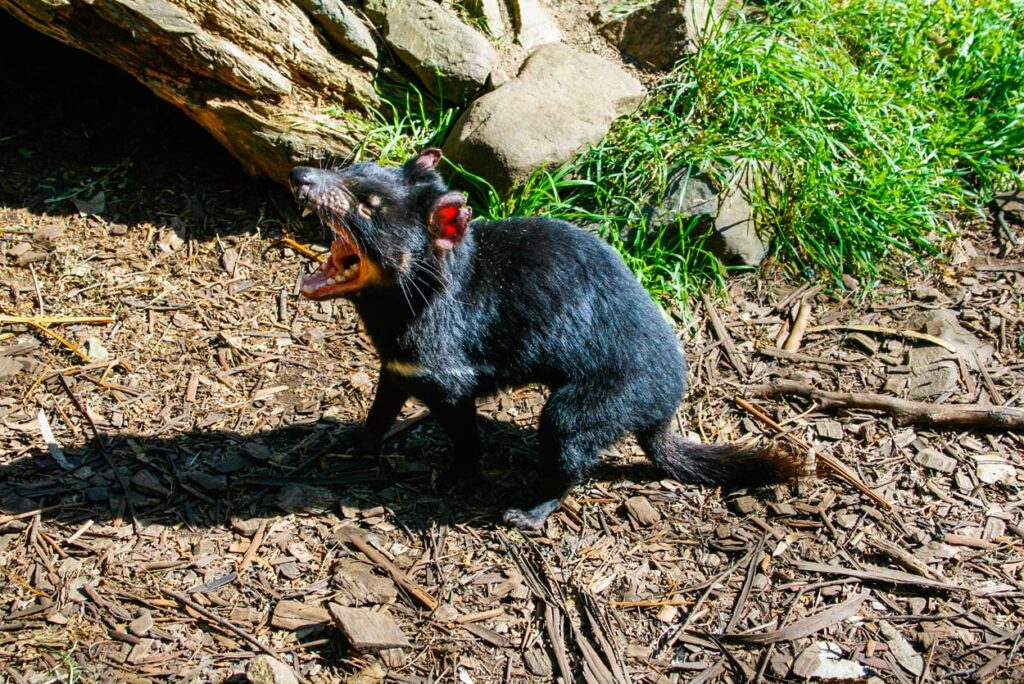
The Tasmanian Devil Unzoo is worth a visit for their namesake, the famous Tasmanian Devil. In here, you can see their habitats and many of the animals up close. They are such interesting animals and so much small than I thought they would be! If you have never had a chance to visit a free-range kangaroo field, where you can see these massive creatures in person, this zoo also has a large paddock where you can see kangaroos, wallabies and Australian hens.
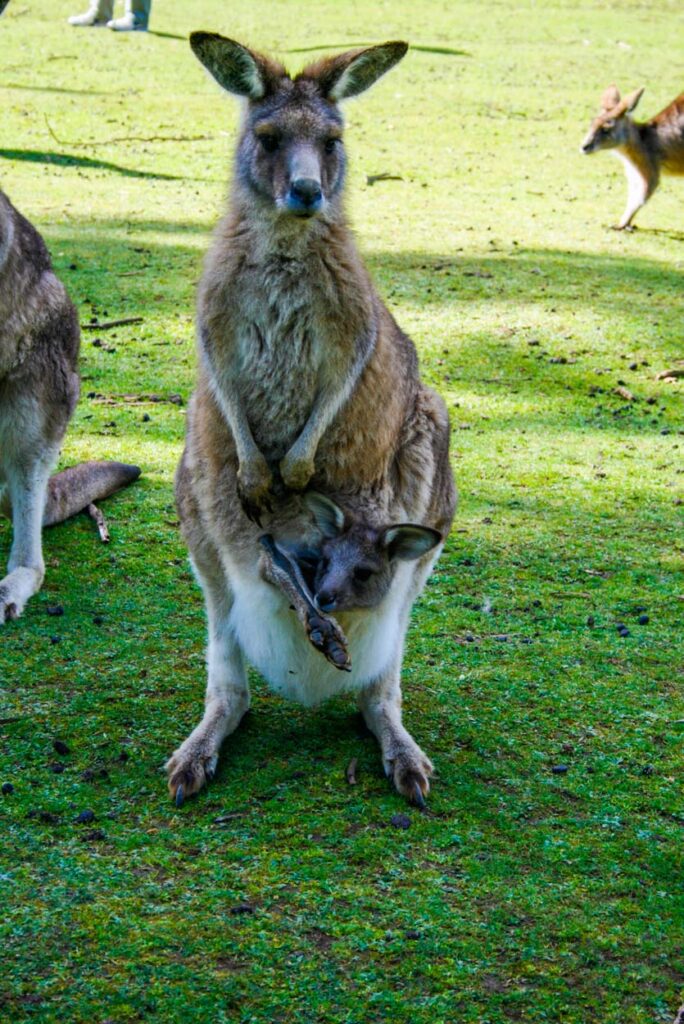
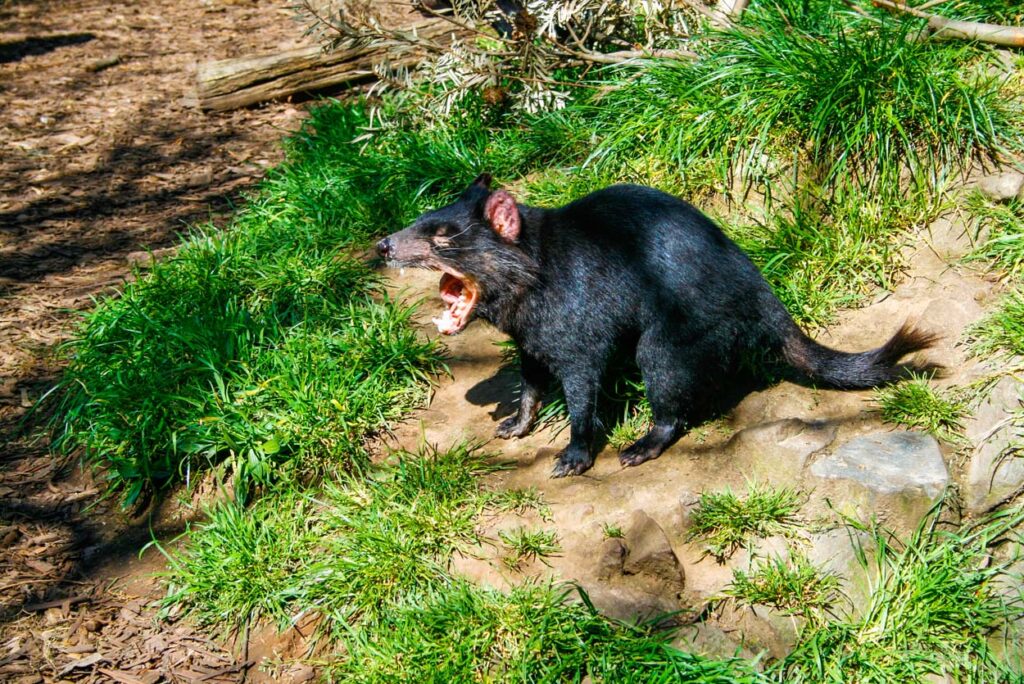
Federation Chocolate
A minute down the road, make your last stop on the peninsula at Federation Artisan Chocolate. Federation Artisan Chocolate has been an iconic foodie establishment in Tasmania for over 30 years! Their chocolatiers have been crafting innovative and ever-evolving handmade chocolate praline and truffles for years, all made with local ingredients. Their unique flavours include hazelnut praline, wildberry and pistachio, Tasmanian peppermint crunch, espresso martini, Hellyer’s whisky and my favourite, Tasmanian lavender!
Richmond Bridge
Continue along the A9 Highway through the Woodvine Nature Reserve. Travelling west towards Hobart, you will pass across the famous Richmond Bridge. Richmond is a beautiful little place for a pitstop just outside of Hobart. The Richmond bridge is a heritage-listed bridge built by English convicts in 1823 and, therefore, the oldest stone bridge in Australia! While the bridge is magnificent and placed in a scenic location, it is perhaps its darker past that makes it so well known. In 1832, George Grover, an employee at the nearby Richmond Gaol, was murdered on the bridge. Grover was known to be very cruel to the prisoners. Although no one was convicted of his murder, he had many well-known enemies. His ghost is thought to haunt the bridge to this day.

Richmond Village
It would be a shame not to pass through Richmond and not hop out of the car for a few minutes to walk around this historic and charming little village. Richmond has been relatively untouched by the modern changes that came to bigger cities like Hobart. It, therefore, retains its Georgian colonial architecture would have looked like once all cities around Tasmania would have looked. It feels like a living museum.
My favourite building is the old Richmond Arms Hotel with its fantastical lace wrought-iron verandah. The building was constructed in 1827 for James Buscombe, who aimed to create a pub that would serve the growing population of Richmond and all the passersby who were travelling onto Hobart. Despite passing hands and changing names over the years, the building still serves local drafts in a friendly atmosphere. Their outdoor beer garden is such a great place to sit and enjoy the warm weather and beautiful surroundings.
Pooley Wines
Just down the road from Richmond are the vineyards for the award-winning Pooley Wines. This winery is located in the heart of Tasmania’s famous wine-producing region, the Coal River Valley. This is the steepest vineyard site in the coal river valley. The rich and fertile soils and the afternoon sea breeze and prevailing winds result in a smaller variation between day and night temperatures which aids grape production. Pooley Wines is located on a historical property which is one of the loveliest places to wander around. For only $5 per person, you can enjoy local cheeses and charcuterie along with a varied selection of wines from the estates.
Arriving in Hobart
After finishing up at the Winery, it’s time to leave the countryside behind and head into the great city of Hobart. One of the most beautiful aspects of Hobart is the fact that there are so few high-rise buildings that creep across the city. This building limitation was put in place due to Hobart’s proximity to the River Derwent and Mount Wellington/kunanyi. This was due in part to the fact that the government didn’t want to ruin these incredible vistas with views of stark steel towers. The results in the peaceful seaside village we find today. Despite being an urban centre and having all those amenities, Hobart still feels like a secret treasure.
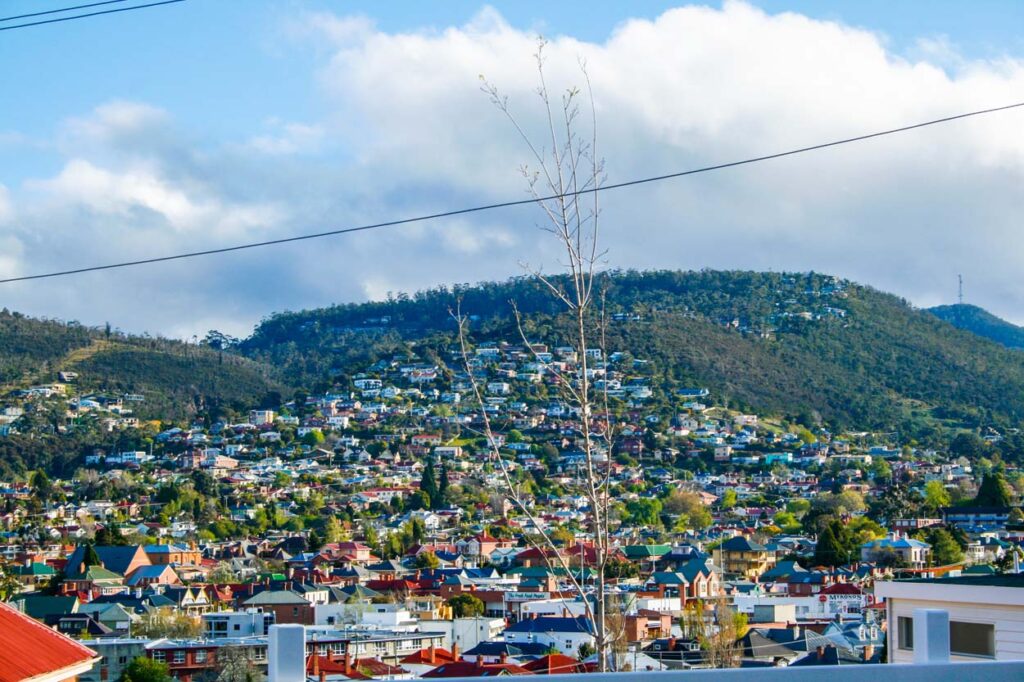
Franklin Wharf
Drop your things off at your hotel and head out to the docks to grab yourself some dinner! Walk along the Franklin Wharf waterfront. The historic buildings along this street are stunning, one of which is the old Marine Board. Franklin Wharf is the Hobart’s Waterfront where fishing and sailing boats dock, both now and in years past. It is also where you can find some of the best seafood restaurants and cafes at very reasonable prices!
Heading South Sculpture
So much of Hobart is home to random sculptures and art installations that seem to pop up out of nowhere. And the docks aren’t any different. You’ll find the ‘Heading South Sculpture‘ group along the water’s edge towards Hunter street. The first sculpture you see is called ‘The Bernacchi Tribute.‘ Louise Bernacchi was a scientist, photographer, and writer, and he is seen here with his trusty husky dog Joe, holding the flag. Bernacchi was the first Australian to spend and document a winter in Antarctica. In the sculpture, we catch Bernacchi taking a picture (or selfie as we know it today) of himself as he marks his accomplishment.
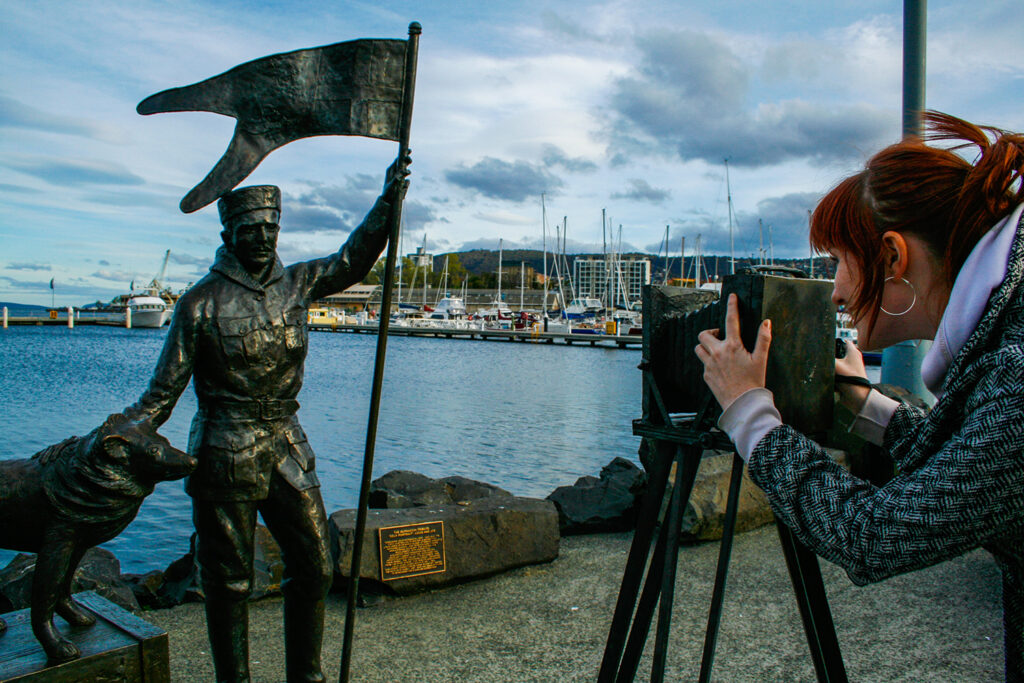
Behind Bernacchi, we find the bronze sculpture of a group of seals and penguins made by Stephen Walker. This scene is meant to memorialize English explorer James Clark Ross and his role in the 19th-century Antarctic expeditions. Ross sailed from Hobart to Antarctica in 1840. Later, in 1845, Ross set out with Sir John Franklin to help lead his expedition to discover the North-West Passage. Although we both know now how that ended for both explorers.
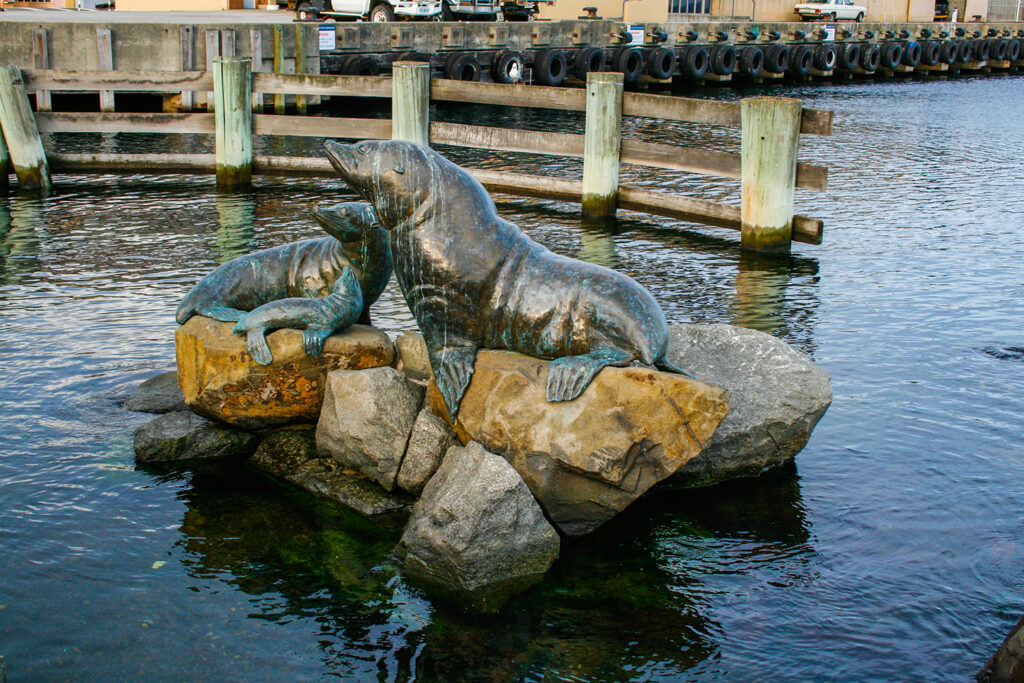
Elizabeth Street Pier
Elizabeth Street is one of the major street that runs southeast to the northwest through the downtown and into the suburbs. But the famous street ends right here in the harbour. The Governor of New South Wales named Elizabeth Street after his wife, Elizabeth Macquarie. The original Elizabeth Street Pier was in built 1866, but this new concrete structure was built in 1933. Today, the covered pier serves as a space for restaurants, bars and event spaces.
Fish Frenzy
When I first visited Hobart, I was a young student and was eager to find somewhere to eat great seafood at low prices. No trip to Hobart is complete without some fresh seafood, and even students deserve to try it out! Lucky for me, Fish Frenzy was recommended to me over and over again as the best place for cheap and delicious seafood. It makes me so happy to see they are still wildly popular. Fish Frenzy serves amazingly fresh fish and chips with seafood caught directly from local fishermen. They also serve incredible grilled seafood, chowder, and my personal favourite, Tasmanian scallops. And the best part is you can dine outdoors along the waterfront. Sitting here enjoying your catch of the day is the best way to take in the fantastic views of Hobart’s waterfront.
Lady Nelson Tall Ship
Located right outside Fish Frenzy is the historic Lady Nelson tall ship. To be fair, this is a replica of the historic ship that people still use regularly today! It sets sail from this dock and heads out along the Derwent River. The original HMS Lady Nelson was commissioned in 1799 to survey the coast of Australia. At the time, large parts of the Australian coast were unmapped, and Britain had claimed only part of the continent. This ship would be the first to seal all of Australia for the British. The ship’s crew were also the first to establish settlements on the River Derwent, at Port Dalrymple in Tasmania.
Constitution Dock
Constitution Dock has been used to harbour fleets in Hobart since its founding in 1804. It is still used today by fisherman who docks here to sell their catch of the day. Walking around this area and the adjacent Fisherman’s Dock, you’ll find that pretty much every single building is a fantastic seafood cafe or restaurant! There is no better place to come for seafood lovers!
Mures
A Hobart institution that I loved coming back to, night after night, was Mures. Jill & George Mure established Mures Fish House in 1973! Back then, it was located in Battery Point but to ensure the fish’s freshness, they moved the location right to the source on Fisherman’s Wharf. One of the most interesting things about Mures is that they have two different areas of the restaurant; the upper and lower deck. The Lower Deck is where you’ll find the quick-service restaurant serving up their famous fried fish and seafood paired with their world-class chips. But another seemingly strange addition to the lower deck is their cafe with 32 flavours of ice cream! Despite being primarily a seafood shop, their ice cream is AMAZING! You can either eat your plunder inside in their gorgeous mural-covered interior or outside where you can watch fishing boats come in and go out to sea.
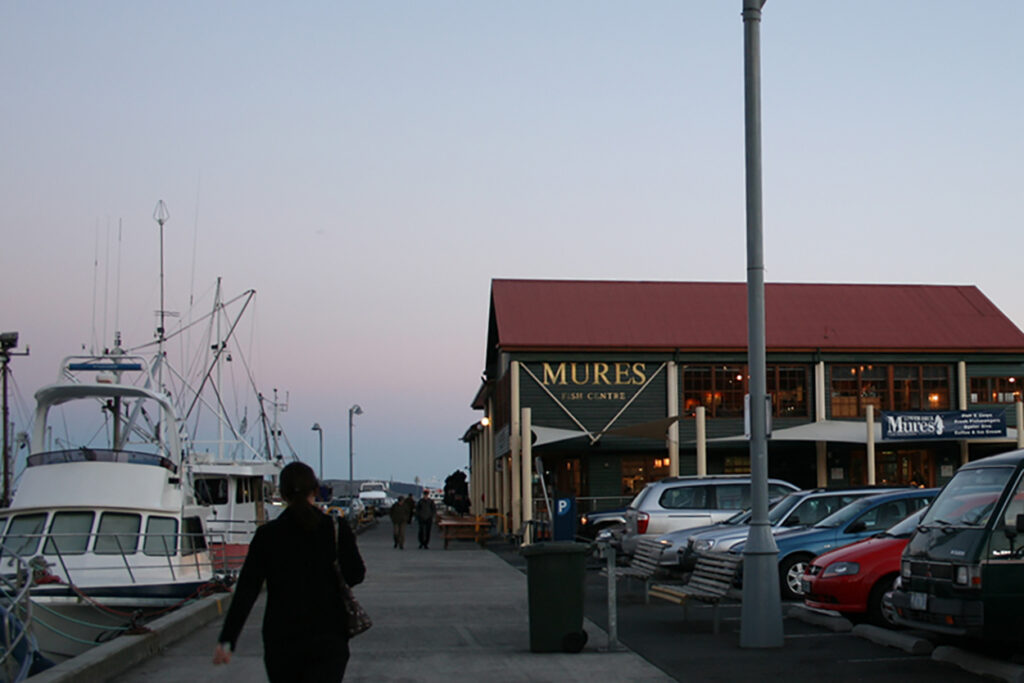
The Upper Deck is their fine dining restaurant. Here you can experience the ultimate seafood experience in Hobart. This is a great place to try fresh Tasmanian pacific oysters! You can also sample Tasmanian octopus, Bass Strait squid, Tasmania rock lobster, and local spring bay mussels. Despite being a fine dining restaurant, the prices are shockingly affordable for the incredible quality and freshness you get!
Drunken Admiral
The best place to end your day in Hobart is inside the Drunken Admiral! While this restaurant and bar might seem too touristy to be legit, don’t let the kitsch factor dissuade you. The restaurant is decorated to look like you are drinking inside a haul of a pirate ship. Ropes hang from the walls, and the ceiling even appears to be made of the ribbing of a giant ship. The are nautically themed objects all over the place, covering almost every inch of the surface. Some of them are antiques, others are new creations, but it’s almost impossible to tell which ones are which.
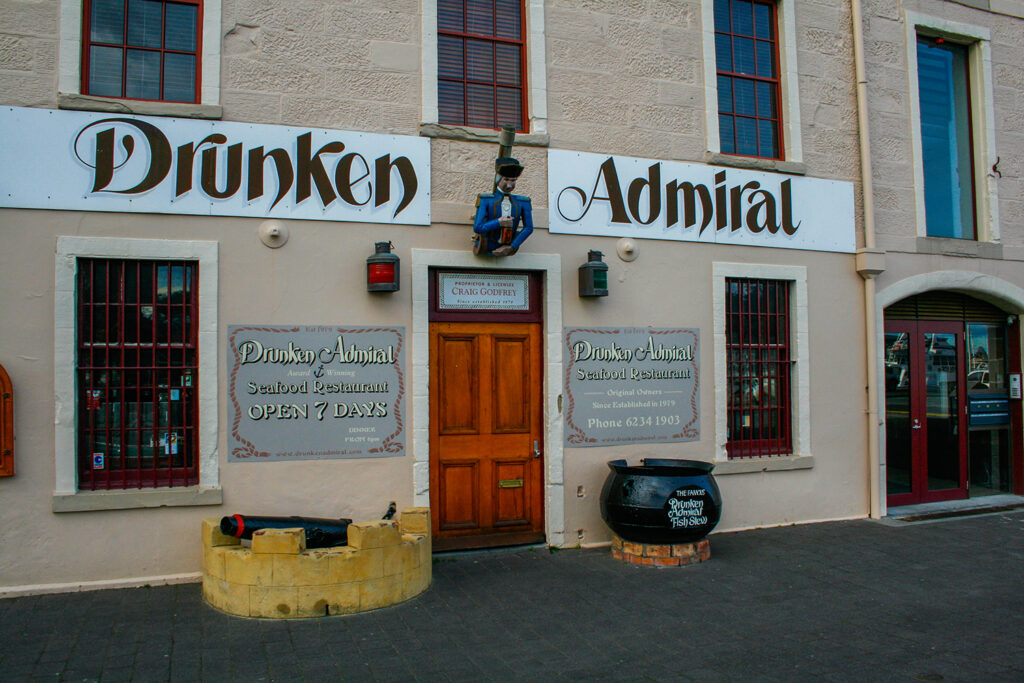
Their beer and wine lists are staggering, so it’s a wonderful place to come to sample locally made spirits of all sorts. But it’s the friendly environment inside this place that makes it so special and the best place to wile the night away.
Day 7 – Exploring Hobart
To end our week in Tasmania, we spend our last day touring the city of Hobart and the famous Mount Wellington/kunanyi.
Battery Point
Start your morning off right in the historic neighbourhood of Battery Point. This area is one of Hobart’s most peaceful and beautiful districts, and I love wandering the streets in the early morning. You’ll find the least tourists out and about this time of day, and the area takes on a more authentic neighbourhood feel. I adore wandering aimlessly and watching the locals mull about doing their morning tasks.
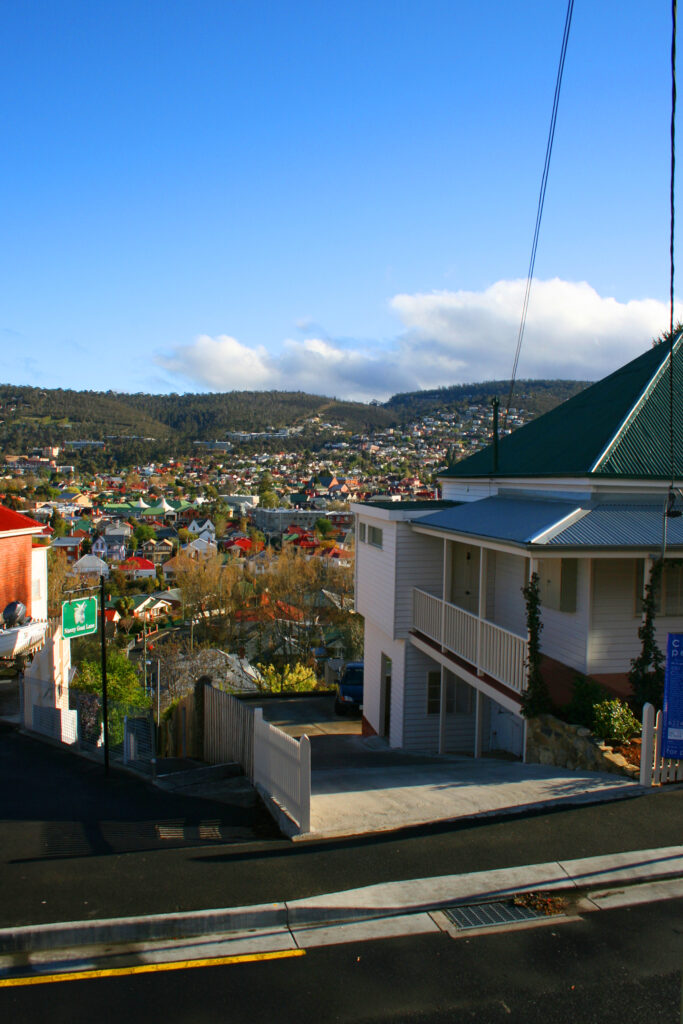
Princes Park
Start your tour of Battery Point inside the peaceful Princes Park. The name “Battery Point” was due to the fact that the first Battery was built here in 1818 as a part of Hobart’s coastal defences. Although the Battery was well stocked with guns and ammunition, the defences were never called upon to withstand an invasion. Instead, the Battery was mainly used for ceremonial salutes. The Battery was officially decommissioned in 1878 and turned into a lovely park for the residents in 1934. Princes Park is the perfect place to start the day as it is located on a lookout over the gorgeous River Derwent. Princes Park is also home to some beautiful lush trees, representative of that iconic flora and fauna that makes Tasmania so unique.
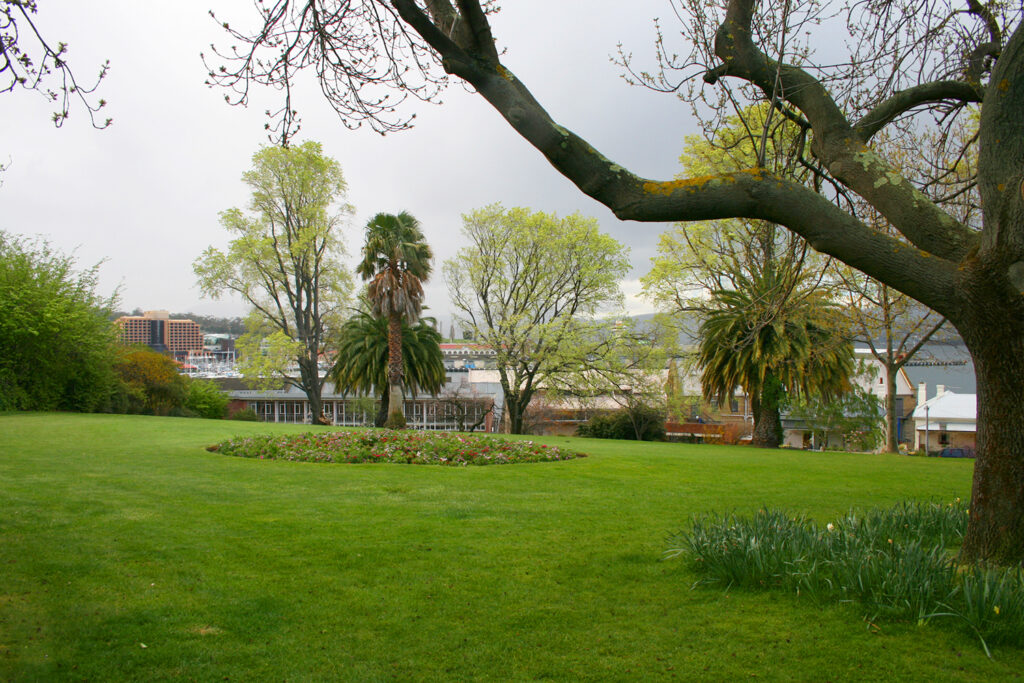
Battery Point Historic Homes
After meandering around Princes Park, take a walk along Hampden Road. This street winds up the hillside, climbing higher and higher. As you go, you’ll catch more and more views of the towering Mount Wellington/kunanyi overhead. On either side of the street, you can spot a myriad of different styles of colonial cottages. Keep an eye out for the eave-free homes. These are some of the oldest in the area and have been here since the colony’s establishment. In 1973, the Builders Labourers Federation established a “green ban” on the destruction of the historic building. This ban ensured the historic homes were preserved for future generations. The everyday Tasmanians who own these homes take great pride in keeping them prime and proper and their gardens are almost as glorious as the houses themselves.
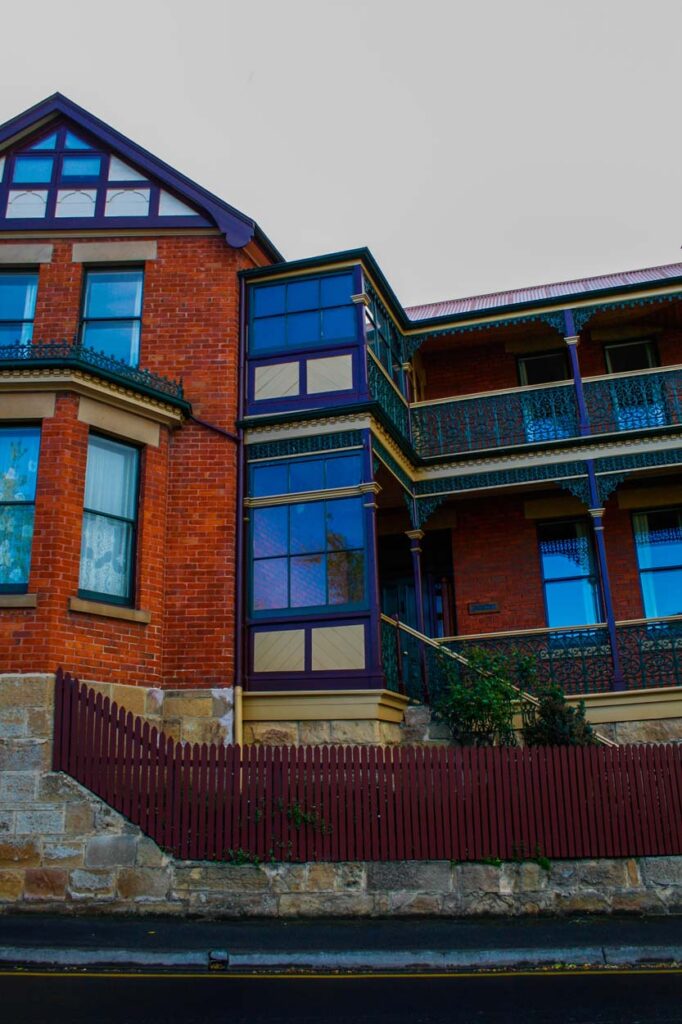
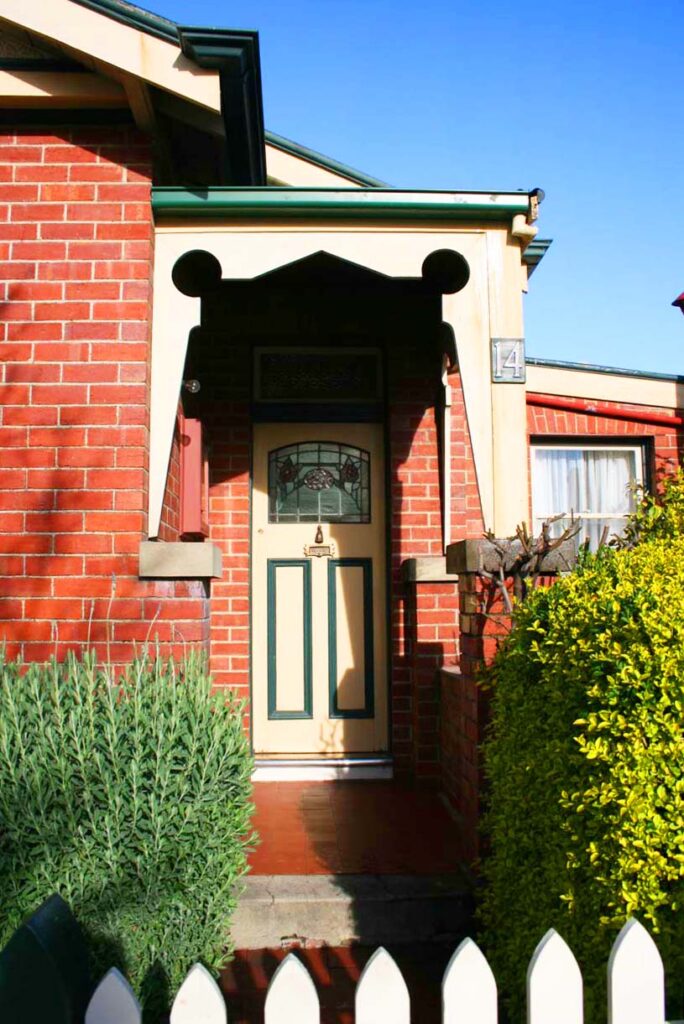
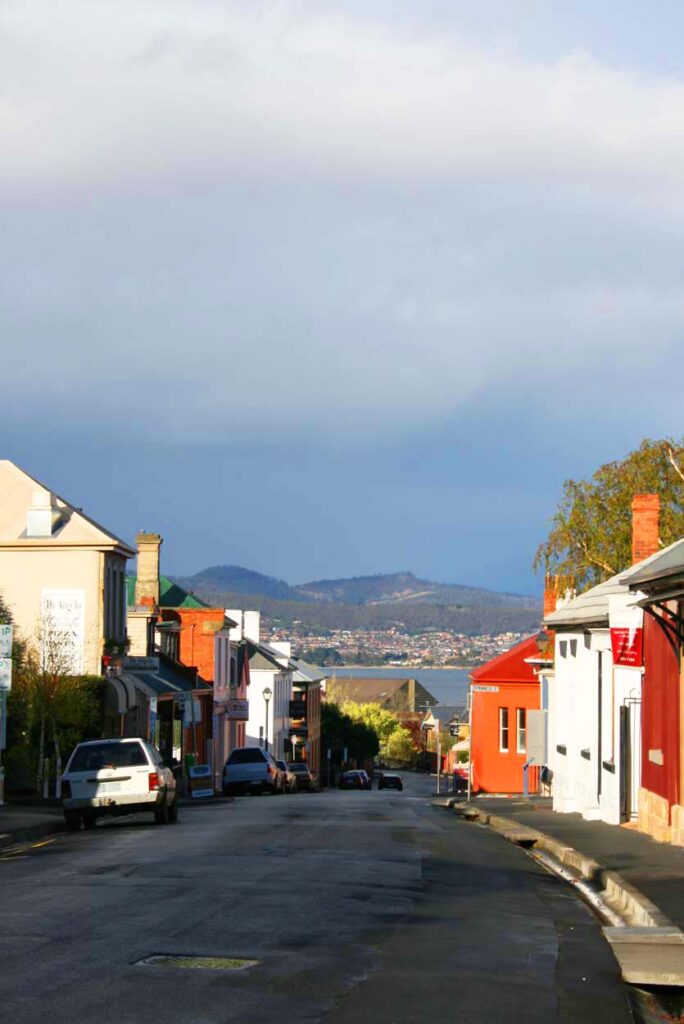
Runnymede Street & Arthur Circus Park
For a moment, turn off Hampden Street to explore Runnymede Street, a small circle that surrounds the quaint Arthur Circus Park. The houses surrounding the park are old cottages. These homes were originally constructed for the garrison officers of the Battery. An iconic architectural element to keep your eye out for around here is the “iron lace” verandas. This style of wrought iron is a feature of many buildings in the area and in colonial Australia. In 1870 Australia established its own iron factories, influenced by the Victorian ornamental iron designs they saw in magazines from England. Australians adapted this style for themselves and having an iron lace terrace was a sign of your status in Australian society.
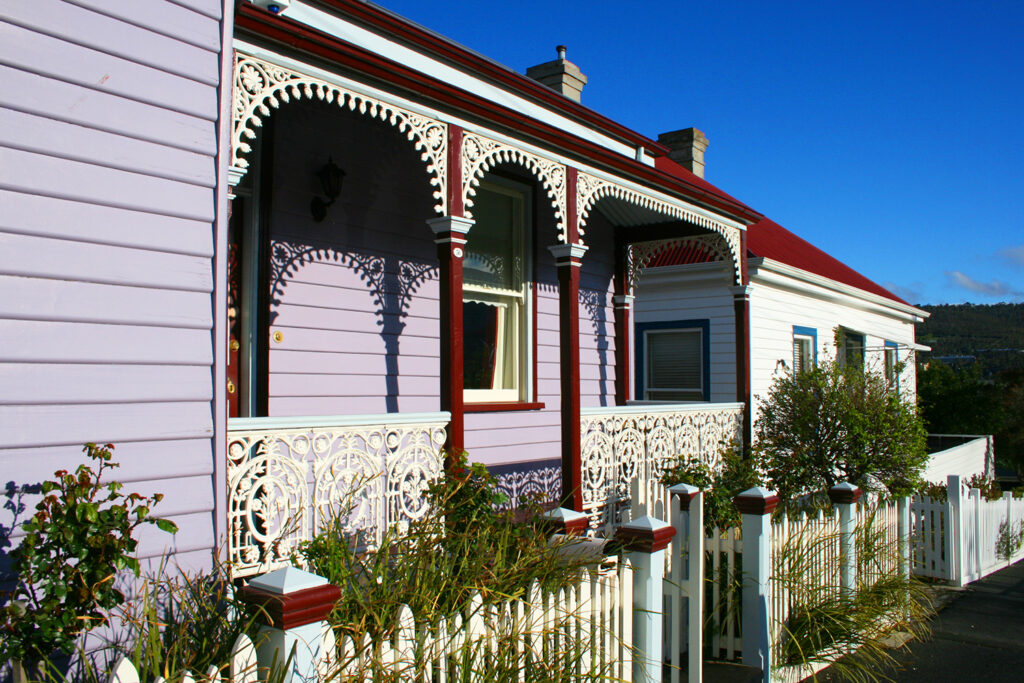
Jackman & McRoss
Located in the heart of the community is the popular cafe Jackman & McRoss. Jackman & McRoss feels like a quintessential Australian cafe, but with a gourmet twist. Their most popular item is the iconic Australian staple: meat pies. But unlike the mystery meat pies you get in truck stops, these pies come in flavours like; goat & lentil, blue eye fish korma, lamb & rosemary and even scallop pie, with shellfish caught right from the Tasman sea.
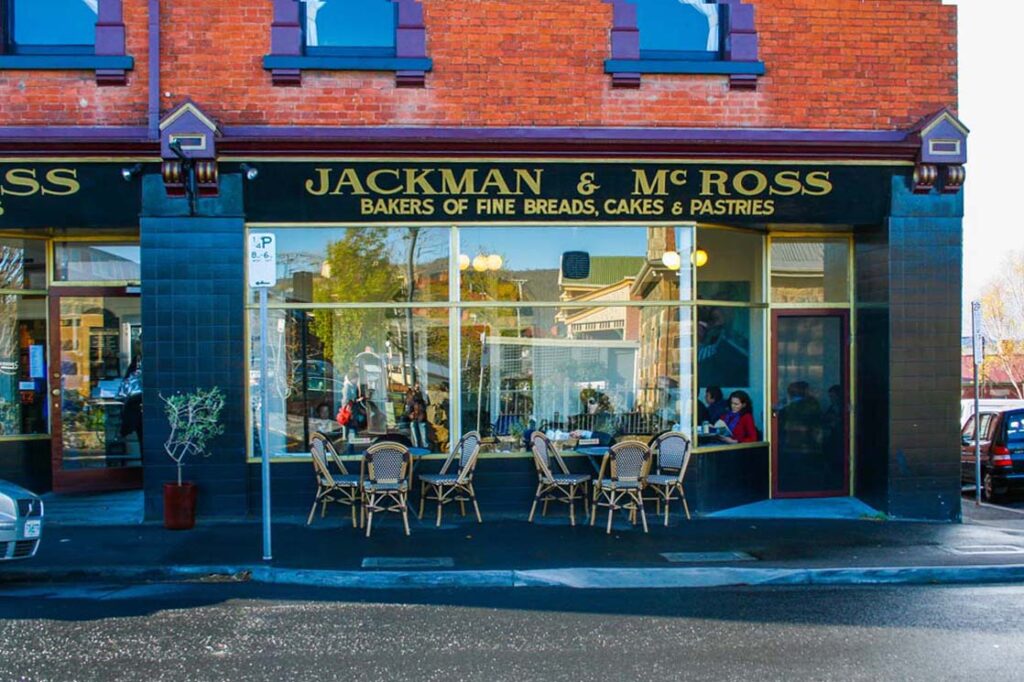
If sweets are your morning preference, then they have you covered as well. You’ll be drooling over the gorgeous window displays of all their sweet creations. Always go for whatever is labelled “seasonal” as these items are extra special. You can opt to grab your food to go and eat in one of the many beautiful parks around the area or sit inside and watch the locals come in and out for their morning brew.
St. George’s Anglican Church
From the cafe, head up Waterloo Crescent, then down Colville Street and over Cromwell Street to find your way to St. George’s Anglican Church. Although this is a little bit of a roundabout way to get here, it is the best route to see some of the most amazing historic streets along the way. St. George’s Anglican Church is a Greek revival church built to serve Battery Point residents in 1838. English architect James Blackburn designed the classical tower in 1847. The tower is one of the most impressive parts of the church and a worthy addition.
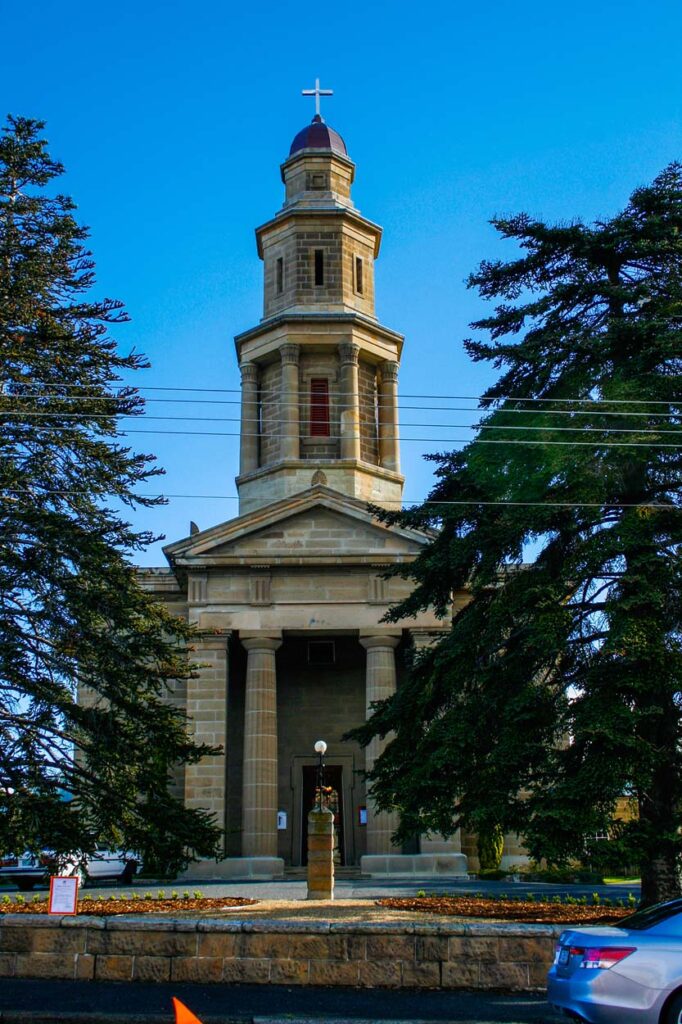
Nanny Goat Lane
Nanny Goat Lane is home to one of the best spots to get an amazing view across Hobart. This steep and skinny set of steps is essential to help residents make their way from Quayle Street to St Georges Terrace. These little shortcut steps can be found all over the city. Originally, many of these access points were made by the residents themselves and not the city. But in recent years, they have become both historical and accessible assets.

St. Georges Terrace
Continue along Cromwell Street and down De Witt Street until you reach St. Georges Terrace. Standing on the corner of St. Georges Terrace and Colville Street, you have the most incredible view of the water to the left and the sprawling city, crawling over the hillside to your right.
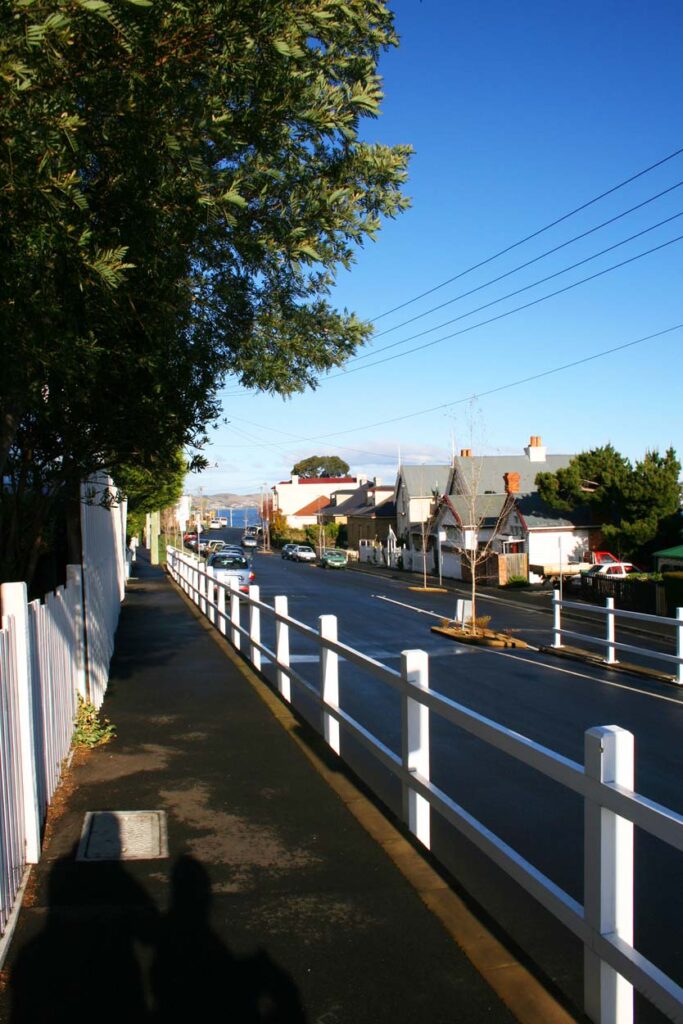
Narryna Heritage Museum
Turn around and walk west along St. Georges Terrace and back north along Sandy Bay Road. Then turn back onto Hampden Street to visit Narryna Heritage Museum. The Narryna Heritage Museum is a delightful place to visit to explore what the interiors of a 1830’s style merchant house would have looked like. Designs and furnishings from early colonial Tasmania have been preserved here. The house and their collection help tell the story of life in Tasmania for those early settlers. The Georgian townhouse was built by the seafarer, Captain Andrew Haig. Haig also built the famous Salamanca warehouses in 1834.
Admission: 10 AUD for adults and 4 AUD for Children.
Hours: Tuesday to Saturday 10 am – 4 pm | Closed Mondays and Sundays
Kelly Street & Steps
Walk along Hampden Street until you reach Kelly Street. Kelly Street was named after James Kelly, an explorer who circumnavigated Tasmania in 1816. And in only a 5-oared whaling boating nonetheless! Kelly went on to become a whale-oil merchant. Back then whale oil was one of the highest-selling commodities of the Hobart ports. To export the oil, he needed to employ shipwrights, sailmakers, ship chandlers, coopers to make barrels, smiths, wharf labourers, and watermen to ferry the cargo. These men needed to live close to the warehouse, so Kelly took his huge plot of land and subdivided it into smaller cottages for her workers. You can still see many of these old cottages today.

But the most important part of the street is the famous Kelly Steps. The steps were also made by Kelly in 1839. He wanted a shortcut for him and his workers to access the warehouses in Salamanca Place from their homes in Battery Point. The steps were carved into the hillside and from the top provide a stunning view out towards the piers. As the steps were carved almost 200 years ago, they weren’t quite made to code and are very steep, so those with mobility issues should traverse down to Salamanca Place via nearby Runnymede Street.
Salamanca Place
The steps guide you right to the center of Salamanca Place. These rows of simple, sandstone buildings were once the former warehouses that served the enormous marine industry, that was the Port of Hobart. The area was previously called “Cottage Green” but renamed in 1812. It was named Salamanca after the victory in the Battle of Salamanca by the Duke of Wellington. As the whaling and shipbuilding industry dried up and the port became less and less frequented by ships, the warehouses were transformed into a trendy space for restaurants, theatres, galleries, cafes and shops.
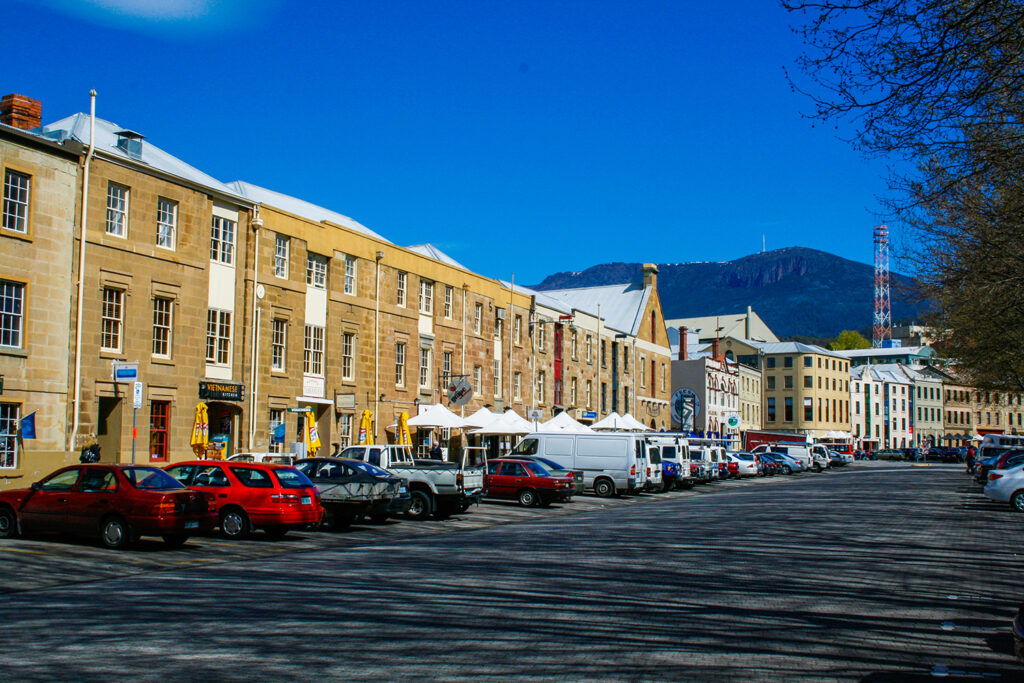
Salamanca Market
The best time to visit Salamanca Place is on Saturdays for the Salamanca Market. Every Saturday, hundreds of vendors come here and pop up their market stalls. Locals come here for fresh produce collected from all around Tasmania. Everything from delicious baked goods, fresh fruits and veg and friendly florists selling bouquets of brightly coloured flowers. Tourists will enjoy all that as well as the crafts and gifts made by local craftspeople. But best of all is the cheery atmosphere local markets provide. The market runs from Salamanca Lawns to Salamanca Place and is open from 8:30 am to 3 pm. This is a great place to get some food for lunch and eat it picnic-style in one of the nearby parks.
Food at Salamanca
My favourite place to grab a cup of coffee or a delicious brunch is Machine Laundry Cafe. This retro fantasy cafe is located inside the old interiors of a laundry mat. Instead of removing the old machines, they left them on display and in fact, you can still do your laundry here while enjoying your breakfast! A double load will cost you $5 AUD and the dryer costs $1 AUD for 7 minutes. If you’re travelling for a long time and need some laundry done, you cannot miss doing it here! Plus the food is incredible, the perfect hangover cure!
If you want something sweet, check out San Churro Salamanca. Since the area is named after a place in Spain, it seems fitting to find a Spanish Churro shop in the middle of the old warehouses. This place serves up pipping hot, fresh churros served with traditional cinnamon sugar and a side of melted chocolate for dipping! Honey Badger Dessert Cafe is another fantastical brunch restaurant that serves up some decadent breakfast sweets. Try the pancakes or cheesecake covered in candy floss for those of us with a real sweet tooth.
Salamanca Arts Centre
Wanders into the Salamanca Arts Centre to peruse the incredible works of art found inside. Unlike a traditional art gallery, this place is free to visit and an amazing way to explore up-and-coming local artists as well as get a sense of the vibrant art style Hobart is famous for!
I’m a HUGE used book lover, so I adored Deja Vu Books inside the arts centre. This place is a treasure trove of books that wobble from the floor to the ceiling. Aspect Design is a wonderful gift shop inside that supports local Tasmanian artists and craftspeople. Everything is made using local materials and is the best place to pick up something to remember your trip with.
St David’s Park
Continue along Salamanca Place street, passing the Supreme Court of Tasmania. Just opposite the Supreme Court, you’ll find the entrance to St David’s Park. Marking the entrance to the park are the two large lion sandstone sculptures. Their paws clutching onto the column capital. These were a gift for the Hobart bicentennial from an Australian and New Zealand Banking Group. You might spot the image of the lion all over Tasmania. This is because the Tasmania flag has a white disk with the image of a red lion in the center. Throughout the English-style park, there are lots of pretty sandstone sculptures, gorgeous pergolas, and lush Tasmanian flora and fauna.
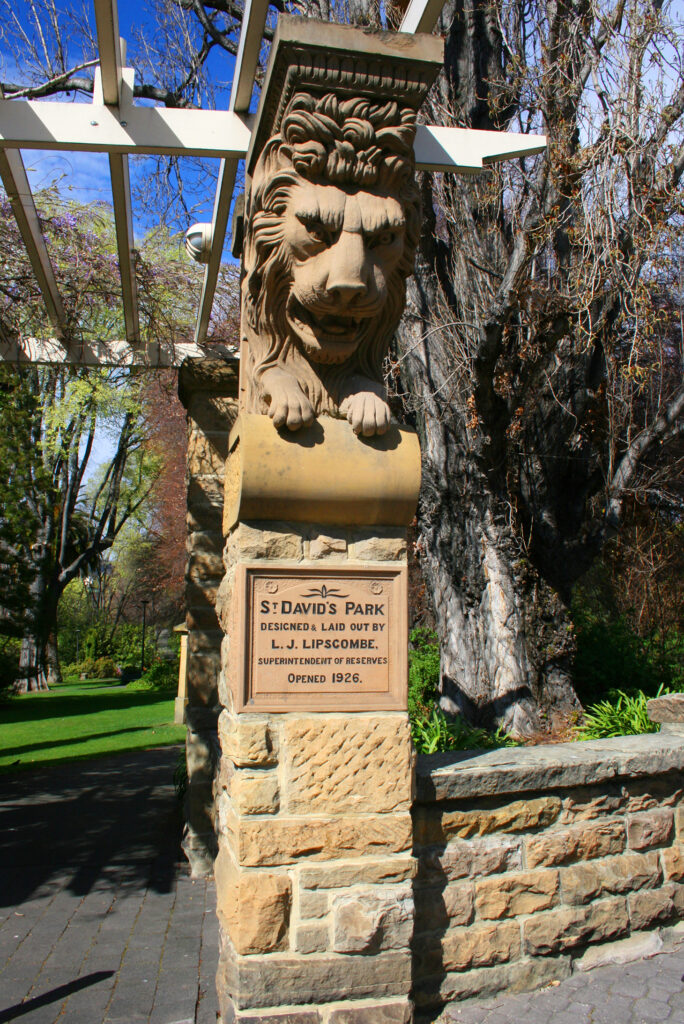
St David’s Cemetery
While strolling through this peaceful park, many visitors are unaware that under their feet sits the grounds of an old cemetery. St David’s Cemetery was first established here in 1804. The site was thought to be perfect as it was a tranquil part of town with scenic water views. But it was also located a ways away from the residential area of Hobart Town. Many of Hobart’s founding citizens were buried here after serving in the new colony.
As the neighbourhood around the cemetery was built up, many residents became uneasy living close to the corpses. Health officials also voiced concerns about the health risks of this proximity. So, the cemetery was closed in 1872 when the Cornelian Bay cemetery was opened far north of the city centre. In 1919 the town council purchased the land from the church, and the area transformed into a lush recreational park.
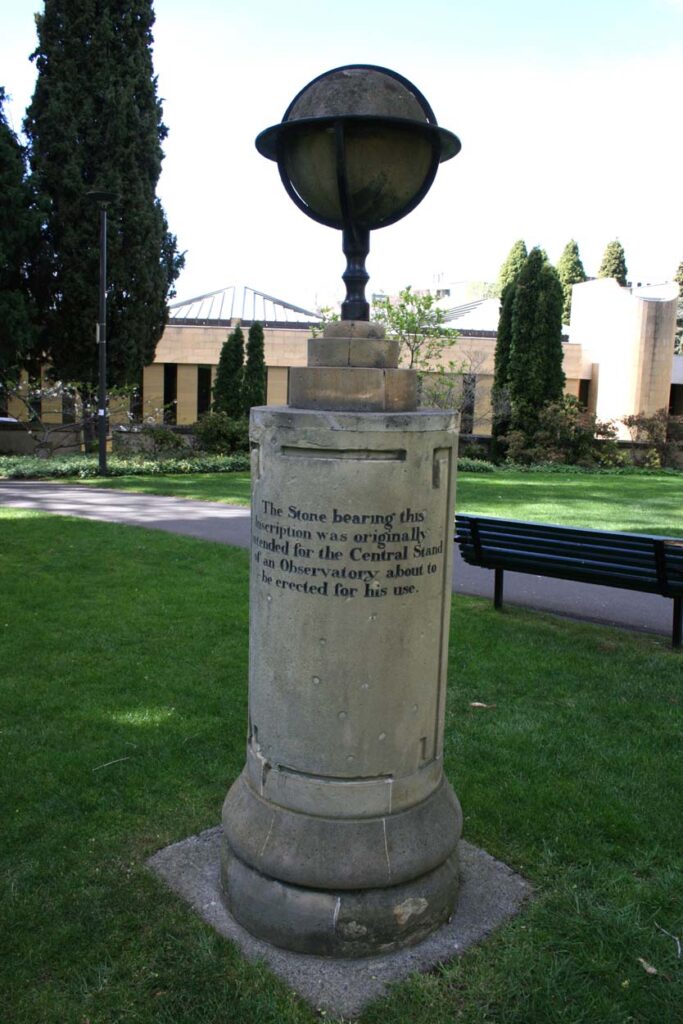
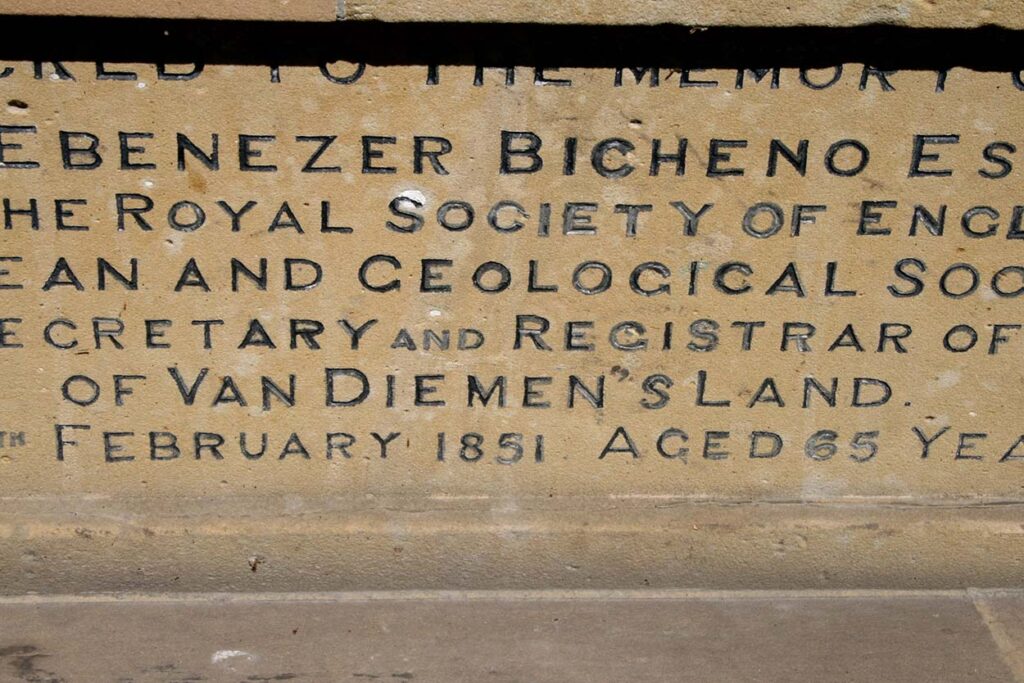
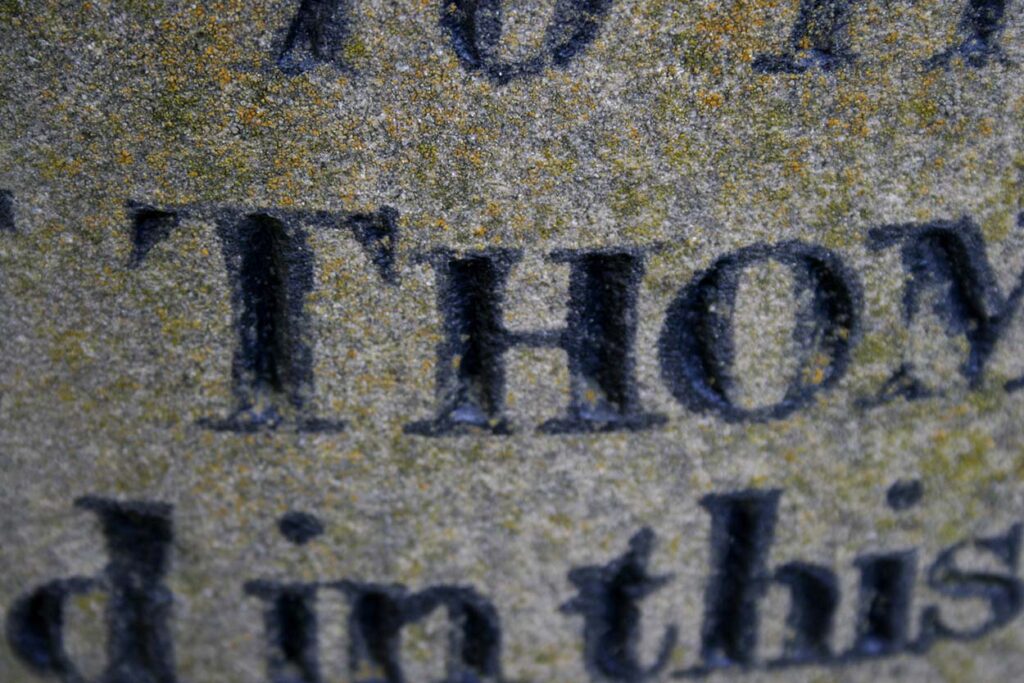
There are still 900 bodies buried in the park as only some graves were moved to the new cemetery. Today, you can still see some of these old tombstones and headstones along the memorial wall. These include the remains of David Collins, the first Lieutenant Governor of Tasmania. Taking a look at these headstones, you might notice that many are from young children. Sadly, children’s life expectancy in the new Tasman colony was very low, and many children didn’t survive into adolescence.
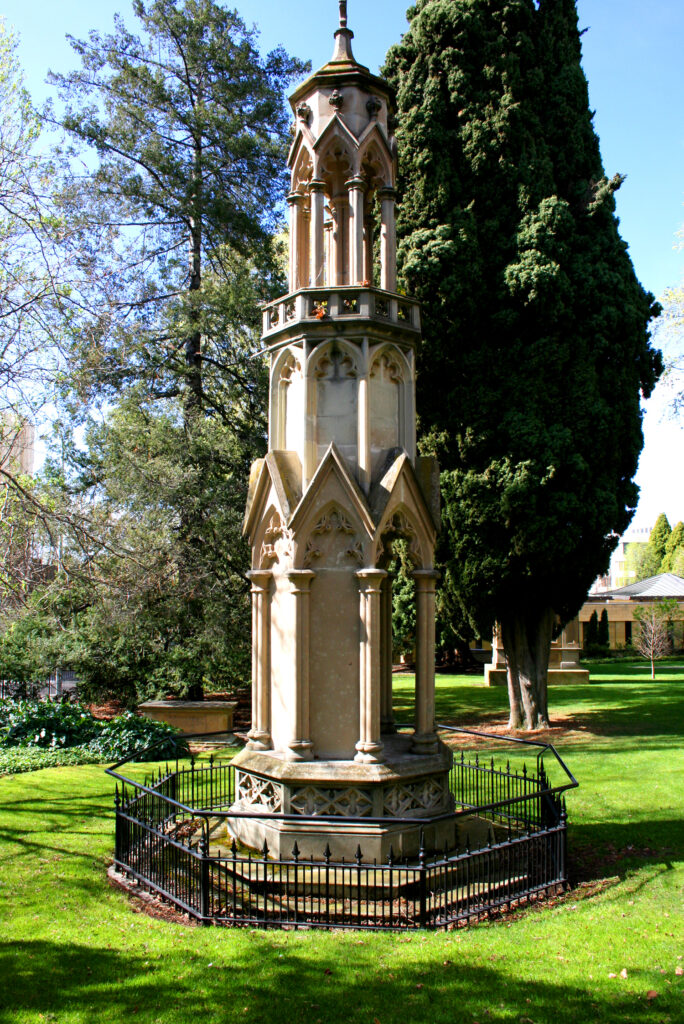
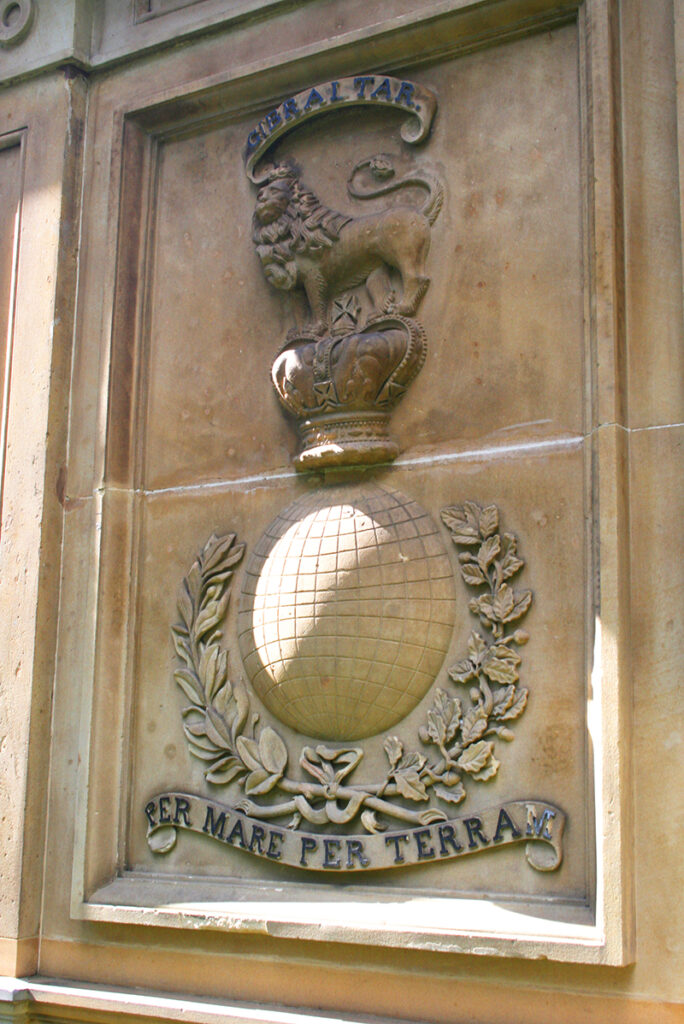
Parliament House Gardens
Walk back out to Salamanca Street and make your way to the Parliament House Gardens. On the west side of the park stands the grand Parliament House. Look up at the flag on top of the building to see the red lion for yourself we mentioned previously. In 1825 Tasmania became an independent British colony, and its administration was separate from that of New South Wales. It was here that the first Legislative Council was formed to advise the Lieutenant Governor of Van Diemen’s Land, who had sole governance of the colony. The gardens in front of Parliament House are a peaceful place to stop to rest your feet before continuing on the rest of the tour.

Customs House
On the other side of the road stands the old Customs House. John Lee Archer was the architect who designed the Customs House in 1835. The Customs House was originally used as Tasmania’s primary Parliamentary building until the new Parliament was built in 1841. The beautiful classical revival facade has been preserved and is a great example of the styles of the time. The building is now used as a pub and hostel, so you can still go inside and take in the historic atmosphere.
Franklin Square
Head North along Murray Street to Franklin Square. Franklin Square is one of the most impressive public squares in Hobart. The square is lined by oak trees on either side. The park was named after Arctic explorer Sir John Franklin. Sir John Franklin was also the Lieutenant-Governor of Van Diemen’s Land from 1837 to 1843.
In the center of the square stands a large fountain with a statue of Sir John Franklin on top. On one of the stone pedestal, you can see the words, “Not here! The white north has thy bones.” This is because Franklin was obsessed with exploring the artic and perished there instead of at home in Tasmania. In 1845 he set out with two huge vessels, the HMS Terror and HMS Erebus, to explore the Northwest Passage. The ships never returned home as they became icebound. He and all his crew perished at sea, but their death was a mystery for hundreds of years. It wasn’t until 2014 that the ships were discovered, and the mystery was finally put to rest along with Franklin and his crew.
On the east side of the park sits a beautiful sculpture called “Two Islands.” The sculpture portrays a sizeable wooden boat skeleton wrapped around a smaller metal canoe. This sculpture represents the history of the Tasmanian Indigenous people being swallowed up by the European settlers. The Two Islands sculpture also incorporates a soundscape comprised of many voices providing a dialogue revolving around reconciliation for the future.
St. David’s Cathedral
Sitting just behind Franklin Square is the domineering castellated parapet tower of St. David’s Cathedral. In 1842 Hobart was declared an official city, and the existing smaller St David’s Church became St David’s Cathedral. Construction on the current cathedral began in 1868 but wasn’t complete until 1936. St. David’s Cathedral is designed in the Gothic Revival style by the English architect George Frederick Bodley.
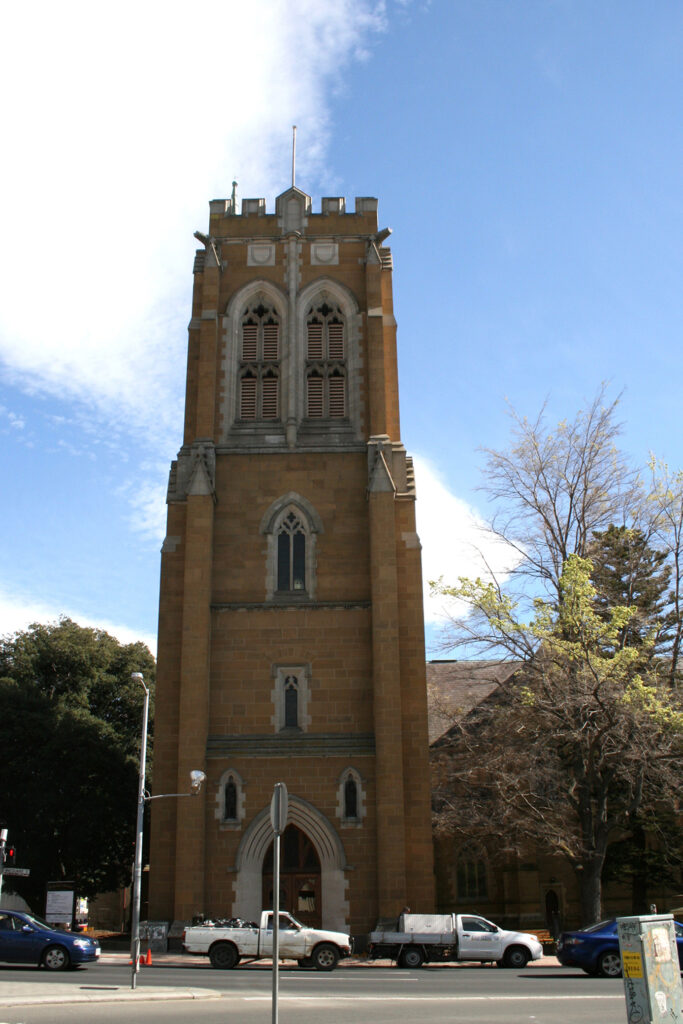
Walking inside, one of the first things I was struck by was the impressive stained glass windows. These windows depict saints, knights, kings and other biblical characters. Despite the rather simple exterior, the interior is replete with neo-Gothic quatrefoil tracery windows, buttressed turrets, stone columns supporting pointed arches and an incredible wooden vaulted ceiling.
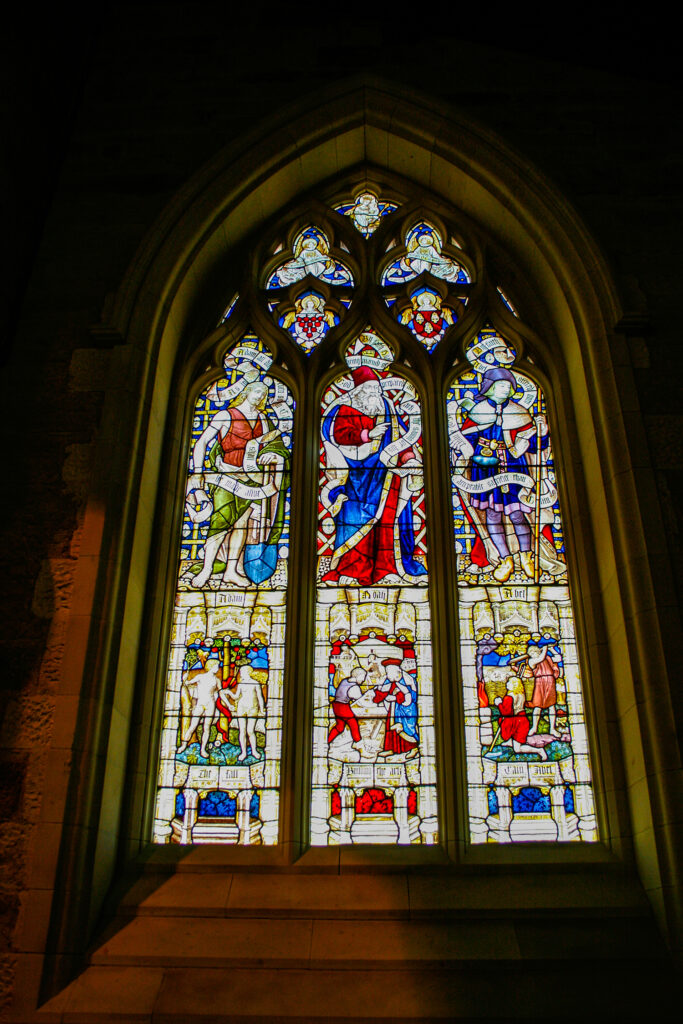
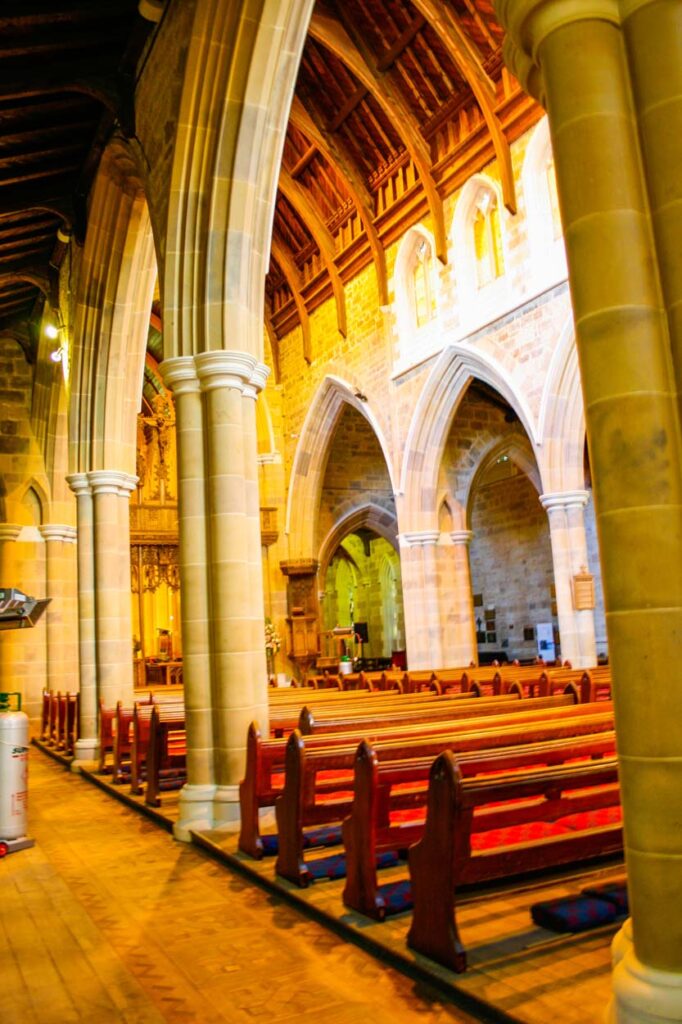
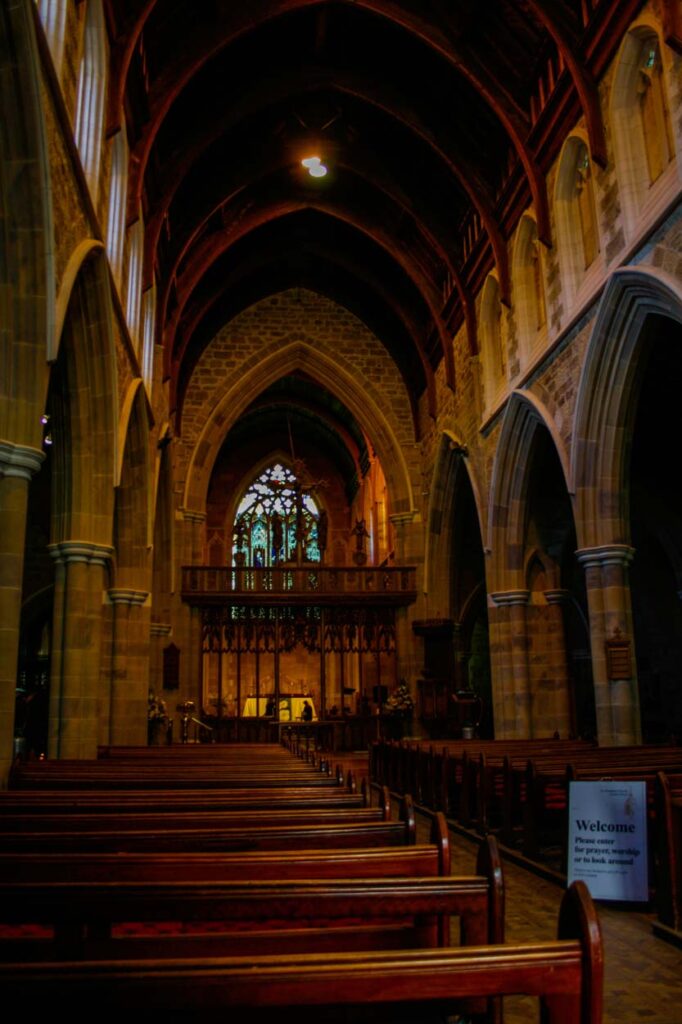
Brooke Street Pier
Walk back towards the water along Brooke Street towards the Brooke Street Pier. The Brooke Street Pier is a floating pontoon made to expand the waterfront area of Sullivans Cove. Sullivans Cove, also known as Macquarie Wharf, historically served as the main port for the city of Hobart. Sullivans Cove was the place where Captain David Collins chose to establish a new colony in 1804. He christened the area “Hobart Town.” Sullivans Cove was the ideal place to set up a colony. Its proximity to the Derwent River provided access to inland transportation, and the deep, natural harbour was protected by Storm Bay. And best of all, the area has easy access from the Tasman Peninsula into the ocean.
The Glass House
Inside this beautiful glass pier building is a series of small restaurants and shops. Appropriately named ‘The Glass House‘ offers a selection of Tasmania’s finest drinks, matched with unique shared plates. You can taste the best Tasmania wines along with freshly plucked oysters, spring bay mussels, Tasmanian scallop ceviche, Stanley octopus, and a selection of vegan and vegetarian cuisines with only the best organize produce from local farmers.
Explorer Bus
If you didn’t bring your own vehicle, you can take the Explorer Bus up to visit the soaring views on top of kunanyi/Mt Wellington. This tour bus departs directly from Hobart and takes you up to the summit. Once you arrive, you get to enjoy the panoramic views and observations shelter without doing the drive yourself! There are also a few different hop-on-hop-off options along the route. These are great if you wanted to explore any other walking trails around kunanyi/Mt Wellington. Throughout your journey on the bus, there is a commentary track from your drive. They will tell you all about the history and wildlife of the region. Your bus passes valid all day, but checks to see when the different pick-up/drop-off times and locations are.
Adult (17+ years): $35 | Child (6–16years): $25
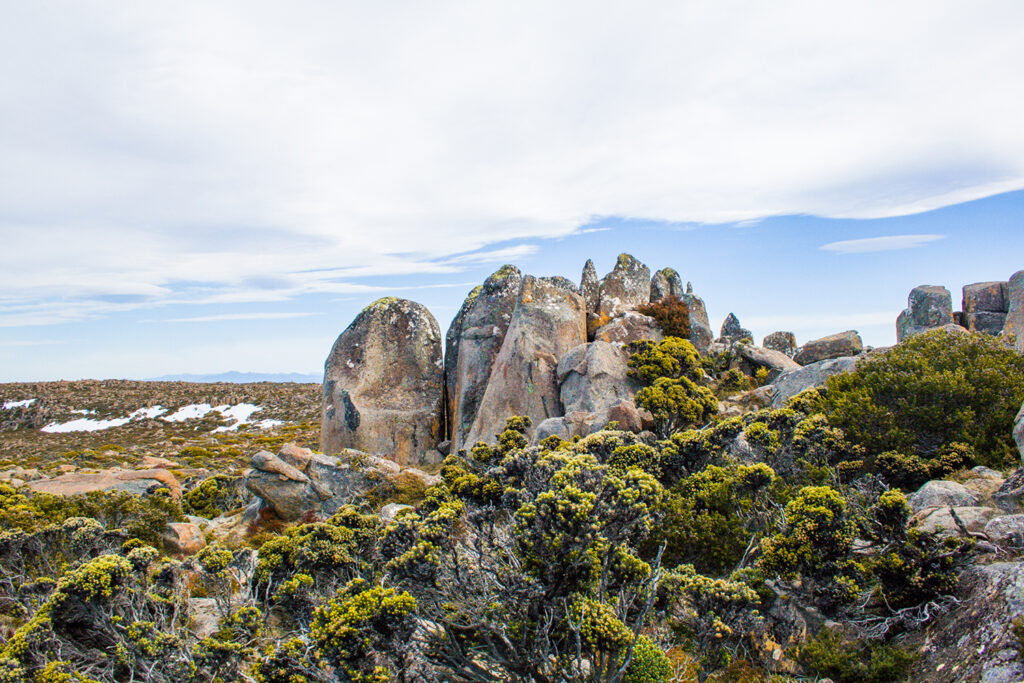
What to Wear?
kunanyi/Mount Wellington rises 1,271 metres (4,170 ft) above sea level. The temperature up here is frequently so cold that the summit is covered in a thin blanket of snow, even in the summer! So be sure to bring a bunch of extra layers to ensure you’re not too cold up here. I thought I had dressed warmly enough but was shocked by the strong winds up here. The wind chill drops the temperature even further! So bring more than you think you’ll need. A puffer jacket is an excellent option since it is so light to carry around in your bag after the tour. A scarf, hat and gloves are also a necessity!
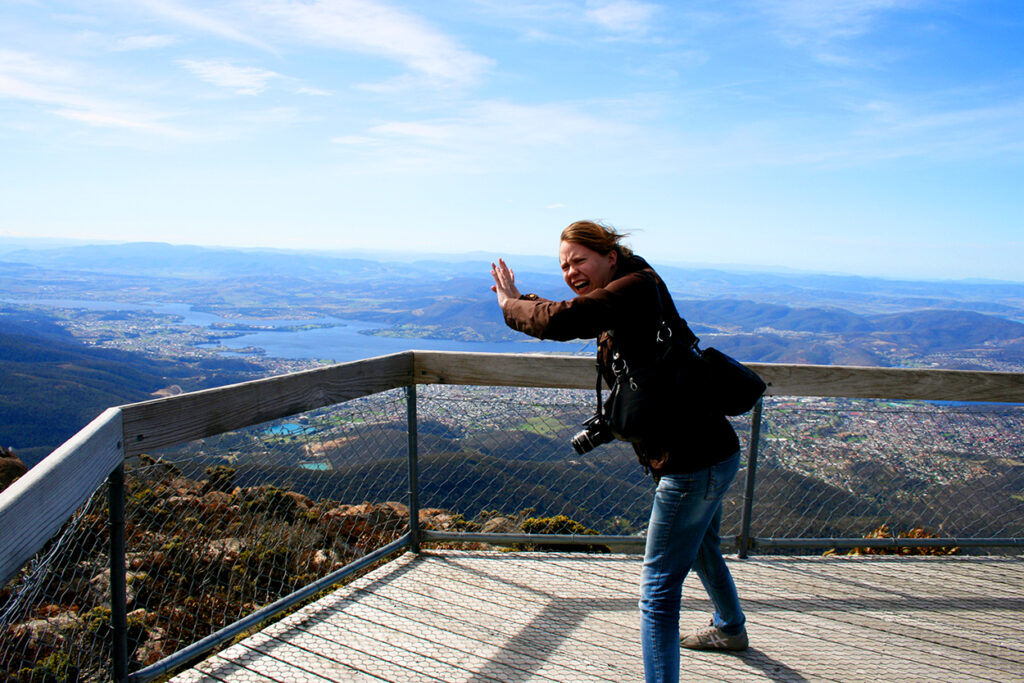
Landscape and Wildlife
As you climb the mountain, look out your window at the incredible landscape. The initial climb is full of lush Eucalypti forests. On either side, you’ll see tiny bursts of water flowing out from the rocks. These ravines, creeks and hidden waterfalls flood the mountain range. The freshwater creates colossal tree ferns that flourish in the moist ground.
The animals that live in these mountains are so diverse! I hadn’t even heard of some of the creatures that live up here. Everything from potoroos, pademelons, quolls, bettongs, and bandicoots! There are also the common possum, bats, echidnas, the elusive platypus, small frogs, reptiles, and of course the alpine lizards. There are also 67 different bird species living in these forests including peregrine falcons, wedge-tailed eagles, swift parrots and grey goshawks.
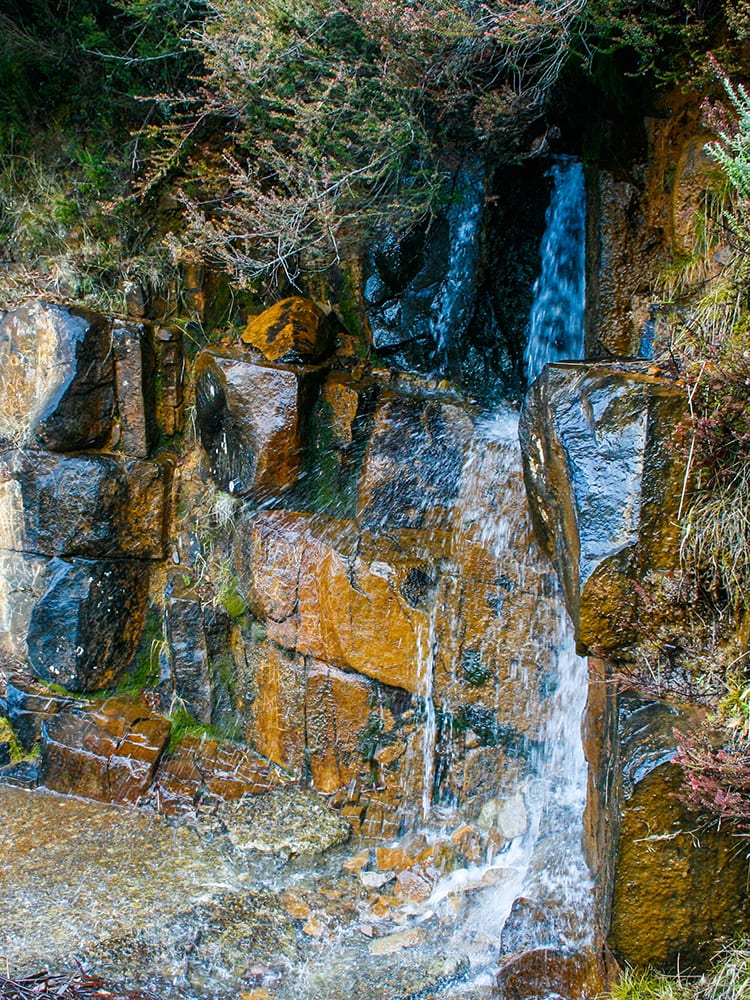
Wellington Pinnacle
When you finally reach the summit, the landscape changes from lush green ferns into flat sandstone cliffs. The sub-alpine flora and glacial rock formations you find on the summit are so unique. It feels like walking on the moon. You might have noticed that anytime I write Mount Wellington I pair it with the word kunanyi. Kunanyi is the proper Palawa name for the mountain. The indigenous Tasmanian people have called it such for thousands of years before the British colonizers’ arrival. In 2014, the mountain’s name was officially changed to kunanyi/Mt Wellington. This was done as part of the Tasmanian Government’s Aboriginal and Dual Naming Policy.
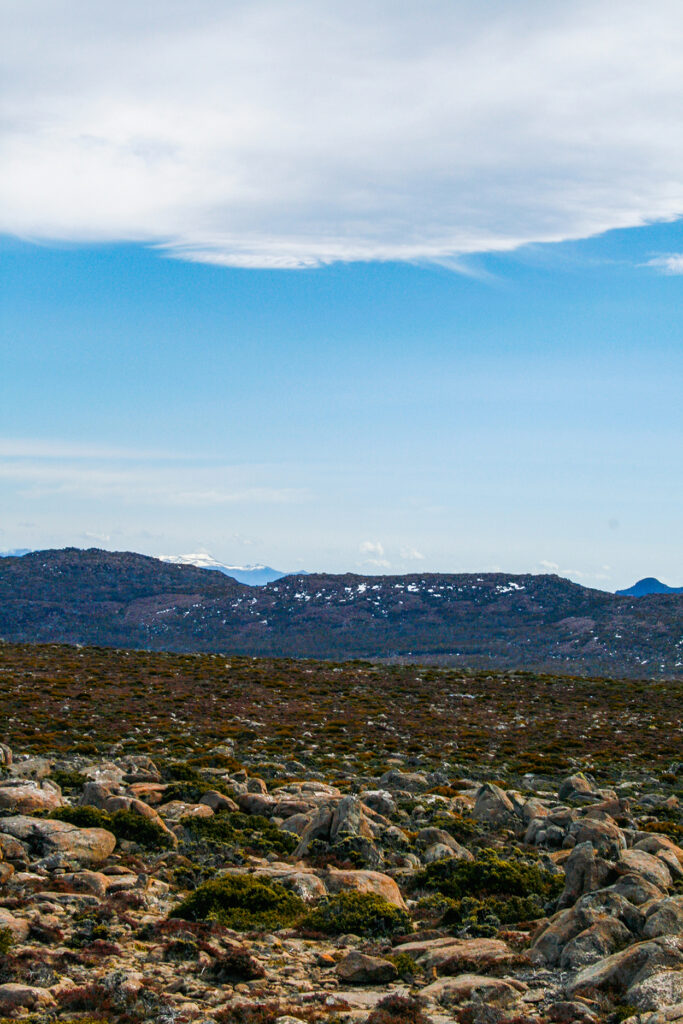
Standing at the top of the summit, you can see the entirety of Hobart, the River Derwent and even the surrounding hillsides spread out across you like a painting. The most iconic aspect of the summit is the igneous rock spread out over the landscape. These were formed by layers of rocks pushing upwards by upsurges of molten rock as the Australian continental shelf violently tore away from the Antarctic. It’s incredible to think how old these rock formations are. This separation from Antarctica happened over 40 million years ago!

Charles Darwin Visits the Mountain
Charles Darwin visited Hobart Town in 1836. He made an effort to climb the mountains and described his journey to the summit.
“The summit of the mountain is broad and flat, and is composed of huge angular masses of naked greenstone… The day was splendidly clear, and we enjoyed a most extensive view; to the north, the country appeared a mass of wooded mountains, of about the same height with that on which we were standing, and with an equally tame outline: to the south the broken land and water, forming many intricate bays, was mapped with clearness before us. …”
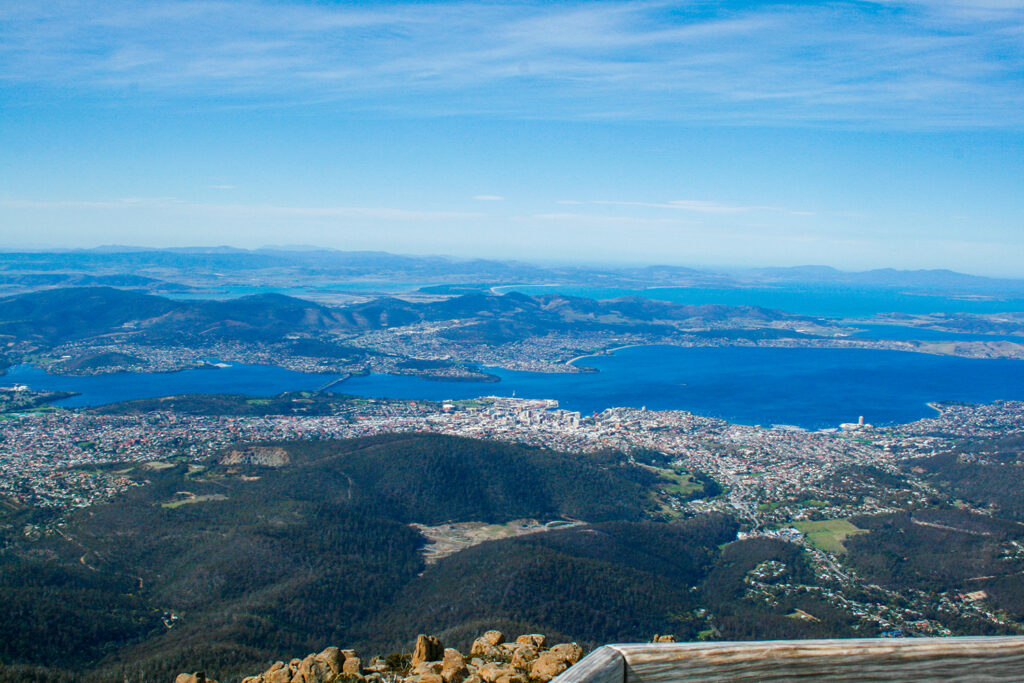
Pinnacle Observation Shelter and Boardwalk
Once you get out of your car or bus at the summit, you can walk along the boardwalk toward the Observation Shelter. The short section of the pathways leading into the Observation Shelter has been made to be wheelchair accessible. Inside the Observation Shelter is a great place to look out at the fantastic views but be protected from the harsh weather as the room is encased in glass.
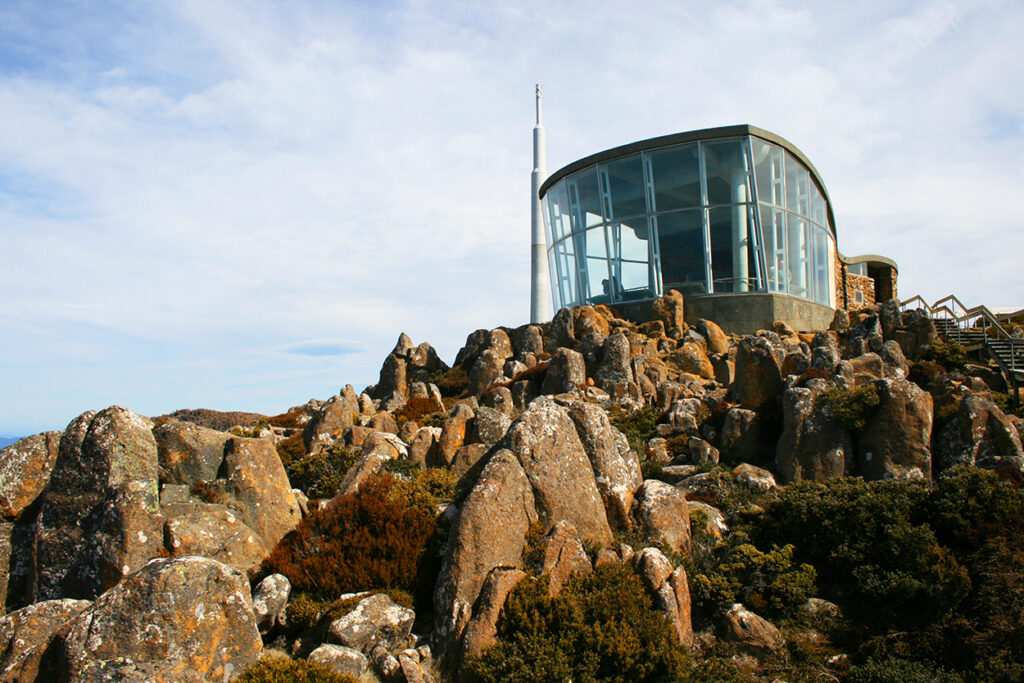
The boardwalk continues one along the cliff edge. A set of stairs leads you towards a view platform that puts you out on the absolute edge of the mountain to get the best views. Continue walking along the boardwalk as the more you explore, the more of the unique landscape you’ll discover!
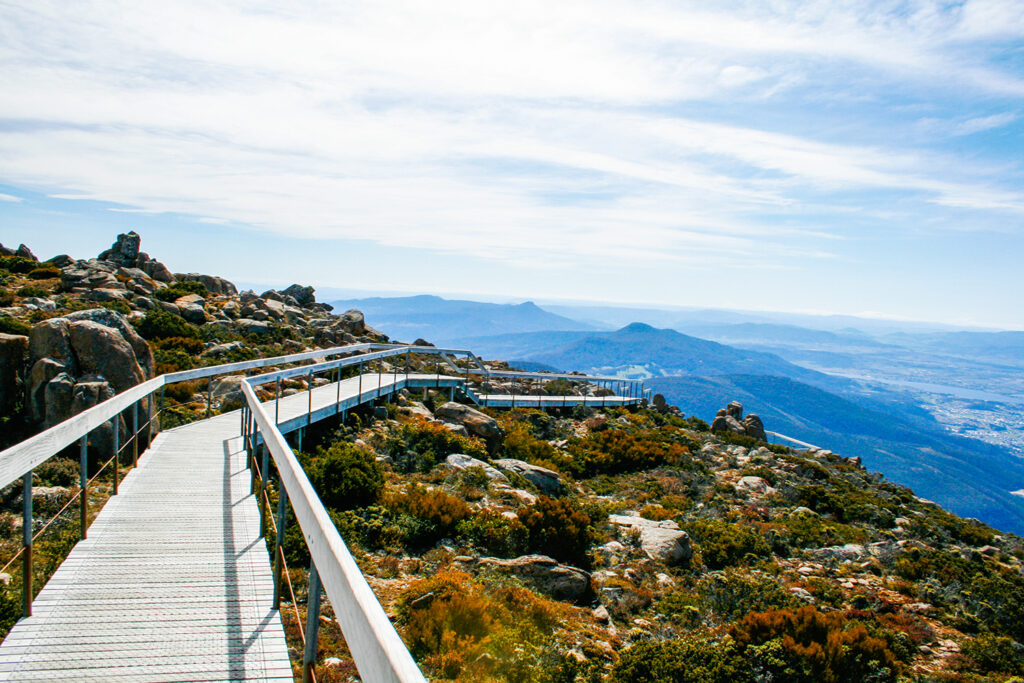
Cascade Brewery
Heading back down the mountain, make your way to the South Hobart neighbourhood. Nestled in these suburbs are a few historical treasures of Hobart’s past. If you are taking the Explorer Bus, you can ask to get off at the Fern Tree Park Stop. From there board the 448 Bus at Fern Tree station towards stop 20, Huon Rd near Hillborough Road. Then it’s a 20-minute walk to the Brewery. Although it sounds like a trek, we loved the winding, scenic walk leading up to the great Brewery!
Walking up Cascade Brewery, the enormous building feels a little ominous. It feels almost out of place, as such tall buildings are scarce to find in Hobart. On the grey, misty morning when we arrived the building looked absolutely haunting! The misty shadow of kunanyi/Mt Wellington silhouetted behind the sandstone facade. But once you get inside, you’ll find a charming brewery serving up some fantastic local beers and ciders. Although you’ll discover that its tumultuous history gives reason for the rather spooky atmosphere here.

History of Cascade Brewery
The history of Cascade Brewery is marred with deception and hints at its convict past. The Cascade Brewery first opened in 1824 and remains the oldest continually operating brewery in Australia. Originally the estates here consisted of large sawmills producing the much-needed timber used in the Hobart shipyards. Shipbuilding was one of Hobart’s largest and most lucrative industries, so the demand for timber was very high. Hobart was an optimal location for shipbuilding as the blue gum trees around the city made for some of the best ship lumber.
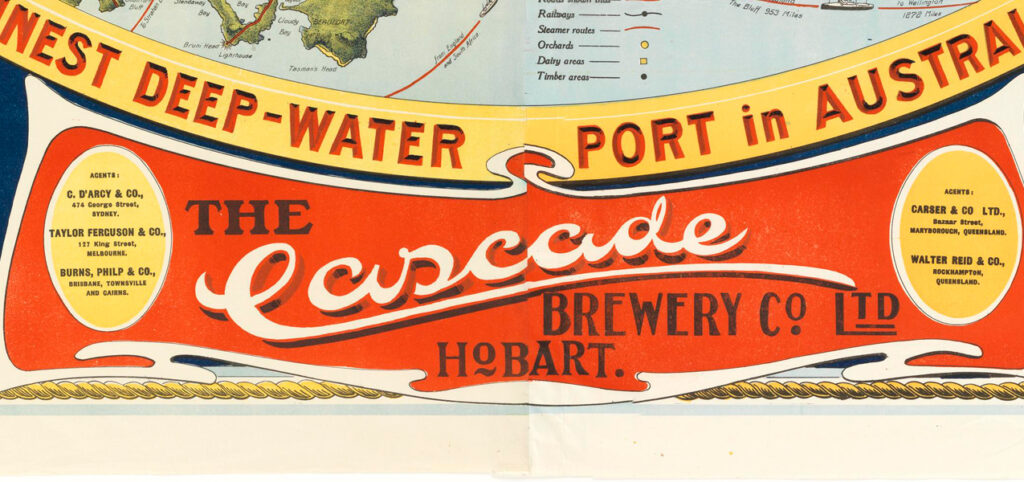
Peter Degraves and Hugh Macintosh
The Cascade Brewery was the brainchild of Peter Degraves and Hugh Macintosh. Until 2011 this was not the commonly accepted truth. It was previously thought that the brewery was founded only by Peter Degraves. Degraves was a cheat and a debtor so it’s no surprise he managed to fool everyone for years that he was the sole creator. Peter came to the shores of Hobart with his brother-in-law Hugh Macintosh in 1824. Degraves had decided to come to Hobart only to escape his charges of thievery in England. But you can’t run from your past forever.
When they arrived, Macintosh wasn’t so keen on the idea of a brewery. But Degraves convinced him to fund it anyway. In 1826, Degraves was arrested for the debts he had in England. He was sentenced to prison for five years in Hobart. Once Degraves was in jail, the kindly Macintosh opted to pay off all Degraves’ outstanding debts. Macintosh abandoned the operation of the brewery and focused his attention on the lucrative sawmills he ran with his nephews.
Once Degraves was let out of prison, Macintosh (for whatever reason) agreed to allow him back into the partnership. Degraves immediately went about expanding the brewery. When Macintosh died in 1834, Degraves offered to buy out the other half of the estate. Macintosh’s sons, who inherited the property, lived far away in India and had no interest in the estate. The sons agreed and transferred the deed to Degraves but, as was the pattern with Degraves, he never paid them. In fact, Degraves went onto falsify the brewery’s history after Macintosh’s death and made it appear as if he was the sole owner.
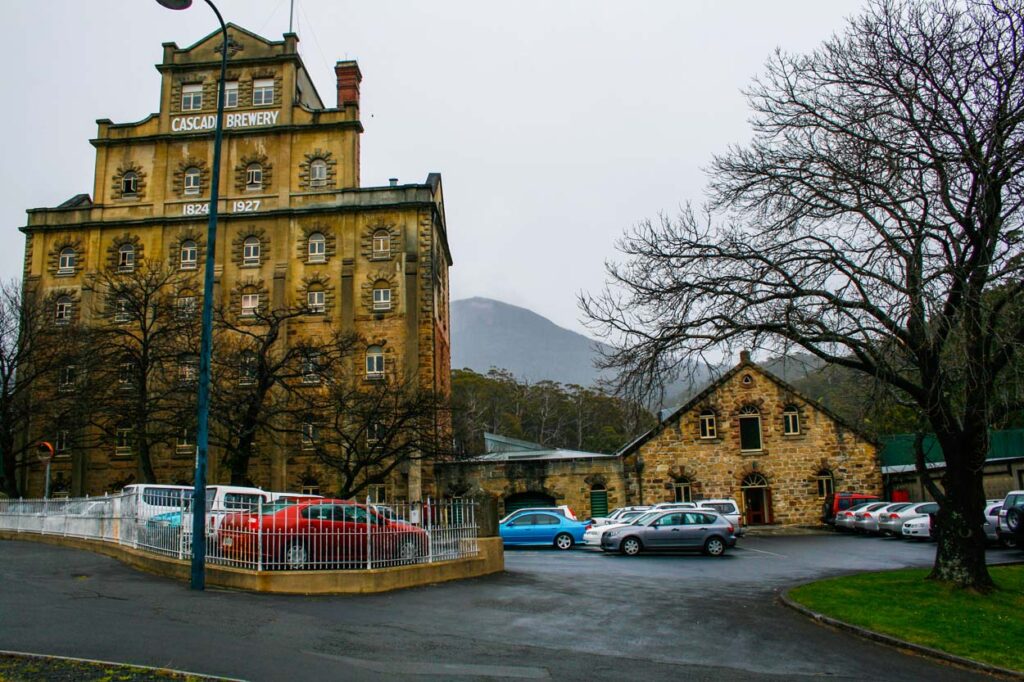
The Gold Rush & Today
Despite his trickery, both the mill and the brewery began to experience a boom of growth, and the money came rolling in. The gold rush in Victoria demanded the import of both timber and beer for the miners. And lucky for Degraves, he could supply both! Eventually, Degraves died and the brewery passed hands a few times. Eventually, the brewery was purchased by Australian subsidiary Carlton & United Breweries, who still own the brewery today. Sadly, a massive bushfire in 1967 destroyed many buildings around South Hobart, the brewery included. Thanks to immense restoration efforts, the entirety of the brewery was rebuilt stone by stone and looks like a replica of the original.
Tasmania Tiger
The original icon of the Cascade Brewing Company is the now extinct Tasmania Tiger or thylacine. The thylacine was the largest carnivorous marsupial native to Tasmania. They called it the Tasmania Tiger as a nickname was the stripes on its lower back resembled that of a tiger. Like the kangaroo, the thylacine also carried its young inside its abdominal pouch. The animal was timid and only about the size of a large dog. Sadly, intensive hunting, shockingly encouraged by state bounties on the animal, contributed to its eventual extinction. New diseases were brought to the country by the English settlers. Their encroachment on the land also led to the thylacine’s disappearance. The last Tasmania tiger died in captivity in 1930. The Tasmanian devil is its closest living relative.
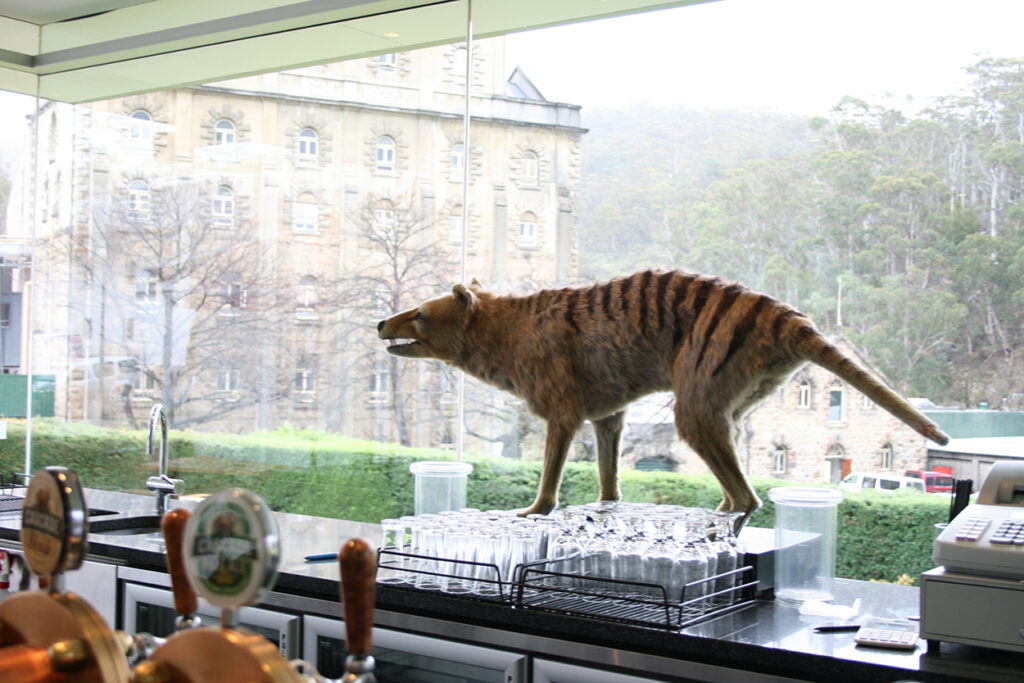
Cascade Brewery Bar
The Cascade Brewery Bar is also a great place to grab a bite to eat and settle in for the evening. Their menu is full of incredible Tasmanian delights. Their taste of ‘Tassie platter’ is a fantastic way to try a bunch of different local items at once. It consists of smoked wallaby, pale ale glazed ham, salmon rillettes, apple relish, pickled vegetables and lavosh bread. And of course, you must try a variety of their different brews. Their tasting paddle comes with four 5oz Cascade beers, a lager, pale ale, first harvest, and a stout. Or if beers aren’t for you, you can try four ciders instead. I adore Australian cider, and Cascade makes ones infused with crushed passionfruit, raspberries, and traditional apples.
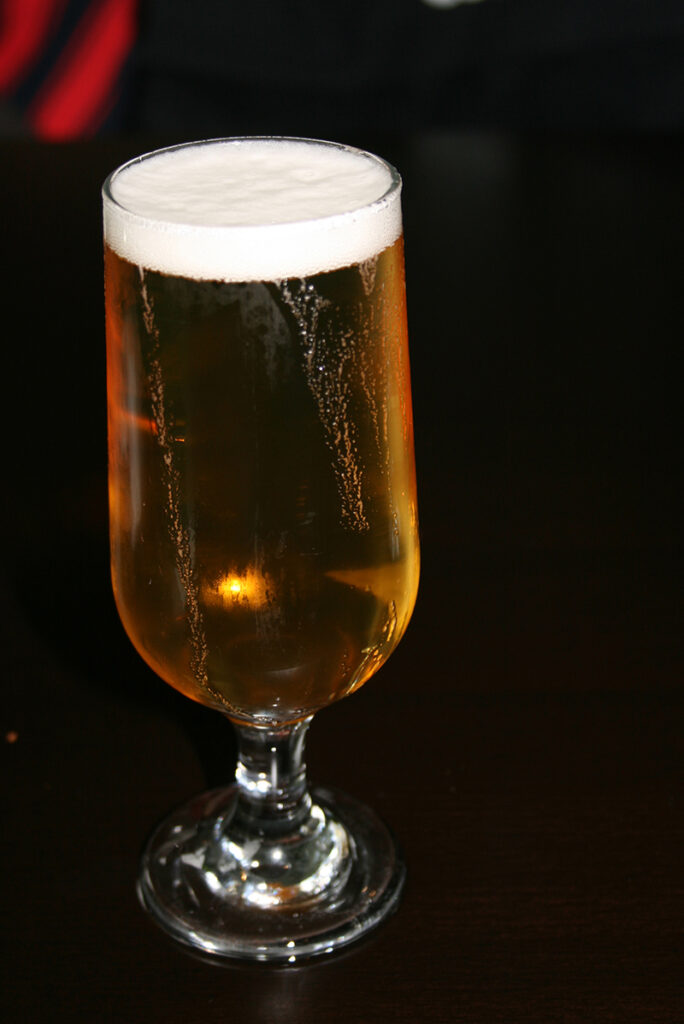
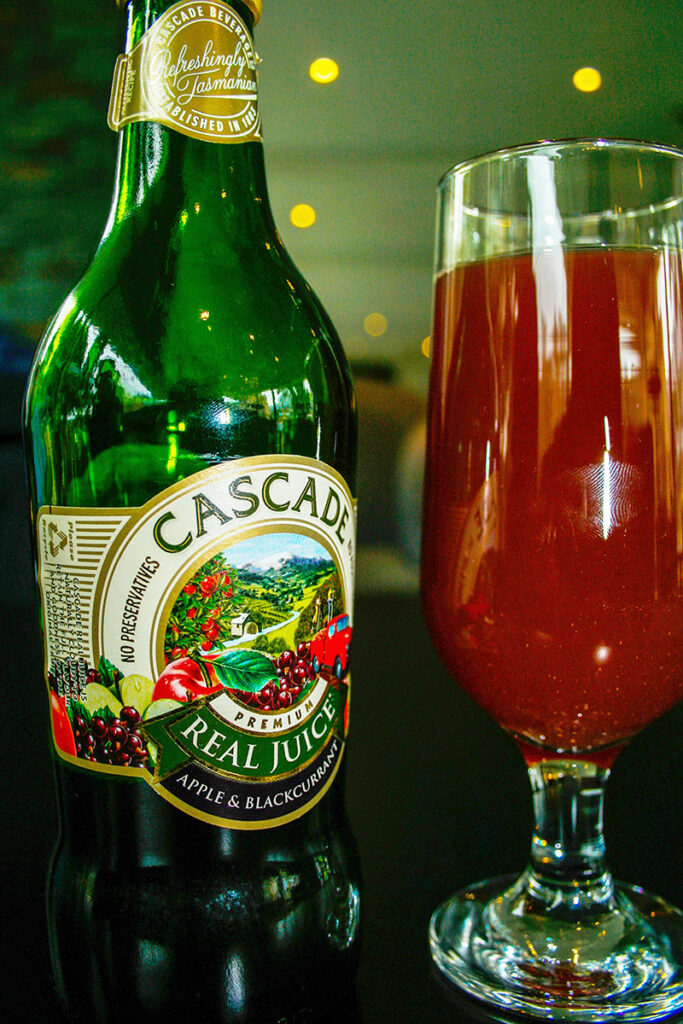
After a night drinking in the shadow of Mount Wellington/kunanyi, it’s time to head home. This brings us to the end of our beautiful journey across Tasmania. I hope you enjoy all the different facets that this wonderful island has to offer. I truly think Tasmania is one of the most spectacular places in the world and CANNOT be missed if you are making the journey all the way over to Australia. Let me know in the comment any questions you might have about Tasmania.
Happy Travels, Adventurers!
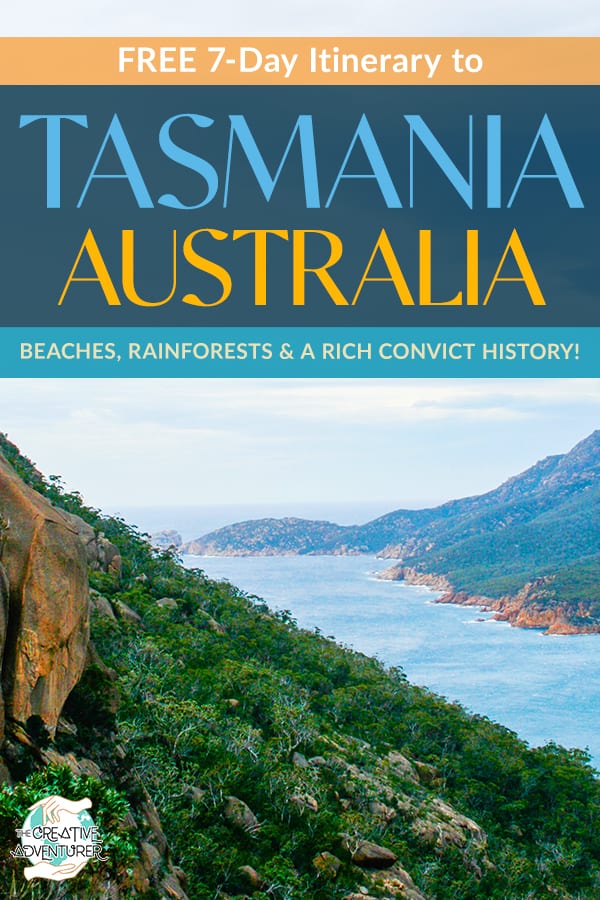
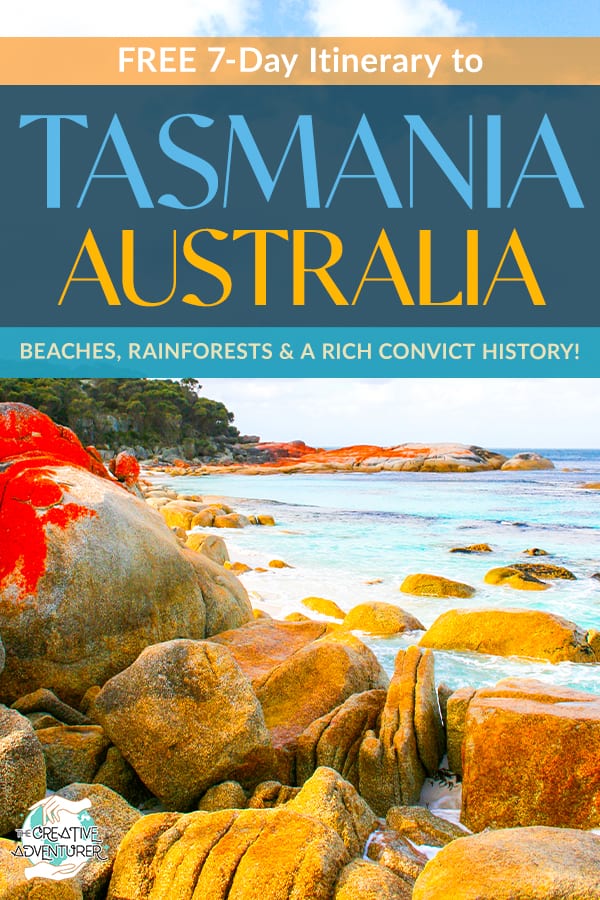
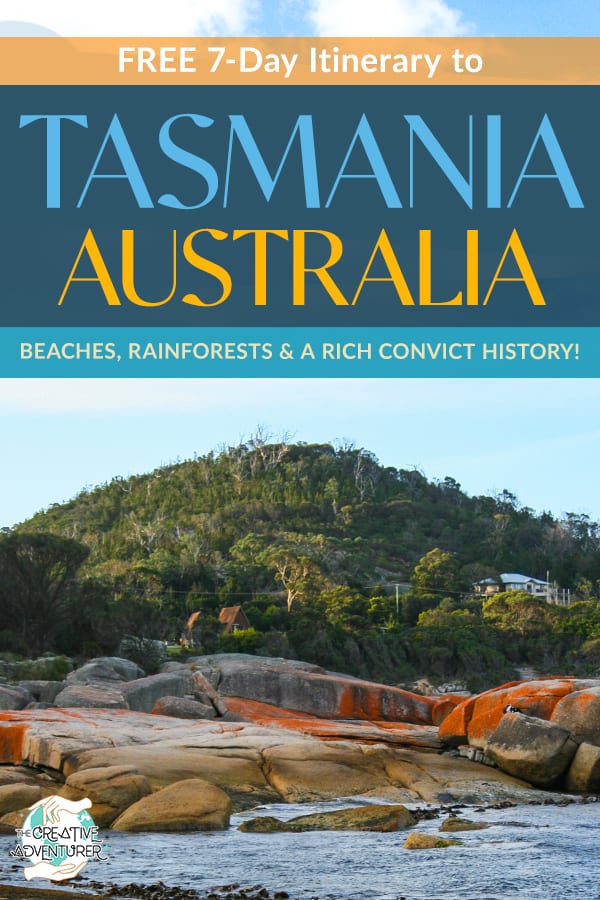
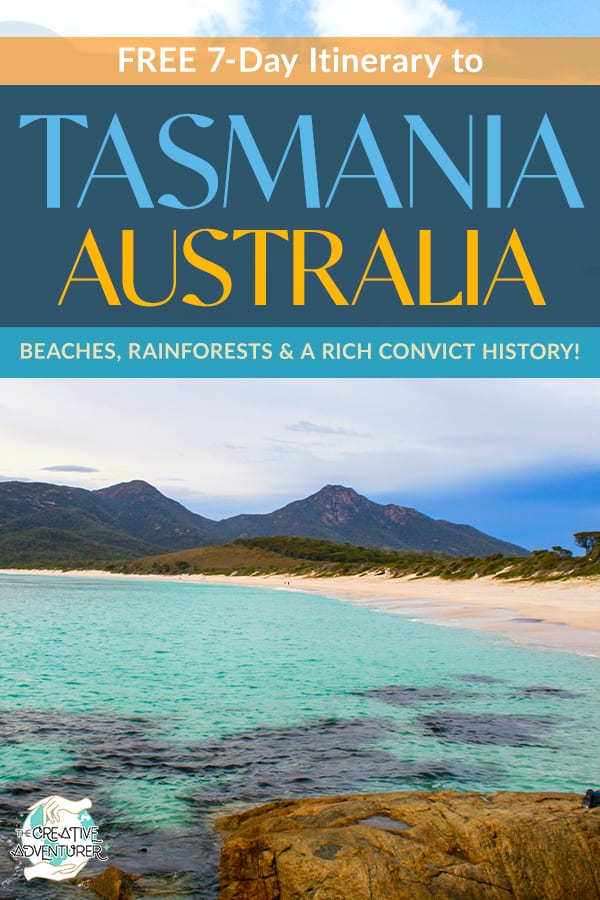
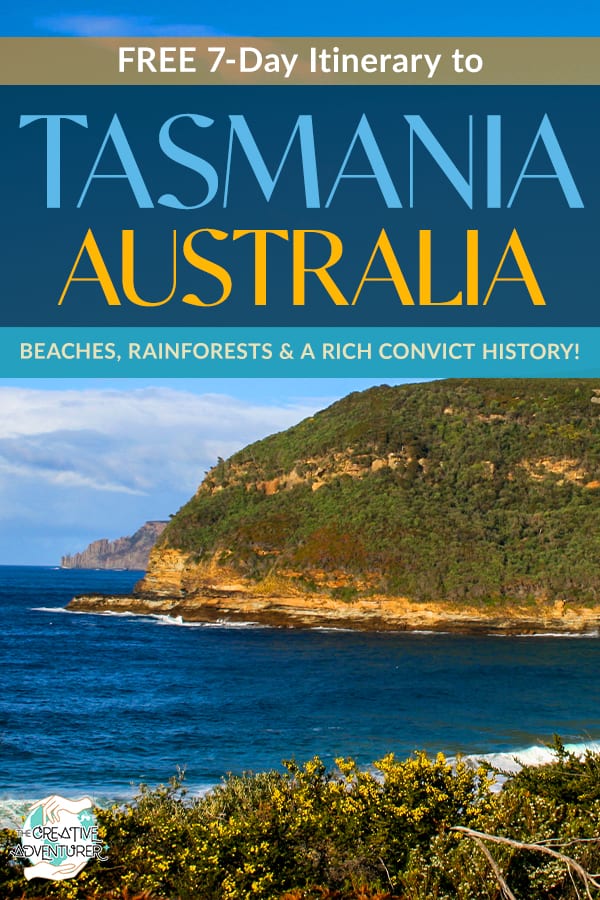
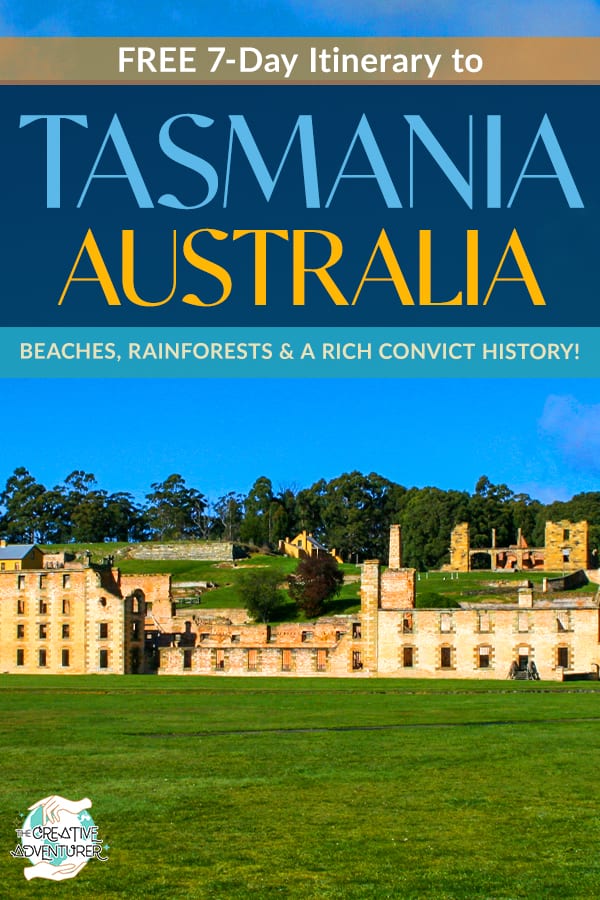
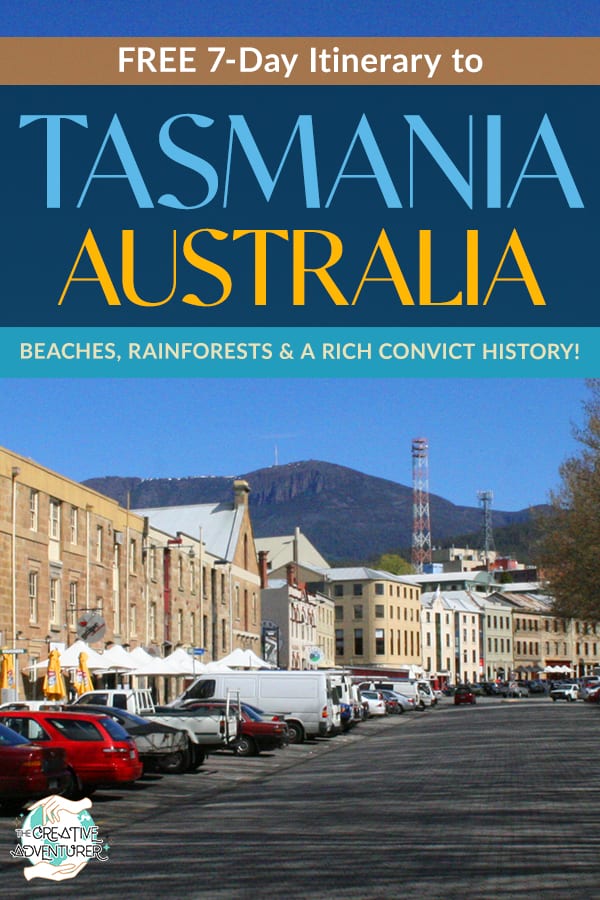
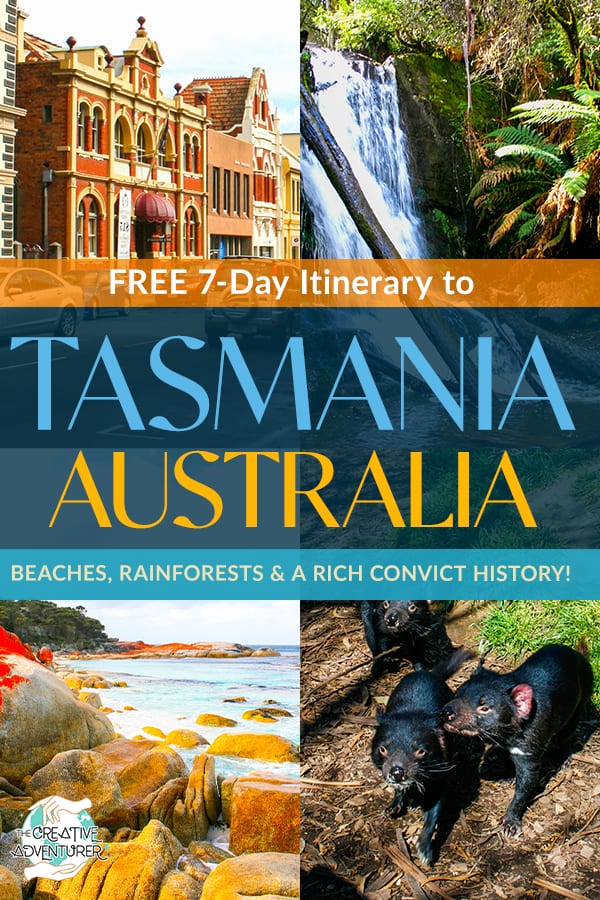


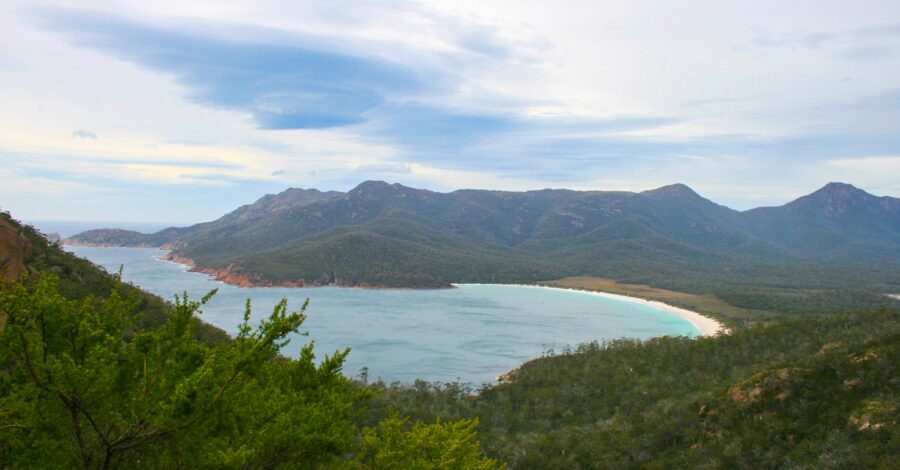
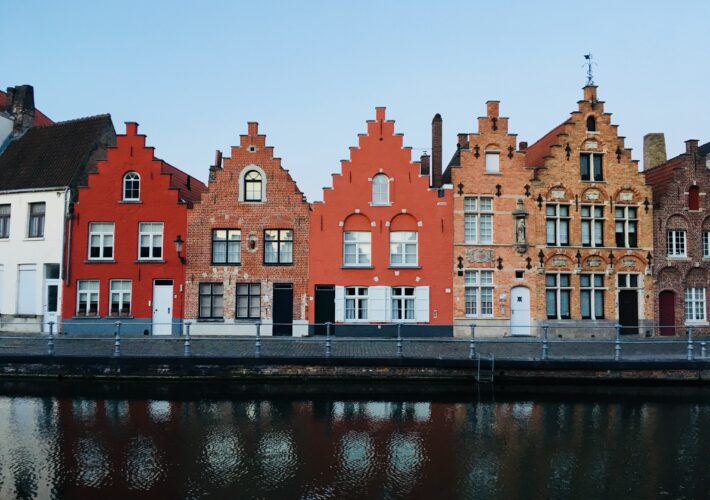
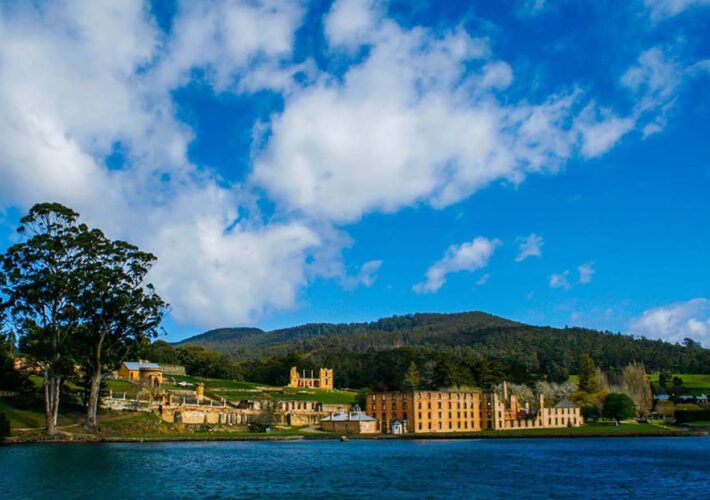
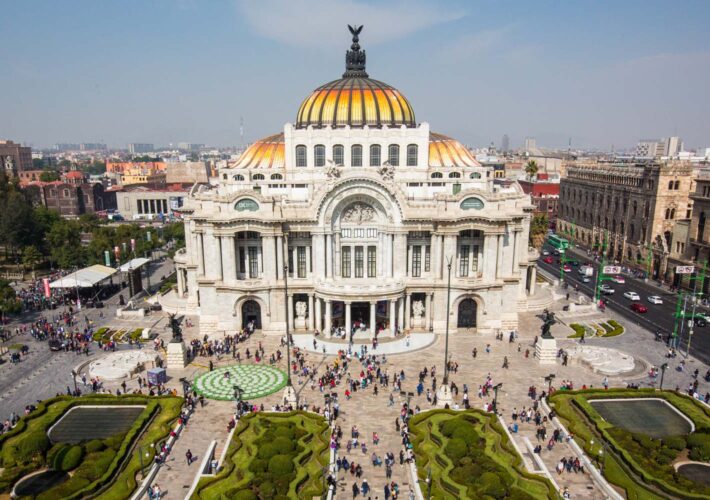
Leave a Comment